サブ・スタンダード船
問題は、多くの組織や国で認識されている。
しかし、日本では
「掛け声だけ」のようだ。船舶代理店も、船主や船舶運航者が
顧客となるため、
サブ・スタンダード船
であっても関係ない態度を取るところもある。生き残るためには見て見ぬふりするしかないかもしれない。SDGs (Sustainable Development Goals)と言っている企業だって、イメージ戦略が目的で良い結果を求めていないケースはあると思う。
やはり、社会的な制裁を与え、
協力するようにするように日本でも努力が必要だ。
日本(海保)のチェックは甘い!
海保は
サブスタンダード船
問題を理解しているのか疑問に思うことさえある。
映画「海猿」のように体を使うことも重要だが、頭を使うことも必要なことを
理解するべきだ。頭がないと不適切な書類や問題がある検査会社が発給する検査で証書を発給する証書を持っている
サブスタンダード船
の問題指摘は無理。悔しいのなら結果で見せてほしい!!!
一部のPSC(外国船舶監督官)を
除けば、日本のPSCの検査は甘い!!
海保はPSCの現状を知っているのか!
サブスタンダード船排除 (社団法人日本船主協会のホームページより)
と書かれているが、日本の多くの企業が
サブスタンダード船
を理解していないのが現実だ。
また、日本の造船所の中にも、
サブ・スタンダード船
の排除に非協力的態度を見せている造船所も存在する。
荷主や船主も、
サブ・スタンダード船
に係わっているところがある。また、
検査会社
、船主、及び造船所の癒着もある。
カネボウ事件の中央青山監査法人
や
三菱ふそうトラック・バスの子会社で荷台部分のメーカー「パブコ」による
最大積載量を水増し不正車検
を考えれば理解できるであろう。やはり顧客確保や利益を考えると、いけないことと分かっていても
問題は起きる。これらの結果が、
サブ・スタンダード船
になる理由である。
あなたの近くの港での外国籍船の検査 2005年11月号(IAPH 国際港湾協会)
開けない人はここをクリック
上記は建前の記事であって2018年の現在でも「PSC検査官の努力だけでサブスタンダード船舶を排除することが不可能なことは明らかであり、
旗国政府、船主、海運業者、港湾を含む全ての海事関係者の協力及び支援が必要なのである。」に関して協力や支援は理解されていないし、
たくさんの問題があると思う。
最先端経営とクオリティシッピング(日本海事新聞)に「世界の海には
サブ・スタンダード船
がうようよしている。
いや船が
サブ・スタンダード船
なのではない。船を所有する者、運航する者、そして
海上輸送サービスを利用する者が
サブ・シッピング
なのだ。」と書かれています。
ピンポイントで現状を把握していると思います。
ISMコード(国際安全管理コード)
6.1 会社は、船長が次の要件を満たすことを確保しなければならない。
.1 船舶を指揮するための適切な資格を有すること
.2 会社の安全管理システムに十分精通していること
.3 職務を支障なく遂行できるように必要な支援を受けられること
6.2 会社は、各船舶に、旗国及び国際的要件に従った免状、資格を有し、か
つ、身体適正な者を配乗することを確実にしなければならない。
6.3 会社は、新たな要員及び安全と環境保護に関する職務に新たに配置転換さ
れた者が、その職務に習熟することを確実にする手順を確立しなければなら
ない。また航海前に示されるべき重要な指示は、明確にし、文書化されて出
航前に乗組員に供与しなければならない。
今後必要とされる自己防止策の「(2) 船長は、適法で有効な海技免許を有する職員を船橋当直につかせて適切な船
橋当直体制を維持すること。」は既にISMコード(国際安全管理コード)
で要求されている基本的なこと。つまり、ISMコード(国際安全管理コード)
の要求を守る事と言えば良いだけのこと。また、ISMコード(国際安全管理コード)
は新しい規則ではない。PSC(外国船舶監督官)の検査で指摘されない事が不思議。
普通の事が出来ない船はISMコード(国際安全管理コード)の不備として指摘、又は、
出港停止命令を受けるのが当然。
 フィリピンでの船舶による油流出事故ではISOの認定を受けていた検査会社の不正やフィリピン沿岸警備隊職員の汚職疑惑が表に出た。船齢が1年の船が実は船齢50年以上で建造された日から6か月間に4回もフィリピン沿岸警備隊職員よる検査を受けたにも関わらず、船が沈没して大規模な油汚染が発生するまで、問題ははっかくしなかった。システムが存在してもシステムが機能しなければ、不正は可能であることが部分的に証明されたケースだと思う。
フィリピンでの船舶による油流出事故ではISOの認定を受けていた検査会社の不正やフィリピン沿岸警備隊職員の汚職疑惑が表に出た。船齢が1年の船が実は船齢50年以上で建造された日から6か月間に4回もフィリピン沿岸警備隊職員よる検査を受けたにも関わらず、船が沈没して大規模な油汚染が発生するまで、問題ははっかくしなかった。システムが存在してもシステムが機能しなければ、不正は可能であることが部分的に証明されたケースだと思う。
地中海で運航されているクック諸島船籍、  パラオ籍船、
パラオ籍船、 シエラレオネ籍船、
シエラレオネ籍船、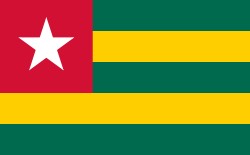 トーゴ籍船に登録されている船舶をターゲットにして船舶検査が行われるそうだ。これらの国籍の海運局は船主からお金さえ受け取れば、他の国籍の海運局が受け入れない船でも登録すると書かれている。これらの船籍船舶は危険で運航されるべきでないITFコーディネーターは言っている。データによると2年間でこれらの船籍に登録された100隻以上の船が放置されたそうだ。
トーゴ籍船に登録されている船舶をターゲットにして船舶検査が行われるそうだ。これらの国籍の海運局は船主からお金さえ受け取れば、他の国籍の海運局が受け入れない船でも登録すると書かれている。これらの船籍船舶は危険で運航されるべきでないITFコーディネーターは言っている。データによると2年間でこれらの船籍に登録された100隻以上の船が放置されたそうだ。
日本だと シエラレオネ籍船、
シエラレオネ籍船、 トーゴ籍船に登録されている船舶が日本に頻繁に入港している。個人的には問題のある船は多いと思うが、
残念ながら日本のPSC(国土交通省職員)の検査は厳しくないので、出港停止命令はあまり受けないのが現状だと思う。
トーゴ籍船に登録されている船舶が日本に頻繁に入港している。個人的には問題のある船は多いと思うが、
残念ながら日本のPSC(国土交通省職員)の検査は厳しくないので、出港停止命令はあまり受けないのが現状だと思う。
Trump administration chases substandard flags in bid to thwart Iran’s shadow fleet 04/17/25 (Splash)
Sam Chambers
The latest American sanctions aimed at Iran’s oil industry make specific warnings to shipping about the use of substandard shipping.
The Department of the Treasury’s Office of Foreign Assets Control (OFAC) yesterday designated a China-based independent teapot refinery, Shandong Shengxing Chemical, for its role in purchasing more than $1bn worth of Iranian crude oil, as well as imposing additional sanctions on several companies and vessels responsible for facilitating Iranian oil shipments to China as part of Iran’s shadow fleet.
“Any refinery, company, or broker that chooses to purchase Iranian oil or facilitate Iran’s oil trade places itself at serious risk,” said secretary of the treasury Scott Bessent. “The United States is committed to disrupting all actors providing support to Iran’s oil supply chain, which the regime uses to support its terrorist proxies and partners.”
This also marks the sixth round of sanctions targeting Iranian oil sales since president Donald Trump issued National Security Presidential Memorandum 2 (NSPM-2), instituting a campaign of maximum economic pressure on Iran.
Newly sanctioned vessels include the Nyantara, Reston, Bestla, Egret and Rani.
OFAC also issued an updated sanctions advisory to assist the global shipping and maritime industry in identifying sanctions evasion practices related to the shipment of Iranian-origin fuel products while targeting known Asian insurers of shadow fleet vessels.
Shadow fleet tankers rely on flag registries with lower operating and due diligence standards, OFAC warned yesterday, in advice that covered the rise of false-flagged ships and fraudulent registries.
“When vessels are registered by jurisdictions known to service shadow fleet vessels or have flown multiple flags in an uncommonly short period of time (e.g., three flag registration changes within a year’s time), maritime stakeholders, including charterers, shipbrokers, insurers and port agents and operators, should request additional documentation on the vessel’s ownership, voyage history, and flag history,” OFAC advised. This may include utilising publicly available resources, such as the IMO’s Global Integrated Shipping Information (GISIS) database, to determine if a vessel is flying a false or unknown flag.
In his first term, Trump withdrew the US from the Iran nuclear deal and reimposed a full embargo on Iran’s crude oil exports in 2019. As a result, Iran’s crude oil shipments collapsed from 2.5m barrels per day in the first half of 2018 to 250,000 barrels per day. During the Biden administration, sanctions were not as strictly enforced, and Iranian exports gradually recovered. In the opening months of Trump’s return to power, there have been many new sanctions packages aimed at Iran’s shadow fleet as well as Iran’s ties to the Houthis in Yemen.
IMO takes action on seafarers’ rights, substandard shipping 04/04/25 (IMO)
Legal Committee adopts guidelines on fair treatment of seafarers detained in connection with alleged crimes; launches work on substandard The International Maritime Organization (IMO) has adopted crucial new guidelines to protect seafarers from unfair treatment when detained in foreign jurisdictions in connection with alleged crimes committed at sea.
The guidelines, adopted by the Legal Committee during its meeting in London from 24 to 28 March, aim to protect seafarers’ rights and ensure they are treated with fairness and dignity, no matter where they are in the world.
IMO Secretary-General Mr. Arsenio Dominguez stated: “Unfortunately, incidents of unjust treatment of seafarers are on the rise, posing a significant challenge to the sustainability of shipping. These cases not only undermine seafarers' morale but also discourage young talent from pursuing a career at sea.”
He said the guidelines “will add a significant value in resolving the challenges faced by seafarers and ensure that seafarers are treated fairly."
Key aspects of the guidelines relate to due process, protection from arbitrary detention, coercion or intimidation, and ensuring that wages, medical care and repatriation rights should remain intact during any legal proceedings. The guidelines aim to improve coordination among countries, including port States, flag States, coastal States, States of which the seafarer is a national, shipowners, as well as seafarers.
The text was developed and first adopted in December 2024 by a Joint Tripartite Working Group with the International Labour Organization (ILO), which includes representation from governments, shipowners and seafarers.
Alarming increase in seafarer abandonment
The Legal Committee called for urgent action to tackle the sharp rise in seafarer abandonment cases, where shipowners fail to repatriate crew, pay wages, or provide basic necessities.
According to the IMO/ILO joint database on abandonment of seafarers, 310 new cases were reported in 2024 - more than double the 142 cases recorded in 2023. The trend continues in 2025, with 63 cases already reported in the first two months. The Committee urged Member States to report abandonment cases occurring in their ports or involving their flagged vessels and nationals; and improve the accuracy of these reports.
Member States were urged to update national contact points for handling cases, implement existing Guidelines on how to deal with seafarer abandonment cases, and raise awareness among seafarers about financial security protections.
The Committee welcomed the ongoing work by the Task Force coordinated by the International Chamber of Shipping (ICS) to review and update the ILO/IMO Joint abandonment database. Member States are encouraged to work with the Task Force to improve the database further.
Tackling substandard shipping
The Committee discussed the need to address substandard shipping, given the rise of unlawful operations which distort the global playing field, increase risks to safety, security and the environment.
The Committee approved the proposal to conduct a regulatory scoping exercise to review IMO conventions and other tools available to Member States, with the aim of developing actions to prevent unlawful operations, including substandard shipping.
A correspondence group will be set up to start working on this new output, following approval of its terms of reference by the IMO Council in July 2025.
Other key issues
The Legal Committee will also be working on three other outputs over the coming year, including:
Development of guidelines or best practices for the registration of ships for the benefit of safety, protection of the marine environment and the well-being of seafarers;
Suitability of IMO liability and compensation regimes with respect to alternative fuels; and
Measures to address maritime security threats.
Vessels registered to the Cook Islands, Palau, Sierra Leone and Togo targeted in Med substandard shipping crackdown 03/17/23 (Splash.247.com)
Sam Chambers
Up to 1,000 ships flagged to the Cook Islands, Palau, Sierra Leone, and Togo will be targeted for safety, maintenance and seafarer welfare inspections across the Mediterranean Sea in the coming eight weeks by an army of inspectors from the International Transport Workers’ Federation (ITF), seafarers’ unions and port authorities.
“Substandard shipping in the Mediterranean Sea is driving down seafarers’ wages and conditions, it’s endangering the lives of crew and risking our environment,” said ITF inspectorate coordinator Steve Trowsdale.
“These flags take money from shipowners to register ships that other countries wouldn’t touch. Many are old vessels and are poorly maintained by their owners. Many of these ships are dangerous and should not be trading,” he said.
The blitz comes off the back of new analysis showing the four flags of convenience registries together accounted for more than 100 crew abandoned in the last two years, with millions of dollars wages not paid to crew by the flags’ shipowners that the ITF then had to recover on seafarers’ behalf.
The ITF inspectors’ efforts will be bolstered in France by the country’s Port State Control agencies, which are organised regionally.
Leading the Way: Flag Registries Up Their Game 10/01/23 (The Maritime Executive)
BY ALLAN E. JORDAN
Shipping is in transition with emerging regulations, the drive for decarbonization and geopolitical issues all increasing the pressure on both ship registries and classification societies. The pandemic impacted the business by driving up cargo volumes and demand for containerships. More recently, the war in Ukraine and implementation of sanctions impacted dry bulk, tanker and gas carrier usage.
All of this comes as shipowners and operators had to deal with increasing financial pressures and a growing shortage of qualified merchant sailors.
Responding to these issues, ship registries (flag states) are rethinking their role and how they work with owners. While finding themselves challenged as more shadowy operators seek to skirt regulations, flags – like class societies – are becoming more like advisors to the industry. They’ve also had to incorporate new technologies to address trends such as digitalization as they change the way they do business.
Sanctions & Flag-Hopping
Increased sanctions over the past two years have placed a growing burden on registries. Flags and class societies alike have responded by increasing the number of ships and operators they’ve suspended and removed from their ranks. All the flags are also reporting that they’ve increased their vetting efforts to stop “flag hopping” and other deceitful practices.
Coming under pressure to address sanction busters, the Panama Maritime Authority – which for many years has been the largest registry – says it’s canceled more than 6.5 million gross tons since 2021 for issues related to Iran and North Korea or vessels included on the lists of international sanctions.
In an effort to stop operators or ships from hopping between flags, Panama together with two of the other leading international flags, the Liberian Registry (LISCR) and the Marshall Islands Registry (RMI), has had an agreement since 2019 for the exchange of information. It helps them identify ships being removed from a registry and seeking replacement flags.
The vetting of ships and their operators has also taken on new importance. The Liberian Registry, for example, which has grown rapidly to rival Panama, has taken significant steps to enhance its capabilities by collaborating with outsourced services to strengthen its ability to access accurate and up-to-date information. The Cayman Registry, a leader in yachting, is only accepting registrations from individuals or companies located in jurisdictions with stringent fiscal and anti-money laundering regulations.
Rise in Detentions
Financial challenges created by shifting markets and supply chains are further increasing the pressure on ship operators. Flags believe this has led to the increase in abandonments and lax compliance by some marginal operators with the Maritime Labor Convention, maintenance and safety regulations. The Paris MoU, one of the largest port state control authorities, reports that detentions were at their highest rate in 10 years in 2022.
Ship quality issues and the rise in detentions have also seen flags slip from the top-level White List to the more audited Grey List.
Authorities like the Australian Maritime Safety Authority have increased their enforcement efforts. AMSA, for example, reports that so far in 2023 it’s issued bans on five ships and has 18 operators under monitoring programs due to a history of deficiencies. Even a private organization, the International Transport Workers Federation (ITF), announced in March an eight-week surge in inspections seeking to root out safety, maintenance and seafarer welfare failings.
The Korean Registry (KR) believes the number of inspections has returned to pre-pandemic levels, contributing to the global increase in detentions. The Liberian Registry highlights “the lack of standardization among Port State Control inspections and the detainable items and what can be rectified before departure.”
Additional factors include the overall growth in the size of the global fleet as well as the increasing average age of vessels. Because of the size of its registry, Panama’s more than 8,500 ships receive more than 14,000 inspections annually. Panama concedes that, while it’s been effective at attracting over 1,500 new ships to the registry in the past four years, the age of its legacy fleet contributes to detentions. More than a third of the ships registered in Panama detained in the Paris MoU in 2022 were more than 30 years old with 35 of them more than 40 years old.
“Tidying up” has become a key issue for the Panama Maritime Authority. Since 2021, it’s begun efforts to actively purge the registry of the oldest ships and ones that do not follow best practices. Panama has also introduced pre-inspections and other steps for vessels calling in the U.S. to ensure compliance, especially for ships that might – because of their past history – be targets for USCG Port State Control inspections.
These steps were introduced as the PMA for the first time entered the U.S. Coast Guard’s Qualship 21 program, a milestone for the flag administration.
Other flags, including the Marshall Islands, say they’ve also increased their vetting considering issues like age with RMI highlighting its pre-registration inspections and 19 consecutive years of participation in the Qualship 21 program.
Many have introduced new tools to help owners prepare with the Korean Register offering a new app that provides real-time information designed to reduce the risk of PSC detentions. Liberia has a Dynamic Prevention Program that, among other capabilities, automatically generates notices with a risk assessment when destinations are entered into a ship’s AIS system.
These efforts are not exclusive to the largest flags. Cayman provides support before, during and after PSC inspections and has a Fleet Quality Management system.
Environmental Issues
The Liberian International Ship & Corporate Registry (LISCR), which administers its flag, calls decarbonization and growing environmental regulations “probably the most contentious issues” for the shipping industry.
The IMO’s Carbon Intensity Indicator (CII) and the Energy Efficiency Existing Ship Index (EEXI) have each gone into effect and are expected to have significant financial consequences for operators. The IMO’s Marine Environment Protection Committee also recently adopted a dramatic acceleration in the industry’s decarbonization timeline.
“There’s a lot going on behind the scenes on the environmental/emissions fronts,” notes LISCR. Flags and class societies are actively working with organizations including shipbuilders to develop new vessel technologies. Liberia, for example, is in partnership with Lloyd’s Register on a project to develop a large multi-gas carrier while KR is working on projects including a liquefied CO2 carrier and methanol-fueled tanker designs.
“Palau International Ship Registry is making significant strides in promoting green shipping practices,” says the registry. It points to programs such as a Blue Certificate to recognize clients who comply with environmental regulatory regimes and also donates $5 to the Palau Marine Sanctuary for every invoice issued, demonstrating a commitment to the marine environment. Panama highlights its efforts in promoting the construction of eco-friendly ships.
The time has come, says the Marshall Islands, for owners and operators to determine their path forward to decarbonization. As owners access and implement their approach, flags are working to provide increasing levels of technical support and guidance. The Marshall Islands has launched a Gas and Renewables team to help reduce the risk of regulatory “surprises.” Cayman says it understands the difficulties its clients are encountering as a result of the uncertainties surrounding alternative fuels and has launched new efforts to assist.
The IMO’s regulations are not without controversy, and flags are taking an active role in representing clients’ concerns to the IMO. Palau, for example, supports the IMO’s CII and EEXI initiatives but “believes that the IMO should address industry concerns and collaborate with stakeholders to develop a more comprehensive and adaptable system.” The Cayman Registry is helping clients “ensure that any unintended consequences of GHG emissions from EEXI implementation are addressed at the IMO before 2026.”
“Owners need qualified and experienced partners as they navigate the decarbonization challenge as well as an intimate understanding of the direction of the regulatory discussions,” says the Marshall Islands Registry.
New Technology
In the wake of COVID and emerging environmental regulations, efforts are growing to adopt new ways of operating and, for example, reduce dependence on physical documents. Panama, for example, is overhauling its model and working with legislators to modernize and streamline administration of the flag.
A big part of the effort is the adoption of new technology. Panama’s upgraded systems provide new automatic notifications, minimize the requirement and handling of physical documents and allow users to make inquiries. Similarly, Liberia has a popular Duty Officer Video Call feature that permits shipowners to get live video support and share documents in real time.
“The biggest challenge facing all classification societies is how to best harness the power of digitalization,” says KR, noting its use in driving decarbonization. It adds that 22 percent of its Busan headquarters workforce is dedicated to R&D dealing with new technologies. KR is developing remote survey technologies and plans to launch an integrated digital service platform in 2023 as well as a data exchange system.
One of the biggest challenges involves technology getting ahead of regulations. An example is autonomous navigation where KR is working with HD Hyundai and its subsidiary Avikus on autonomous navigation technologies and how to integrate them into future operations. Marshall Islands has also invested in building strong technical teams with experience in emerging new solutions.
Leading the Way
Owners need qualified and experienced partners as they navigate the growing challenges and coming transitions in ship operations. Ship registries are working to fill this role along with class societies. Understanding and anticipating the regulatory direction will be critical going forward, and that’s where the registries can lead the way.
Allan Jordan is Associate Editor of The Maritime Executive.
貨物船JIA HUI貨物船第十八栄福丸衝突 11/26/15 (運輸安全委員会)
船舶事故調査報告書
参考資料
説明資料 (運輸安全委員会)
再発防止策
・・・
船長は、適法で有効な海技免許を有していない乗組員を職員として船
橋当直につかせてはならない。
・・・
今後必要とされる事故防止策
船長及び船橋当直者は、次の事項について徹底する必要がある。
(1) 船橋当直者は、船首方に船舶を認めた際、方位変化の観察、レーダープロッティング等を行うなど、見張りを適切に行うこと。
(2) 船長は、適法で有効な海技免許を有する職員を船橋当直につかせて適切な船橋当直体制を維持すること。
(3) 船橋当直者は、船舶と接近し、相手船の動作に疑問をもったときは、直ちに警告信号を行うとともに適切な時機に衝突を避ける動作をとること。
「事故当時、ジィア・フイを操船していた当直責任者の中国人男性(37)は、中国近海を航行する免許しか持っておらず、中国の運航会社との連絡や物品購入を担当する「実習生」として乗り組んでいたことも明らかにした。」
運輸安全委員会は上記を事実として信じるのか?
外国で操船することはできない船員資格しか所持していない船員が乗っている外国籍船は存在する。
韓国のPSCは2007年1月5日にパナマ籍船舶「RUI YANG」号を船員の免状 「Captain, chief engineer, 2nd officer & 1st engineer's licence not applicable for world wide trade. (valid only chinese greater coastal, coastal & near coastal vayage)」 に問題があるとの理由で出港停止命令を出した
件では士官の船員は全て「見習い」ではなかったと言う事か?
運輸安全委員会が衝突事故前に寄港した港の代理店から船員リストをチェックしたのか?船員リストには
船員のランクが記載されている。Deck Cadetと記載されたいたのか?また、本当に「実習生」で当直に関与しないのであればMinimum safe manning certificate(最少安全人員証書)の要求
を満足するだけの船員が乗船していたのか?
運輸安全委広報室の高橋守室長は上記等を確認した上で調査報告書を公表したのだろうか?
運輸安全委員会が不適切な調査報告書を公表する事はないか?個人的には疑問であるが!
衝突後に船首引き抜き、転覆加速 「時間的余裕あれば脱出も」 伊豆大島沖6人死亡の貨物船事故 運輸安全委(1/2)
(2/2) 11/13/15(産経新聞)
運輸安全委員会は26日、平成25年9月に東京・伊豆大島沖で貨物船「第18栄福丸」の乗組員6人全員が死亡した衝突事故についての調査報告書を公表した。衝突した西アフリカ・シエラレオネ船籍の貨物船「ジィア・フイ」が、中国人船長の指示で第18栄福丸の船体に刺さった船首を引き抜いたために転覆が早まった可能性が高いことを明らかにした上で、「転覆までに時間的余裕があれば、乗組員は脱出できた可能性があった」と指摘した。
報告書によると、事故は25年9月27日未明、伊豆大島西方沖で発生。南西方向に進んでいたジィア・フイは、栄福丸とほぼ正面で向き合った後、海上衝突予防法の規定とは逆の左に向けてかじを切り衝突。一方、栄福丸は同法の規定通り右にかじを切ってわずかに方向転換して航行していた。
衝突で船首が栄福丸の左舷中央部に刺さったジィア・フイは、危険を感じた中国人船長の指示で後進し、離脱。船体に開いた穴(幅約3・5メートル、高さ約5・5メートル)から浸水した栄福丸は約3分40秒後に転覆したとみられ、船長の大川信悟さん=当時(62)=ら6人が死亡した。
安全委は、ジィア・フイが離脱せずに船首を押しつけた状態を保っていれば栄福丸の急激な浸水を防ぎ、約10分経過後でも「姿勢が大きく変化したとは考えられない」と指摘した上で、「転覆するまでに時間的余裕があれば、(栄福丸の)乗組員は船外に脱出できた可能性がある」とした。
また、事故当時、ジィア・フイを操船していた当直責任者の中国人男性(37)は、中国近海を航行する免許しか持っておらず、中国の運航会社との連絡や物品購入を担当する「実習生」として乗り組んでいたことも明らかにした。
静岡地裁沼津支部は昨年3月、業務上過失致死罪などで、当直責任者の中国人男性に禁錮3年を言い渡し、その後確定した。
下記は船舶の適切な運航が行われない場合、大きな損失や被害を引き起こた例である。
日本ではなくかなり古い話であるが2006年、フィリピンでソーラー1(Solar 1)が沈没し、油による
被害が発生した。船舶や船員の免状に問題があり保険会社が保険は無効であると判断し、知り合いのフィリピン人に聞いたところによると
用船した石油精製会社が損害を負担したそうだ。法的には用船した会社には責任がないそうだが、問題のある船を用船した責任があるとなった
そうだ。
船舶が保険に加入していても適切な運航が行われない場合、損害や被害額次第では十分な補償が行われないので、問題のある船が入港しないように
対策をするか、PSC(外国船舶監督官)による厳しい検査でリスクを下げるしか現状では方法がないと思う。
水道復旧費、店の休業…誰が賠償? 頭抱える周防大島 11/23/18(朝日新聞)
山口県の周防大島(周防大島町)と柳井市を結ぶ大島大橋に貨物船が衝突し、送水管が破断した事故から22日で1カ月。損害額は橋や送水管の復旧費だけで28億円余りにのぼるが、船主による賠償額を制限する法律もあり、賠償の見通しは立たない。長引く断水で打撃を受けた島民らは不安を募らせる。
「個人経営の店には、かなり痛手です」。島で美容院を営む木村順子さん(43)はこぼす。断水で営業時間の短縮を迫られ、橋の通行規制で3割ほどいた島外の客は遠のいた。この1カ月間の売り上げはふだんより約20万円減った。
洗髪に使う水は毎日、給水所から運ぶ。湯を沸かすため風呂用のヒーターを4万円で買った。それでも普段通りのサービスが提供できず、客に割引券を渡すなど余分な出費もかさむ。「賠償は橋の修復やホテルなどが優先され、難しいんじゃないですかね」。半ば諦め顔で話した。
506の個人や企業が加盟する周防大島町商工会には事故後、100件以上の相談が寄せられ、半数が賠償に関するものだった。「専門知識もないし、商工会で対応できる話ではない」。中川利之経営指導員は頭を抱える。
損害額は巨額になりそうだ。判明分だけで、橋の復旧に約25億7千万円、仮の送水管の敷設に約2億5千万円。このほか、休業したホテルや店舗の売り上げ補償、本土に渡るための臨時船の運航費など、損害の範囲は多岐にわたる。
村岡嗣政知事は「受けた損害は全て請求したい」と、事故直後に各部署の職員を集め、賠償の範囲や請求の手順を島民らに示すためのチームを立ち上げた。だが、1カ月近く経っても具体的には示せていない。
海難事故に詳しい田川俊一弁護士によると、賠償請求には損害を証明する書類などを用意する必要がある。店の売り上げの減少額や、水を運ぶポリタンクの購入費、島外に洗濯に出た際のガソリン代なども認められる可能性はあるが、「数万円なら、手続きのための費用の方が高くつく可能性が高く、現実的ではない」と話す。
さらに船舶事故では、船主が負担する賠償額に上限を定める船主責任制限法の壁がある。事故を起こしたマルタ船籍の貨物船エルナ・オルデンドルフ(2万5431トン)の場合、上限は約24億円という。
山口県大島大橋に衝突・貨物船船長を書類送検へ 10/25/18(tysテレビ山口)
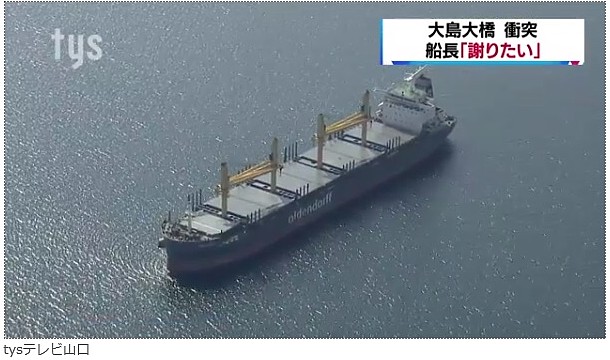
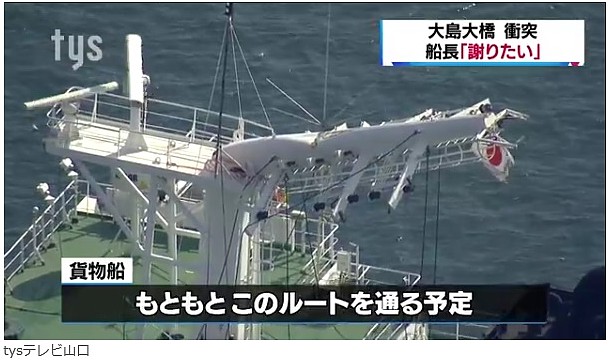
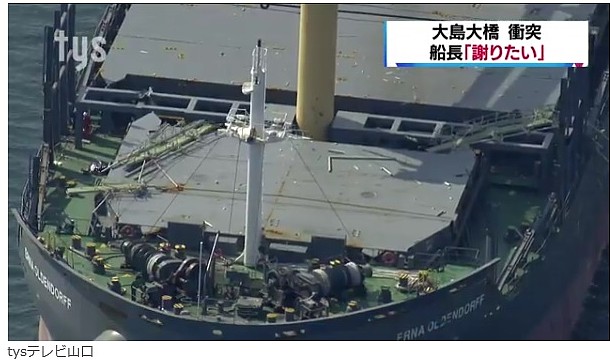
大島大橋への貨物船の衝突を捜査している山口県柳井海上保安署の調べに対して、船の船長は「島のすべての人に謝りたい」と話していることが分かりました。柳井海上保安署はマルタ船籍の貨物船が大島大橋に衝突したと断定し、インドネシア国籍のヨハニス・ベンジャミン船長と航海士の事情聴取を続けています。海面から橋までの高さは満潮時でおよそ30メートルですが船のクレーンやマストの高さは35メートルから40メートルあり、海上保安署では、この船は橋の下を通れなかった可能性が高いとみています。柳井海上保安署によると、実況見分の結果、もともとこのルートを通る予定にしていたということが分かりました。取り調べに対して船長は「島に住んでいる人が水を使えなくなったことなどについてすべての人に謝りたい」と話しているということです。船長は衝突を認めていて、海上保安署では近く業務上過失往来危険の疑いで書類送検する方向で検討しています。
便宜置籍船の制度は合法なので無理だと思います。物流でコスト削減のために便宜置籍船制度を廃止すればコストアップになります。
便宜置籍船制度を完全否定するのであれば理解できますが、「マグロ」に関してだけ否定しても制度が存在し、合法である以上。
誰かが利用します。
便宜置籍船制度と言いますが、問題を起こすのはサブスタンダード船の多くが登録されている
国籍。「マグロ」問題と共通点は「規則を守らない」と「違法が見逃される」。
局部的に問題をとらえるのも良いが、全体的に問題を見ないと大きな動きはないと思う。まあ、個人的には日本のお役所はあまりやる気は
ないのか、それとも能力がないのか知らないが、ピントがずれていると思う。
ストップ!便宜置籍漁船マグロ! 08/15/17(清福丸ブログ)
今日は気になるマグロニュースをご紹介クリップ
「FOC漁船からの冷凍バチ輸入の疑いが浮上 小型超低温マグロ漁船漁獲物の可能性が濃厚」
今年上半期の冷凍バチの輸入は、既報のように数量減少、単価高とともに、台湾資本の便宜置籍超低温マグロ漁船の操業が問題になった際に便宜置籍国と言われたところからの輸入の増加も特徴の1つとなっている。バヌアツ、セーシェルといった便宜置籍漁船(FOC)の正常化国ではなく、
アフリカのコートジボワールや中南米のセントビンセント、ベリーズなどで、6月のコートジボワールからの輸入量は台湾、中国、バヌアツに次ぎ、セーシェルを上回る244トンに達した。また、セントビンセント、ビリーズは、水産庁が輸入事前確認によってFOCマグロとして公表した便宜置籍マグロ漁船国に“認定”された過去がある。
これらのFOCマグロの疑いがある冷凍バチの輸入が増加したのは、最近の超低温マグロ漁業が数年前の燃油高、魚価安から一転して燃油安、魚価高となり、採算がとれる可能性が高くなったことが考えられる。セーシェルのFOC正常化船も、燃油高、魚価安と海賊問題で一時は半数以上が係船と言われるところまで追い込まれたが、1~2年前からは係船されていた漁船が次々に稼働を再開したとされ、冷凍バチの今年上半期の輸入量は台湾、中国に続く第3位グループにつけている。
それでもセーシェルからの冷凍バチの上半期輸入量は前年比18%で、増隻はしていないことがうかがえる。
「小型超低温漁船日台合意遅延も背景の1つか」
これに対してコートジボワール、セントビンセント、ベリーズからの冷凍バチの輸入量は次のページ(下図)のように、決して大きな数量ではないにしても着実に増加している。この決して大きな数量ではないにしても着実に増加ということも、今回のFOC疑惑のを考えるうえで重要なポイントとみられる。というのは、
これらのFOC漁船が大型超低温漁船であれば、地域漁業管理機関や水産庁等の規制網に阻まれて輸入されていないのではないかと考えられるからで、これらは国際機関の漁船登録等の対象外である船長25メートル未満の小型超低温漁船であると考えると、決して大きな数量ではないにしても着実に増加に当てはまる。小型超低温漁船の増隻抑制、正常化については、
日台政府間で2016年までに台湾の小型超低温漁船を責任あるまぐろ漁業推進機構(OPRT)に登録させることで合意したにもかかわらず、台湾国内の漁業界の意見がまとまっていないとして台湾側の作業が遅れ、いまだに実現していない。コートジボワール、セントビンセント、ベリーズといったFOCの疑いがある国々からの冷凍バチ輸入増加の背景には、
冷凍バチの供給不足といったマーケット事情に、日台合意が実施されていないことを監視・規制の緩みと受け取られた可能性も考えられ、改めて同問題への真剣な取り組みが求められている。(日刊かつおまぐろ通信記事抜粋)
便宜置籍船(べんぎちせきせん、英: flag of convenience ship)とは、その船の事実上の船主の所在国とは異なる国家に船籍を置く船のことをいいます
通常、船主は所有船を国家に登録しなければなりません
しかし船主がその出資により、船を所有するためだけの会社を置籍国に設立する、という手段が用いられます
当然この会社は実態を持たないペーパーカンパニーとなります
なぜこんなことをするのかというと船舶の所有・置籍に課す税金を低く抑えれたり(タックス・ヘイヴン)、乗員の国籍要件等に関する規制を抜ける目的で行われます
また国によっては外国船籍を誘致する目的で便宜置籍船を受け入れる国も多々あります旗
便宜置籍船は主に外航海運で注目されているが、漁業においても国際漁業協定に加盟していない国に船籍を置くことによって、捕獲規制対象になっている魚種を捕獲している便宜置籍船が存在しており、国際的な問題になっています
また一部の船主がこの制度を悪用して、乗組員の処遇を他の国と比較して極端に低く抑えたりすることも問題となっています
マグロ船においても同様ですうお座
現在、マグロ船は国際管理機関であるOPRTによって国ごとのマグロ船の隻数を厳しく管理されています
そのため、日本や台湾のようなマグロ漁業国では船を増やせないようになっています
ところが船を増やしたい一部の外国船主が発展途上国にペーパーカンパニーを設立し、そこに自社のマグロ船を転籍させる事案が昔から横行していました
現在取り締まりを厳しくし、船長25m以上の大型漁船の転籍が難しくなったので、便宜置籍国の疑いがある国からのマグロの輸入は減っていましたが、最近25m以下の小型漁船の転籍が加速
それに伴い、再び便宜置籍船からの輸入が増えているのではないかというのが今回の記事です得意げ
これは国際的な問題なうえに実態調査が難しく、簡単に解決できない問題です
特に消費者側が違法な手段で獲られたマグロなのかどうかを見極めるのは不可能
しかしこれを許してしまうと船が無尽蔵に増え、マグロ資源の悪化につながるだけでなく、安く質の悪いマグロが日本に輸入され、知らず知らずに美味しくないマグロが食卓にあがることになりますえっ
厳しいルールのなかなんとかやっている我々日本の漁業者も便宜置籍船の価格に安いマグロに負けてしまいます
解決するには外国からマグロを買い付ける水産商社が便宜置籍船で獲られたマグロを購入しないことに尽きると思います
ストップ!違法マグロ!禁止
沈没船を違法にサルベージ 中国籍の浚渫船を拘留 | 第二次世界大戦で沈没した日本の汽船「日吉丸」や「香取丸」、旧日本軍の駆逐艦「狭霧」もか? 05/13/17(pelicanmemo)
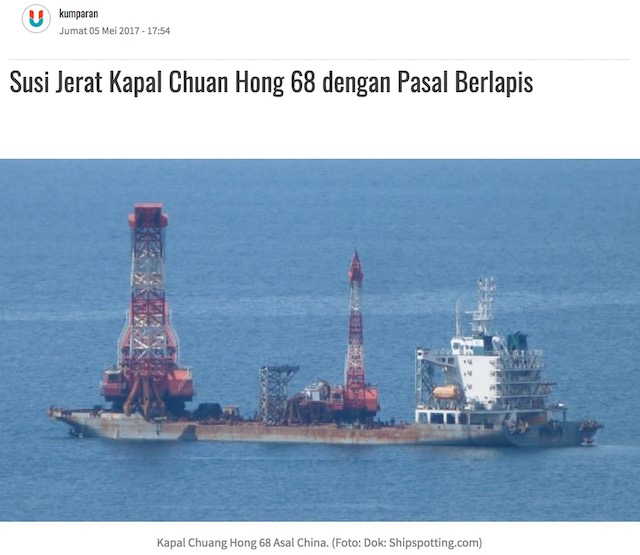
マレーシア海上法令執行庁(MMEA)(*)は、東南アジアの海底に沈んでいる、タンカーや汽船などを違法に引き揚げていたとして、中国籍の浚渫船「Chuan Hong 68(川宏68)」号を拘留した。
中国船「Chuan Hong 68(川宏68)」号は、全長122m、排水量8352トンの浚渫船。
1969年に沈没したスウェーデンのタンカー「セブン・スカイズ(Seven Skies)」、1973年に難破したイタリアのばら積み貨物船「イガラ(Igara)」を違法に引き揚げ、スクラップとして売却していたとみられている。第二次世界大戦で沈没した日本の汽船「ひよしまる(日吉丸?)」や「かとりまる(香取丸?)」、旧日本軍の駆逐艦「狭霧」も引き揚げていたようだ。
残骸には戦没者の遺骨も残されており、海底の墓標を荒らす行為として関係各国は原因を調べている。
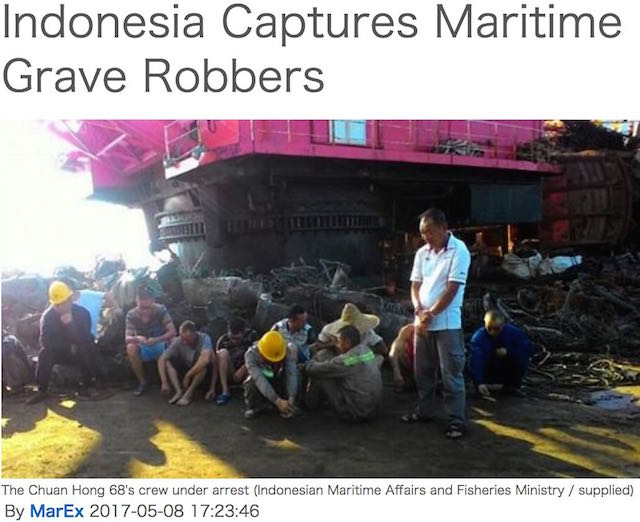
4月20日にインドネシア海軍によって一時拘束されたが、逃走していた。スシ・プジアストゥティ(Susi Pudjiastuti)海洋水産大臣は国際警察機構(インターポール、ICPO)の協力をもとめると発表。船を動向を監視するためマレーシア海上法令執行庁(MMEA)の支援を求めていた。
中国外交部の耿爽報道官は4月25日の定例記者会見で 、「Chuan Hong 68(川宏68)」号には中国国籍の船員17人が乗っていることと、マレーシアの会社に雇われていることを明らかにし、指定された海域でのオフショア作業に従事していたと伝えた。
(*)マレーシア海上法令執行庁(英語:Malaysian Maritime Enforcement Agency(MMEA)、マレー語:Agensi Penguatkuasaan Maritim Malaysia (APMM))
Indonesia Captures Maritime Grave Robbers
MMAF Secures Treasure Stealing Ship from China
Indonesia seeks Interpol's help to find dredger, World News & Top Stories - The Straits Times
東南アジアでは、第二次世界大戦で沈没した艦船の残骸が荒らされる被害が続いている。
オランダ海軍の「デ・ロイテル(Hr. Ms. De Ruyter )」と「ジャワ(Hr. Ms. Java)」、駆逐艦「コルテノール(Hr. Ms Kortenaer)」が、海底から消えていることが確認された。また、英国海軍の巡洋艦「エクセター(HMS Exeter)」と駆逐艦「エンカウンター(HMS Encounter)」の残骸もなくなり、米海軍の潜水艦も無くなったそうだ。
残骸には戦没者の遺骨も残されており、海底の墓標を荒らす行為として関係各国は原因を調べている。
1950年代以前に建造された船の鋼材は、放射能測定での環境放射能遮蔽材(低バックグラウンド遮蔽体、Low-background steel)としても利用される。
2次大戦で沈没した軍艦の残骸、海底から消える ジャワ海 - CNN
British second world war shipwrecks in Java Sea destroyed by illegal scavenging - The Guardian
Illegal divers strip ships sunk in WWII for scrap - The Straits Times
Missing Dutch warships maybe sold as scrap metal: report - NL Times
Kapal Keruk China MV Chuan Hong 68 Langgar Empat UU RI - Kompas
Perairan Anambas Tempat Chuan Hong 68 Ditangkap Banyak Harta Karun - kumparan
Kapal Keruk Berbendera China Diamankan Lanal Tarempa riauone.com - Berita Nusantara Terkini
中国打捞船盗宝栽了 仿效印尼 保护海底资产 - 星洲网 Sin Chew Daily
2017年4月25日外交部发言人耿爽主持例行记者会 — 中华人民共和国外交部
Indonesian seafarer’s death highlights Taiwan interpreter shortage 01/24/17(The Jakarta Post)
Stephanie Chao The China Post/ANN
“It is difficult to leave this place ... I’m often insulted by the captain, too. Here is a victim of violence on this ship,” Indonesian seafarer Mualip said in his recorded video of fellow seafarer Supriyanto, who is shown sitting dazed on deck of a ship that left Pingtung’s Dong Gang harbour in May.
In his narration, Mualip describes Supriyanto as having been beaten by crew members of the ship before recording the video. Supriyanto was sporting swelling and bruising on his face. “Thank you, Supriyanto. I hope you will recover soon,” Mualip said.
It would be one of the last visages of Supriyanto. In another video, he was shown at the brink of death in late August.
With the 580,000 foreign blue-collar workers living in Taiwan (as of 2015, the Interior Ministry’s figures showed there were approximately 630,000 foreigners in total) and a vast number of foreign spouses, with those coming from Southeast Asia making up almost 90 per cent (149,213 out of 165,902), one would assume that Taiwan would have already set up a comprehensive system in place to address the needs of a vast population.
A recent probe into the case of Supriyanto's death suggests otherwise.
In November 2015, the Pingtung District Prosecutors’ Office deemed the death of Supriyanto, who died onboard a fishing vessel in August, an accident. Prosecutors found that he died from illness caused by an untreated knee wound after falling from an elevated point on the ship while hanging clothes.
However, the prosecutors office did not completely close the case. Prompted by petitions from non-government organisations upholding seafarers’ rights, who found details of the case and Supriyanto’s death suspicious, the Control Yuan ombudsman Wang Mei-yu relaunched investigations into the case last December.
Misinterpretation or lack of interpretation?
Wang found critical evidence in the case -- three videos of Supriyanto recorded by Mualip --- to be controversial. After bringing in an interpreter who was familiar with Supriyanto’s language, an obscure Javanese dialect, the Control Yuan revealed that his statement in the video vastly differed from the translation recorded by the prosecutors’ office.
A factor neglected by prosecutors was misinterpretation of the videos: the two interpreters brought in by the prosecutors’ office in charge of the court translation did not understand Supriyanto and Mualip’s language and could not translate vital parts of the former’s statement, revealing that he had been beaten by crew members as well as the Taiwanese captain.
The Control Yuan’s probe concluded that the captain’s negligence in providing medical assistance to treat Supriyanto’s wounds had resulted in his death; as well as government negligence from the Executive Yuan’s Council of Agriculture and the Fisheries Agency to oversee foreign seafarers’ working rights and working environment.
The Pingtung Prosecutors’ Office, prompted by Wang’s report, has relaunched a probe into Supriyanto’s case.
The nuances of language
Supriyanto’s death refocused attention upon the poor working conditions of foreign seafarers, who are not fully protected under Taiwan’s labour laws. However, his case also turned attention to an overlooked factor, equally important to bringing about more equal treatment in court for blue-collar foreign workers or foreign spouses in Taiwan: language.
Prompted by Supriyanto’s case, a January 10 public hearing was held to discuss Taiwan’s community interpretation problems. It urged the government to consider directing more investment toward community interpretation talent training and certification in order to uphold constitutional rights for Taiwanese and foreign workers.
“I once saw a case that unfolded like this: a Filipino seafarer spoke in a long-winding sentence in his local dialect, however the interpreter, translating through a video conference, only said two sentences,” Lennon Wong, Serve the People Association Service Center and Shelter for Migrant Workers, told The China Post.
“That’s a definite misinterpretation of the truth.”
He added that foreign workers or spouses seeking medical treatment often ran into similar problems when their English or Chinese proficiency was not sufficient to accurately describe their symptoms.
Awakening Foundation, a women’s advocacy group, legal department director Chin Chi-fang said during the public hearing that addressing language barriers were often the pivotal point for foreign workers to receive their due at court.
“The impression among foreigners in Taiwan is that they don’t get their due diligence in Taiwanese courts. Language is one issue, but there is also prejudice,” interpreter Priya Lalwani Purswaney told the China Post, saying that foreigners try not to get into trouble here, but if they do, they try to get their cases heard elsewhere.
“Foreigners should be able to understand what’s going on” regarding the Taiwanese court system and constitution, and translation should be provided, but that is not always the case, she said.
Compiling the resources
A unanimous consensus among NGO’s and lawmakers was the urgent need to address the talent gap in Taiwan, despite government agencies’ ongoing efforts to train interpreters and hosting talent banks.
The government set up an interpreter talent bank back in 2009 which provided legal interpretation services, Immigration Affairs Deputy Director Yin Yu-hua said.
The job bank currently boasts 1,431 interpreters and provides translation services for 18 different languages, ranging from Vietnamese, English, Indonesian and Thai, he said.
However, Yu conceded that while the number of interpreters was sufficient, specific and lesser-known languages or dialects were much harder to find, citing a smaller talent pool and demand.
He also addressed the quality discrepancy of interpretation since government training did not adhere to any sort of certification, and citied lack of legal regulations and insufficient budget. Yu promised to direct efforts and training to increase quality.
In spite of the government’s confidence in providing adequate quantity interpreters, TransAsia Sisters Association, Taiwan (TASAT) executive secretary general Hsieh Shih-hsuan said otherwise, citing unequal resource distribution nationwide.
A case in Hualien County involved an interpreter who could not understand a local Indonesian dialect, Hsieh said. “You can’t say that (the government) has a sufficient number of Indonesian speakers, but should, consider whether there are enough resources to provide services for dialects of the language, and whether local agencies could obtain such resources in time.”
In the association’s view, “the government hasn’t achieved that,” Hsieh offered. In the end, the prosecutors or lawyers managed to reach out to them, and they provided a suitable interpreter.
“There are so many new immigrants and legal interpreters in eastern Taiwan, yet (we) couldn’t find suitable resources, and we still had to look back to the capital for assistance,” Hsieh said, calling out on the gaps in talent distribution and training.
Democratic Progressive Party lawmakers Yu Mei-nu and Tsai Pei-hui agree that the government should lead efforts to take stock of existing resources, specifically interpreters and second-generation offspring of new immigrants from Southeast Asia, who cpuld become Taiwan’s critical talent pool to draw from.
Speaking to The China Post in a joint interview with Yu, Tsai said on top of coming up some sort of certification programme to ensure interpretation quality, creating an usable platform to aggregate talent must be considered.
She suggested that the government could set up regional centers to provide professional interpretation around Taiwan: for example, centres overseeing services in eastern, central, northern or southern Taiwan, which would help relieve the burden from interpreters who might have to travel long-distances from their homes to work on cases in far-flung parts of the country.
Yu said that criteria and compilation of data should be considered, ranging taking stock of interpreters who could provide services for certain languages, the ratio of foreign spouses, country of origin, the number of second generation offspring who could leverage their bilingualism.
After the public hearing, both Yu and Tsai asked the Executive Yuan to consider assigning a minister without portfolio to oversee such undertakings, which they believe would require cooperation between multiple government agencies.
“There should be a schedule in place; like what we should do in two years, or a monthly agenda,” Tsai said, in order to push the administration to carry out related work.
Improving interpreters’ conditions
However, both Hsieh, Purswaney and lawmakers echo similar sentiments that working conditions for interpreters must be addressed as well, specifically low pay, in order to motivate talents in the industry.
Hsieh proposed at the public hearing that a “special law” should be drawn up to guarantee interpreters’ working pay and environment.
Lawmaker Tsai pointed out that a price floor should be drawn up to ensure that interpreters of southeast asian languages can receive “adequate and reasonable” pay, who cited numbers mentioned at the public hearing of only a few hundred New Taiwan dollars per hour, compared to higher wages for English interpretation.
A joint effort
A silver lining in Supriyanto’s case was government attention from not only Taiwan, but also in his home country, Indonesia.
Control Yuan’s Wang, before the interview wrapped up, brought up that when accompanying with Control Yuan President Chang Po-ya’s delegation to Indonesia, they received a positive feedback from Indonesian government’s BNP2TKI, which oversees safety and protection for Indonesian workers abroad, when they expressed concern about cracking down on local illegal employment agencies that exploit migrant workers.
Efforts to prevent illegal employment agencies in Indonesia and Taiwan should be carried out to ensure protection and basic human rights for foreign workers, Wang said, pointing out that joint efforts should be made.
カンボジア船籍で青森県沖の日本海で沈没したMING GUANG(IMO: 8513546)の件に関してのコメントを見つけた。これに対してコメントをして見ようと思う。
クリアハイト203cmについて新ILOと表現されているが、これは新ILOではない。
1949年の船員設備条約(改正)(第92号)のは条約発効日:1953年1月29日。2006年の海上の労働に関する条約によって改正され、現在は批准に開放されていない条約 (ILO)ILO第92号では190cm、そして
1970年の船員設備(補足規定)条約(第133号)のは条約発効日:1991年8月27日。2006年の海上の労働に関する条約によって改正され、現在は批准に開放されていない条約 (ILO)ILO第133号では198cmが要求されていた。日本が批准してこなかっただけで、批准していた国々は存在する。日本の国土交通省が適用の必要のない内航船に対して適用を決めただけで、ILOを非難するのは勘違いで間違っている。推測であるが、日本(国土交通省や外務省)の見えで内航船にも適用したと思う。加えて言うのであれば内航船を使う業界や大手企業、又は、船主が船員の労働環境を犠牲にすることで出来るだけ安く荷物を多く運びたいと思ったから国土交通省が2006年の海上の労働に関する条約の一部を内航船に適用するまで過去の基準が適用されて来た。同じ投資額で運べる荷物が減ったので安全性を犠牲にしても載貨重量を増やそうとするから、安全性が落ちる船の設計及び建造となるのである。安全や環境のためのコストアップを受け入れるのであれば問題ない。消費税アップで下請け企業が負担を強いられたケースと同じである。業界や大手企業が負担を受け入れないからシワ寄せが船主に行くのである。同じ499GT貨物船でも平水だけ、沿海だけそして近海区域までの要求を満たす船では、要求される条件により載貨重量などが違ってくる。平水区域を満足するだけの条件で建造された499GT貨物船は近海区域の資格を取れない事も多くある。全てはどのような基準を適用するかである。
苦情を言うのであれば相手は国土交通省である。いっそのこと、外売された平水区域で建造された499GT貨物船が載貨重量3000トンとなり遠洋区域で航行されているのだから、それぐらいの承認がほしいと訴えれば良い。外売された499GT貨物船が載貨重量3000トンで遠洋区域で運用されている事実は、平水や沿海区域ではもっと安全である事は証明されている。安全係数や安全基準次第である。安全係数や安全基準を下げれば事故発生率は上がるが、経済的負担は減る。
韓国客船 Sewolの沈没事故のように過載であっても指摘しない韓国国土交通省を考えると、内航船である以上、どのような規則を適用させるのかはその国又はその国の国土交通省次第である。韓国のように業界寄りのスタンスであれば、利益追及も許される。あと、天下りの指摘をするべきでしょう。国土交通省の承認がないだけで、品質はほとんど変わりないのに、内航船には使えない製品が多すぎる。国土交通省の天下りを受け入れることによりメーカーは製品の型式承認を取りやすくなるようです。外国製品だと外国の検査会社に承認されていても品質がひどいものがあるが、同じメーカーの同じ製品でも外国で買う方が圧倒的に安い。何が違うのか、日本籍船で使えるのかどうかだけである。サブ・スタンダード船の検査の場合、スクラップになった船に搭載されたイマーションスーツを安く買って、検査に通す事も出来る。日本船籍船では無理。再整備したり、補償を付けたりすると、新品の方が良いとなる。
2006年の海上の労働に関する条約は船員のバックグラウンドの人達よりも、弁護士や法関係者達が条約に関わっているで、技術的な事は考慮していないと思う。日本政府(国土交通省)がどれだけ発言権や関与出来たのかは知らない。手を打つのであれば国際条約として採択され、発行される前に行動に移すべきだった。これも非難するのであれば相手は国土交通省。一番影響を受けるのは多くのILO条約が適用されずに建造された国籍の船。大きなインパクトがあるのは常識で考えればわかること。
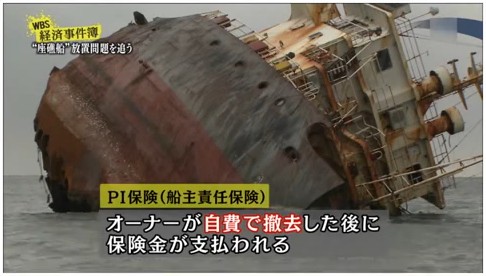
”座礁船”放置問題を追う 2015 02 11(Youtube)
ワールドビジネスサテライト,2/11,WBS経済事件簿,"座礁船"誰が撤去する?
貨物船沈没、海上保安庁による乗組員救助の瞬間 12/26/14 (内航.com )
連日、荒天を起因とする海難事故が続いています。
統計を取ったわけではありませんが、海難事故がつづく時には本当に続きます
青森県鰺ケ沢町の北西沖で26日、カンボジア船籍の貨物船「Ming Guang」号(1915トン)が沈没し、
海に投げ出された乗組員10人を海上保安庁が救助した海難事故
おそらくGoProの映像だと思われますが救助した海上保安官には敬意を評したいと思います
残念ながら3名亡くなったのですが逆に言えば、真冬の日本海に投げ出され10名も助かったのです
助かった要因としては、映像を見てわかる通り イマーションスーツの着用
船舶設備規定
①イマーション・スーツの備付け
1)国際航海に従事する総トン数 500 トン以上の貨物船
2)遠洋・近海区域を航行する総トン数 500 トン以上の貨物船(限定近海船を除く。)
3)総トン数 500 トン以上の漁船
イマーションスーツ一着約10万円です⇒イマーションスーツ
10万円で命が助かる可能性が増えるなら安いものです。
命を守る本当の安全を全船義務化しないで意味のないとこを義務化していく規制
新ILOなんて最たるものです
クリアハイト203cm 日本人なら98パーセントの船員がクリアハイト195あればヘルメットかぶって室内にいても快適に過ごせます
逆にクリアハイトが高くなるとスタビリティの低下 積みトン減少による不経済船
それでも旧ILOの貨物ロットに近づけようと設計することによる耐荒性の減少
ようするに船員にも荷主にも良くない船ができるのです。今まで走れてた荒天(運航管理規程内)も走れなくなります。
今まで積めてたトン数も積めなくなります。(特に499GT貨物船)
水も油も以前のように積めず長距離航海に支障がでます(バンカー場所指定の会社が多い為)
世界の労働者の労働条件と生活水準の改善を目的とする国連最初の専門機関であるべきILOが内航船員にとっては最悪な船を造る条約であることをもう少し考えるべきではないでしょうか
少なくとも外売までは国際航海しない内航船がほとんどなんですから、200t以下の拡大解釈をもっと広げるべきではないでしょうか
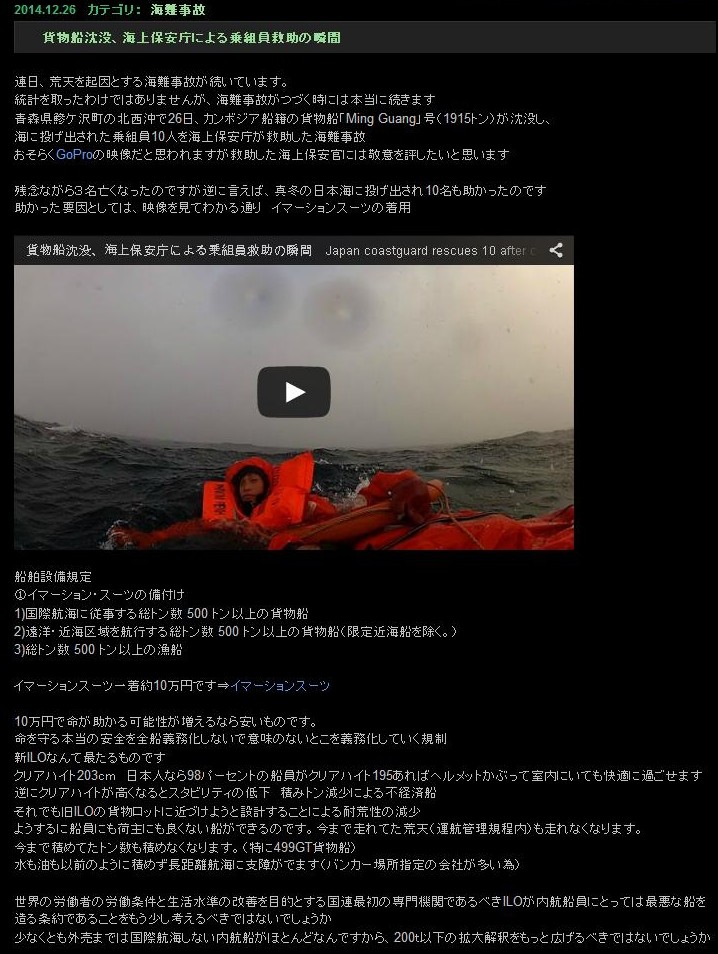
“SLAVE SHIP” HIGHLIGHTS FOLLY OF AUSTRALIAN CONSERVATIVES’ ATTEMPT TO DEEP-SIX CABOTAGE LAWS, ITF SAYS 08/25/15 (International Organization of Masters, Mates & Pilots)
The International Transport Workers’ Federation (ITF) reports that crewmembers aboard a Korean bulker docked in Mackay, Australia, were literally starving. The ITF says the conditions aboard the flag-of-convenience (FOC) ship are a stark reminder of the risks that mariners can face in the unregulated world of FOC shipping. The Conservative Australian government is seeking to repeal that country’s version of the Jones Act and open the domestic trades fully to FOC vessels.
A spokesperson for the ITF said one crewmember aboard the Korean bulk carrier, the C. SUMMIT, was diagnosed by a doctor as suffering from malnutrition. Four members of the crew fled the ship in Mackay, claiming they feared for their lives. ITF Assistant National Coordinator Matt Purcell said the men, all of whom were from Cambodia or Burma, had been victims of “the worst kind of bullying” he had ever encountered in his work as an inspector.
“The crewmembers claim they have received no wages for several months,” he said. “They have been locked in hatches and have survived on what I can only describe as a starvation diet.” Purcell said two contracts were found by inspectors, one signed by the workers before boarding and the other, “which doesn’t meet even the most basic international standards,” signed shortly after joining the ship.
The C. SUMMIT is owned by South Korea-based Chang Myung Shipping Co. The ITF said its many deficiencies had been repeatedly noted by inspectors in a number of different port state control areas.
ITF President Paddy Crumlin said although the ship was an extreme example, many ships calling at Australian ports have poor records on safety, pollution and crew welfare. “The sea is a largely unregulated environment in which greedy shipowners and operators are allowed to get away with egregious breaches of human rights, and the Australian government is regularly turning a blind eye to the breaches happening in our waters,” Crumlin said. The country’s prime minister, he added, “seems to want these awful breaches to increase by wiping out the Australian merchant navy fleet through complete deregulation.”
The country’s Conservative government is attempting to dismantle the Coastal Trading Act, which stipulates that ships trading between Australian ports must be crewed by Australian workers or else paid comparable wages.
オリョン号 (Oryong 501)と思潮産業 (Sajo Industries)で検索したら思潮産業 (Sajo Industries)は過去に船員の給料未払いや漁船の沈没による船員死亡事故を起こしているようだ。それらを考慮すると、今回の事故は起きても不思議ではない背景があると思われる。下記の情報が本当であれば想像した以上に、ブラック企業。2年間働かせて4000アメリカドルは破格に安い。
Oyang 70が沈没した時に船主のSajo Oyang Corporation と用船社の Southern Storm Fishing (2007) Limited は次のようなコメントをしている。
「The FV Oyang 70 underwent a full Maritime New Zealand safety inspection in July 2010 and was equipped with a full complement of life saving equipment, life rafts and cold water immersion suits as required by both International and Maritime conventions. The vessel had a full and current Maritime NZ Safe Ship Management certificate at the time of sinking. In addition the vessel was surveyed to Korean survey standards in Lyttleton in December 2009. Korean survey standards comply with the requirements of IMO conventions and are consistent with the standards required in respect of NZ owned vessels.」(08/18/10 Scoop News)
2010年8月に沈没した「Oyang 70」号の事故調査報告書で船員が「It is disputed whether a siren alerted crew to abandon ship and they described a poorly maintained ship filled with cockroaches and lax safety standards.」と証言している。
2014年4月に起きた韓国客船 Sewol沈没とは関係が無いようで関係がある。船主、用船社及び船員の証言に辻褄が合わない事。つまり検査を通っても安全である根拠はない。船、船が登録されている旗国そして検査会社が適切に責任を果たしていないと船は安全でないと言う事。検査に合格した事実は、書類上そして規則上、船を運航できると言う事である。悲しい事であるが、PSC(外国船舶監督官)が存在し、適切に監督としての機能しないと問題のある船は運航され、海難を起こすと言うとだ。韓国客船 Sewol沈没は最悪の結果として多くの人々や国に注目された一例にすぎないと言う事であろう。
Sunken trawler's owner has NZ history 12/04/14 (Stuff.co.nz)
MICHAEL FIELD
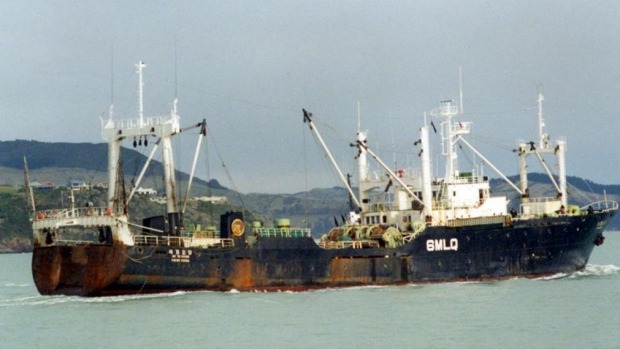
OYANG 70: Pictured in June 2006, it sank in the Southern Ocean more than 200 nautical miles off Dunedin.
A South Korean fishing boat that sank on Monday in the Bering Sea with the loss of at least 52 men is owned by the same company that lost a ship in New Zealand and has had two more convicted here and forfeited to the crown.
Sajo Industries' 36-year-old trawler Oryong 501 sank on Monday while fishing for Alaska Pollock which, with New Zealand hoki, is the main fish used worldwide in McDonald's Filet-O-Fish.
Sajo also owned the 38-year-old Oyang 70, which sank in New Zealand's exclusive economic zone in August 2010 while hauling in a big bag of southern blue whiting, killing six men.
Sajo has been convicted in New Zealand courts over the boats Oyang 75 and 77 for the abuse of environmental, fishing and labour laws, and both boats have been ordered forfeited to the Crown.
South Korean media today highlighted Sajo's role in New Zealand and the allegations of appalling labour abuses aboard the foreign charter fishing vessels that were used to take Maori Waitangi Treaty quota.
The Korea Times says families of the men from the 1753 ton Oryong 501 believe the sinking was a man-made disaster caused by reckless fishing in bad weather.
They said Sajo pushed ahead with fishing despite high waves and strong winds.
"It seems the vessel tried fishing in bad weather conditions with high winds and waves four metres high," Kim Cheon-sik, a family member of one of the missing fishermen, told the Korea Herald.
Ships should return to port in such conditions, he said.
Sajo director Lim Chae-ok said it was the captain's decision.
"People at the head office in Seoul cannot know weather conditions at sea, so the captain usually decides."
Oryong 501 sank at around 2.20pm local time on Monday, with 60 seamen onboard. Eight people were rescued but one of them, a Korean, later died of hypothermia, while 52 others are still missing, according to the Korean Ministry of Oceans and Fisheries.
There is little hope now in appalling winter conditions that the missing men will be rescued. Four empty lifeboats have been recovered.
Like the ships used in New Zealand, Oryong was mainly crewed by low wage Asian men.
There were 35 Indonesians, 13 Filipinos, 11 South Koreans and one Russian inspector.
The Korea Herald said families believe it took four hours from the ship's first listing to its eventual sinking, but the company failed to order the crewmembers to evacuate and prepare for rescue measures at a proper time.
One family member claimed that when he talked to one of the missing sailors over the phone before the accident, he said that the company had ordered them to do additional fishing, although they already had the assigned amount of catch.
Lim Chae-ok denied the ship had an excessive amount of fish.
"Due to bad weather, we suspect too much water came into a fish container and the container became waterlogged."
His claims are strikingly similar to those made around Oyang 70 after it sank off the Bounty Islands, east of Otago.
It pulled in a large catch of whiting in calm seas but its captain, who went down with the ship, lost control of it and water flooded the fish factory and engine room.
The sinking of Oyang 70 had little impact in Korea at the time, but the new disaster comes less than eight months after the sinking of the Sewol ferry off South Korea's south-western coast in April left more than 300 passengers dead, mostly teenagers on a school trip.
Oyang 75, which was bought in to New Zealand to replace Oyang 70, has been ordered forfeited over fishing and environmental violations. It is currently under bond in the Indian Ocean and is likely to be auctioned in New Zealand.
Oyang 77, convicted for misreporting its catch and fish dumping, is also to be forfeited. It is currently squid fishing near the Falkland Islands in the South Atlantic. It has been renamed by the Koreans to Jille.
- Stuff
Oyang 77 IMO 7416612 (ShipSpotting.com )
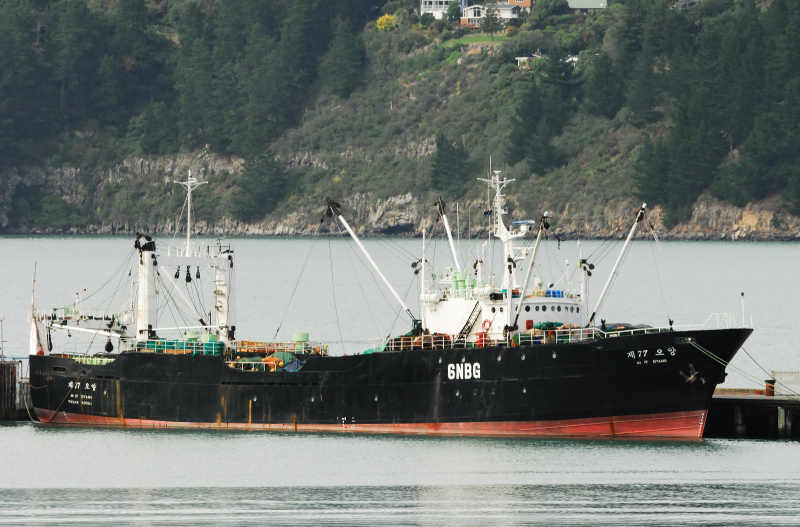
Story is that the Korean company that owns this boat and / or the captain became aware that they were about to be investigated and decided to flee for open water. In the belief that the NZ Navy was chasing them, they returned to Port and very quickly paid off there crew and bussed them to Christchurch International Airport for a quick departure paying them $4000 for 2 years work.
NZ Govt is currently investigating a number of Korean charter fishing boats over allegations of poor and slave like working conditions, little or no pay, abuse of crew etc.
__________________________________
Additional information about this ship and others from the The Christchurch Press 12.March.2012
A Korean fishing boat is under High Court arrest over claims its owners owe $2.335 million in unpaid wages over two years.
Agents for 36-year-old foreign charter vessel (FCV) Oyang 77 tried before dawn on March 3 to get its crew on a Singapore Airlines plane from Christchurch but Ministry of Fisheries enforcement officers intercepted them.
Six agreed to help in official "investigations into whether the Oyang 77 has breached fisheries regulations" and have been kept in hiding in Christchurch.
Industry sources told the Sunday Star-Times that conditions are so appalling on Oyang 77 that six Korean officers tried to leave. Oyang fishes iwi quota in a charter operated by Southern Storm Ltd, a shell company for Korea's Sajo Oyang Corporation.
On March 1 a ministerial inquiry warned Korean FCVs mistreated crews and damaged New Zealand's international reputation. It made a series of recommendations for tighter control.
Oyang 77, one of 13 Korean-flagged ships out of a 21-strong FCV fleet, has become the cause celebre for campaigners fighting the slave-like conditions aboard the boats first exposed a year ago by the Star-Times. Last month it was refused a licence to fish here.
Already held under a High Court warrant over $160,000 in damages to Talley's Fisheries, Oyang 77 moved on March 3 to get its crew out. Tauranga lawyer Craig Tuck, founder of Slave Free Seas group, says Southern Storm threatened the crews and said if they did not go they would not get bonuses of around $4000.
They were told agents in Indonesia would make their lives even harder. "It was very threatening and the men felt very intimidated," he said.
On Monday, Tuck, acting for 26 crewmen, obtained a High Court arrest warrant over Oyang for the unpaid wages. Southern Storm, in a press release, denied any wages were owed.
While New Zealand authorities have been indifferent in the past to the plight of FCV crews and unwilling to enforce a code of conduct, that changed last week.
After the fishermen cleared Customs and were heading to the departure gate, Fisheries enforcement reached them. Men were asked to stay back to help with investigations against the owners of the Oyang 77. Allegations include illegal dumping and high grading of fish in the exclusive economic zone, as well as trucking, which means quota is illegally moved from one area to another.
"A small number of Oyang 77 crew members have chosen to stay in New Zealand and are assisting with these investigations," Fisheries deputy director-general Scott Gallacher said.
Oyang 77 is a sister ship to Oyang 70 which sank off Otago two years ago killing six, and of Oyang 75, whose crew walked off in Lyttelton in protest at inhumane conditions aboard.
Another FCV, Mellila 201, which is owned by Taejin Fishieries of Korea, and chartered by United Fisheries in Christchurch, remains under arrest at the insistence of the crew, with claims of $1.8m owed in salaries.
Korean fishing vessels accused of sex crimes in international waters 05/12/12 (The Hankyoreh)
New Zealand government alleges range of worker abuses, and weak Korean government response
By Ko Na-mu, Hankyoreh 21 staff writer in Jakarta
The New Zealand Department of Labor prohibited the South Korean deep-sea fishing vessel ShinJi from hiring foreign crews on March 5, citing its refusal to participate in a government survey on labor conditions. The country’s Department of Agriculture and Forestry also stripped a boat of its work permit in February, charging it with violating vessel safety standards. The ShinJi is part of a troubling trend of delinquent South Korean vessels who violate standards abroad and aren’t being punished at home.
A New Zealand government report stated that numerous allegations and reports had been made about low wages and abusive treatment of foreign crews, and that all of the complaints lodged with the inspection team had been against one country.
A controversy has been brewing overseas over that “one country,” while its own government has been asleep at the wheel.
Hankyoreh 21 obtained a New Zealand government report from February titled “Report of the Ministerial Inquiry into the Use and Operation of Foreign Charter Vessels (FCVS)”. The report makes strongly worded criticisms about abuses against foreign crewmembers and unreasonable employment conditions on the Sajo Oyang boats fishing in New Zealand’s exclusive economic zone.
Sajo Oyang is South Korea’s biggest fishing company and is at the center of accusations by the New Zealand government of South Korean vessels violating fishery management standards, vessel safety, employment and labor conditions, and abusing workers. One South Korean boat was stripped of its fishing permit in February, a first since South Korean vessels began fishing in the country’s waters. The situation could be damaging to international standings of both South Korea and New Zealand.
Documented mistreatment
Of particular note is the report’s mention of foreign crew labor conditions and abuses in connection with a National Human Rights Commission of Korea (NHRCK) petition.
Some in New Zealand were dismayed with their own government’s failure to regulate its waters and to allow such abuses to go on. In a section of Chapter 2 on “Damage to New Zealand’s international reputation,” the government stated, “During 2011 there were complaints and allegations about such issues as vessel safety, [foreign crews’] living and working conditions, physical and sexual abuse by officers, underpayment and manipulation of time sheets. . . There is no doubt that these allegations of exploitative labor practices and sub-standard working conditions have been damaging to New Zealand’s reputation as a progressive and fair-minded nation.”
The report went on to note, “Most of the incidents reported that are causing damage to New Zealand’s reputation appear to have occurred on Korean flagged vessels. The names of certain Korean vessels and owners came up repeatedly. The alleged abuse occurred mostly against Indonesian crews.”
The allegations also came from New Zealand fishermen. Many of the country’s vessel owners and fishermen reportedly told the team that they believed the practices of South Korean officers amounted to exploitation.
While noting allegations about the behavior of South Korean operators, the report states, “The Panel received no complaints about the mistreatment of crew on vessels currently flagged to the Ukraine, Dominica or Japan.”
It was South Korean deep-sea fishing boats that triggered the investigation in the first place. In 2010, the Oyang 70 capsized, taking the lives of six crews, some of them Indonesian. One of the problems mentioned was a lack of proper safety equipment.
In 2011, an entire crew of 32 Indonesian sailors fled the Oyang 75 over sexual harassment and abusive treatment. The situation became a cause celebre in New Zealand. Many local news outlets began devoting major attention to allegations of abuse on South Korean boats. The University of Auckland Business School was first to draft a report, determining that many of the allegations of abuse and low wages were verifiable.
New Zealand’s Department of Agriculture and Forestry and the Department of Labor then set up a joint investigation panel for a study that took place between Aug. 2011 and Feb. 2012. Written questionnaires were sent to industry representatives, including local and foreign ship owners, manning agents, vessel operators, and crewmembers. Thirty-two people participated in face-to-face interviews. The panel and representatives from the University of Auckland Business School’s New Zealand Asia Institute (NZAI) traveled to Indonesia in 2011 and 2012 to interview most of the Indonesian sailors from the Oyang 75.
At the front of its report, the New Zealand government states, “This publication represents the collective view of the Ministerial Inquiry into Foreign Charter Vessels,” though it adds the proviso that it “is not government policy.”
Shocking findings emerged in the November 2011 report from the NZAI, which were previously presented by some South Korean news outlets, including a January 2012 article in the Korean version of Le Monde Diplomatique on “Overfishing and Abuses: The Competitiveness of South Korean Tuna Boats.” They included substantiation of the credibility of claims by Indonesian crews about a South Korean officer embracing and attempting to kiss foreign sailors and fondling their genitals. The University of Auckland research team interviewed a total of 144 people, including Indonesian crewmembers from the Oyang 70 and Oyang 75. The report also said the human rights commissions of New Zealand and the Association of Southeast Asian Nations (ASEAN) had discussed the issue with the NHRCK.
Sexual crimes
The NHRCK’s discrimination remediation committee ruled on Apr. 18 to dismiss a petition submitted by the Korean House for International Solidarity (KHIS) and Advocates for Public Interest Law on behalf of six Indonesian crew members from the Oyang 75, contending that they had experienced sexual harassment and other abuses. The commission did not announce its decision publicly.
Questioning of members and associates of the NHRCK standing committee found that the commission did acknowledge a “possibility” that the subject of the complaint, an individual surnamed Gang who was boatswain on the Oyang 75, did fondle the genitals of six Indonesian crew members or rub his own genitals against them.
“Given the presence of common allegations among the victims, who all pointed to Mr. Gang as the perpetrator and claimed that Mr. Gang either thrust his genitals at them or rubbed them against the victims’ bodies, embraced the victims, and chased Indonesian crew members while they were showering, it is impossible to rule out the possibility of sexual harassment,” the NHRCK said.
The commission ultimately dismissed the case due to inconsistencies, arguing that the accounts of victims and witnesses did not add up. At the same time, in a kind of “compromise,” it advised that efforts be made to prevent sexual harassment of sailors on deep-sea fishing vessels and provide aid to victims.
The commission’s members are believed to have disagreed sharply during the decision process. “We’re current revising the decision,” an NHRCK representative said. “We’re not sure when the final one will come out.”
The NHRCK also confirmed allegations that a boatswain identified as Choe had engaged in physical and verbal abuse and that Sajo Oyang had drafted two different versions of the wage contracts for Indonesian crewmembers. However, it ruled to reject the verbal abuse and wage issues as outside the scope of its investigations.
Sajo Oyang management denied all charges. The alleged sexual harassment perpetrator identified as Gang reportedly told the NHRCK that there was “no truth to the claims of sexual behavior,” without giving specifics. Choi told the NHRCK, “I have done things like shout, lightly kick, gently slap someone’s head, or pull someone’s ear, but I have never engaged in serious physical abuse.” Sajo Oyang said, “Wages were all precisely calculated and paid,” without elaborating further. Sajo Oyang declined interview requests from Hankyoreh 21.
Another issue has been a lack of diligence. Among the factors cited by the NHRCK in dismissing the petitions was the “difficulty in obtaining testimony” from four major witnesses. The Hankyoreh 21 received a brief account of these witnesses’ current circumstances after inquiring with the human rights group ATKI Indonesia. One is currently a construction worker in Jakarta, while the other three are working on a Russian fishing boat. All four were interviewed by the New Zealand government. However, the NHRCK only conducted written surveys of the six petitioners. ATKI Indonesia member Iweng said, “The South Korean human rights commission doesn’t seem to be taking this case very seriously.”
University of Auckland Business School senior lecturer Christina Stringer, who spearheaded the investigation, said in e-mail to the Hankyoreh 21 that while she was unaware how many Indonesian crew members the NHRCK had interviewed, her team’s study uncovered evidence strongly indicating that a number of Indonesian fishermen were repeatedly sexually harassed and assaulted.
Stringer also said that a copy of the report had been provided at the request of the South Korean embassy in New Zealand, but that there had been no response.
South Korean government refuses to cooperate
Chapter 7 of the New Zealand government report includes a roundabout swipe at the lack of cooperation from the South Korean government, stating, “Information about a vessel’s risk profile is not generally shared among the relevant government agencies.”
According to international practice, the New Zealand government has no authority to investigate labor and human rights issues on foreign-flagged vessels as long as they do not involve fishery management standards. Legal responsibility lies with South Korea.
Between Aug. 2011 and March of this year, the Ministry for Food, Agriculture, Forestry and Fisheries, the Ministry of Foreign Affairs and Trade, the Ministry of Land, Transport and Maritime Affairs, and the NHRCK held a total of three joint meetings. While the agencies in question did have the South Korean fishing businesses under investigation attend, including Sajo Oyang, they made little effort to contact the Indonesian crewmembers. After three meetings, they have yet to take measures to improve the system.
The Hankyoreh 21 asked two of the six petitioners from the Oyang 75 whether they still harbor ill feelings toward South Koreans. One of them, named Trismanto, said, “Before, I thought all Koreans were bad. I changed my mind after meeting the KHIS members last year.”
The other, Sugito, said, “I forgive them now. And I’d like to keep working on fishing boats. But I first want a resolution to this case.”
Sugito’s goal is to bring the facts of the sexual harassment to light and receive all his wages. The two young men plan to visit South Korea some time around June at the request of KHIS. They will come to Korea as free men seeking justice, not as laborers working for meager wages.
※On the Investigation: Interviews took place in Jakarta on May 4. Trismanto and Sugito arrived at ATKI Indonesia’s offices in Jakarta after a seven-hour trip by train and bus from their hometown of Tegal. Iweng, a member of ATKI Indonesia, translated their responses from Indonesian to English. The two men were asked about the sexual harassment and wage exploitation allegations, as well as personal matters such as their families, hobbies, employment contract process, and their boarding and fleeing of the vessel. The New Zealand government report, University of Auckland report, KHIS petition text, and NHRCK ruling also served as major resources.
Please direct questions or comments to [english@hani.co.kr]
Investigation of Oyang 70 trawler accident started 04/16/12 (Maritime Connector.com)
An investigation of how six fishermen died after the trawler they were on sank in the Southern Ocean has heard how the Korean captain valued the catch over the crew of the ship.
Korean registered ship the Oyang 70 sank 740 km off the Otago coast in August 2010 but only three of the six men's bodies were recovered.
The investigator heard today what survivors told police in the minutes before the Oyang 70 sank - that the trawler was overrun with thousands of fish, panic and fear.
“The chief engineer was crying. The chief engineer cut the net, nothing happened. Water started covering the deck so I jumped into the water.
“Men crying and begging...is taking frightened to the outside of its meaning...they were terrified...yes terrified.”
Up to 120 tonnes of fish had been partially hauled on board the Oyang 70, causing the ship to list and capsize.
One of the 45 survivors estimated there was three times the normal amount of fish in the net.
“It was the biggest haul of fish they'd ever seen, with many of them being experienced fishermen.”
Crew say the captain was more interested in saving the fish than the fishermen.
A number of factors could have contributed to the end result.
A larger than normal net was used because the usual, smaller net had been damaged.
The net was supposed to have battery powered sensors attached to it to count the fish, but the sensors were not working so there was no way to tell how many fish were in the net.
Survivors told police they had never practiced evacuating the ship - although they had done fire drills.
It is disputed whether a siren alerted crew to abandon ship and they described a poorly maintained ship filled with cockroaches and lax safety standards.
The inquiry is expected to take the rest of the week.
Sinking of Oyang 70 08/18/10 (Scoop News)
Joint Media Statement
The owner, Sajo Oyang Corporation of Korea and the NZ charterer, Southern Storm Fishing (2007) Limited, with much regret, confirm that their vessel, the Korean flagged Oyang 70 has been lost at sea some 400 nautical miles east of Otago.
At this stage it is unclear what caused the vessel to sink. The vessel released its two 406 mhz emergency position indicating beacons (EPIRBs) at 04:37 am NZ time today and sent a distress call to other vessels in the area through VHF channel 16. The EPIRB signals, which utilise satellite communication signals, programmed with the ship identify and contact details were received at the NZ Rescue Communications Centre operated by Maritime NZ almost immediately and a Maritime search and rescue operation was commenced shortly thereafter.
A number of New Zealand and foreign charter vessels fishing in New Zealand waters responded to the ships distress call. In particular the New Zealand owned FV Amaltal Altantis received the ships distress call, immediately sent a mayday call and, along with other vessels, steamed at full speed to the last known position of the Oyang 70, where they participated in the rescue of crew and the search for missing personnel.
The owner and the New Zealand charterer have been advised by the Rescue Coordination Centre that 45 crew members, along with the bodies of three crew members have been recovered by the FV Amaltal Atlantis. A search is currently underway, involving seven ships and an RNZAF Orion, for three missing crew members, including the vessels Captain.
Sajo Oyang Corporation and Southern Storm Fishing (2007) Limited wish to take this opportunity to express their deep appreciation for the efforts involved by all members of the Maritime community, New Zealand authorities and the New Zealand fishing industry that have come to the aid of the vessel and the missing crew members. They would particularly take the opportunity to thank the owners, Captain and crew of the FV Amaltal Atlantis for their assistance in this matter.
While the cause of the vessel sinking is unknown at this time and the matter is likely to be the subject of official investigation, the owner and charterer have no reason to believe that the sinking was in any way related to the condition of the vessel. The FV Oyang 70 underwent a full Maritime New Zealand safety inspection in July 2010 and was equipped with a full complement of life saving equipment, life rafts and cold water immersion suits as required by both International and Maritime conventions. The vessel had a full and current Maritime NZ Safe Ship Management certificate at the time of sinking. In addition the vessel was surveyed to Korean survey standards in Lyttleton in December 2009. Korean survey standards comply with the requirements of IMO conventions and are consistent with the standards required in respect of NZ owned vessels.
The owner and the NZ charterer of Oyang 70 have been fully involved in the marine SAR operation from the time the sinking became known early this morning and have assisted maritime authorities with information that has been of assistance to the search and rescue operation. Both companies will offer every support to the survivors throughout the inquiry and will provide accommodation, support and repatriation to their homes as soon as they are in a position to do so as approved by the authorities. The companies will also make every endeavour to provide support to the families of those who have lost loved ones in this tragedy.
Most importantly, both the owner and the New Zealand charterer wish to take the opportunity to express their deepest sympathy to the families of the crew members of the vessel that have lost their lives.
ENDS
Oyang 70 rescue: New Zealand 08/18/10 (Maritime Bulletin)
The Oyang 70 sank around 4.40am this morning Wed, 18 Aug 2010. The three men whose bodies were recovered after a Korean fishing vessel sank in the Southern Ocean today are all Indonesian. The crew took to life rafts when their 82-metre fishing factory ship, Oyang 70 sank about 800km southeast of Dunedin about 4.40am. The vessel carried a crew of 51.So far 45 have been rescued from life rafts by New Zealand fishing vessel Amaltal Atlantis. The ship also found three bodies, all Indonesian, but the Korean skipper and two other crew members were still missing. The National Rescue Coordination Centre in Wellington said the search would continue and the air force Orion which arrived shortly after 9am today could stay in the search area for most of the day. The survivors were all in good condition though the Amaltal Atlantis skipper said some had mild hypothermia, Talleys deep sea fleet chief executive Tony Hazlett said. Amaltal Atlantis was within five or 10 nautical miles of the Oyang 70 when the alarm was raised and there was no hesitation about heading for the stricken vessel as fast as it could, Mr Hazlett said. "We do everything we can to assist. You are 400 (nautical) miles off the coast of New Zealand and your first priority is to assist a vessel in distress." It was very cold but the seas were calm. The Amaltal Atlantis skipper could not give clues about why the Oyang 70 sank. He said there was also no indication the missing six crew members had made it into liferafts or were in the water. "But as time goes on it is looking worse." Amaltal Atlantis did not have accommodation for so many extra people but they were being looked after well. "The skipper said for what they have been through everyone is in pretty good condition. Obviously it is very stressful, the water was very cold so we are doing everything to look after them," Mr Hazlett said. There was plenty of room on the Amaltal Atlantis, he said. "Everyone has got blankets and everyone is as comfortable as they can be. We have got enough food for a crew of 40 people for 50 days." Once the Amaltal Atlantis had been released by the search centre it would head to Dunedin or Christchurch with the survivors. The centre said six boats, and not five as it earlier indicated, were searching for the missing men. Representatives of the Korean and Indonesian consulates visited the rescue centre earlier today and were briefed on the search.
NZPA
Oyang No.70 IMO 7238852, dwt 1379, built 1972, flag South Korea.
マレーシアで出港停止命令を受けたモンゴル船籍INAI MERAH (IMO: 8662452)は問題のある曰くつきの船のようだ。

TOKYO MOU
この船は国籍が中国からカンボジア籍に変わり問題を起こし、注目されたので船名と国籍をモンゴルに変えたようだ。カンボジア船籍だった時の船名が「 HAI WEI GONG 889(IMO: 8662452)」そしてモンゴル船籍INAI MERAH (IMO: 8662452)が出港停止命令を受けた時の管理会社が「Dandong Haiwei Tonggan Shipping Co Ltd」なので繋がりがあると推測して間違いないと思う。
サブスタンダード船がサブシッピングに使われ、
問題のある船が
問題のある国籍に登録され、足が付いたら船名と国籍を変える典型的な例だと思う。
ペナン沖に沈む羽黒や球磨を違法サルベージしていた業者を逮捕 09/10/14 (いぷしお雑想ノート)
マレーシアの英字新聞THE STAR ONINEが5月23日、マレーシア海事当局はケンディ島沖で作業中のサルベージ船を発見し不法行為を行っていたとして乗組員を逮捕したと報じています。
発見時このサルベージ船は日本の特設砲艦「長沙丸」の引き上げ作業をしており、中国国籍の船長と乗組員9名を逮捕し引き上げられた残骸や取引先の調査、余罪の洗い出しを行っているとのこと
※引用先(1)
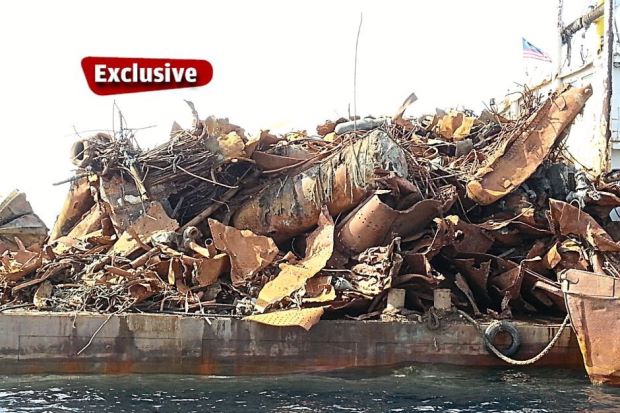
おなじくマレーシアの英字新聞THE STAR ONINEが5月22日付で
ペナン島沖で、サルベージ業者が今年に入り少なくとも5隻以上の沈船を鉄くず回収目的で当局に無許可で引き上げたと報じています
同紙によると不法引き上げの被害にあった沈船の中には旧日本海軍の軍艦、重巡洋艦「羽黒」、軽巡洋艦「球磨」、特設砲艦「長沙丸」が含まれています
•業者がマレーシア当局に無届でサルベージ作業を行っている
•沈船が漁礁として地元の大切な漁場になっており漁業者に被害が出ている
•大戦中に亡くなった水兵たちの墓標であり慰霊の場であること
などの問題点を同紙は解説し、地元から業者に対する非難や中止を求める声が上がっていることを伝えています
※引用先(2)(3)
8月14日NHKニュース9で、この件について特集が組まれ流されましたが、マレーシア現地業者と誤解しそうな表現を使われていましたので気になり調べてみました。
元ソースであるマレーシア紙THE STAR ONINEを読み、鮮明が記されているので海事ポータルからこの当該船について調べました
HAI WEI GONG 889
•IMO:8662452
•船型:クレーン船
•建造:2007年中国福建省 FUJIAN XINCHANG SHIPBUILDING
•母港:丹東
•船籍:中国→カンボジア
※引用先(4) ※引用先(5)
この違法サルベージ作業船は乗組員や船歴からして地元の業者ではなく中国の業者と見るのが妥当なようです
地元漁業者の生活の糧であり、大戦の慰霊の場であり、ダイビングスポットとして観光資源になっているペナン島沖の戦没艦船を無許可で鉄屑として転売しようという業者の行為は許されることではありません
戦時中に海没した艦船が違法サルベージ業者に狙われる事案が他にも
バタビア沖海戦で沈没した豪海軍軽巡洋艦「パース」
マレー沖海戦で沈没した英海軍戦艦「HMSプリンス・オブ・ウェールズ」「HMSレパルス」
などでも起こっており英国政府もこれら海の墓標を荒らされることに深い懸念を発しています
※引用先(6)
THE STAR ONINE紙の一連の報道に注目が集まるにつれてマレーシア当局も取り締まりに本腰を入れはじめたようですが、これ以上死者の眠りを妨げるような事のないよう願っています
Sea salvage work halted 05/23/14 (The Star Online)
by eddie chua
PETALING JAYA: A ship that illegally stripped shipwrecks off Penang island for scrap metal has been detained and impounded by the northern region Marine Department.
There was a mountain of rusty ship parts and salvage work was in progress when the agency’s officials boarded the ship, which is equipped with a crane, off Kendi Island.
The agency had been alerted about the illegal operation after The Star first discovered the salvaging there last week.
The Cambodian-registered vessel was caught red-handed dredging the Chosa Maru wreck, better known as the Japanese wreck among locals. The skipper and his nine-man crew, all Chinese nationals, have been arrested.
Aside from seizing the ship, the authorities impounded a workboat that accompanied Hai Wei Gong 889, a Chinese-made vessel that was commissioned in 2007.
“The ship does not have the documents for salvage work and was operating illegally in Malaysian waters,” a marine department official said.
The ship, workboat and its crew had been ordered to sail to Lumut, where the ship is now impounded.
“We are also investigating where the vessel had disposed the scrap metal after salvaging at least five shipwrecks off Penang, including the two Japanese World War II wrecks,” the official said.
At this point, he said, the authorities were investigating who the buyer of the scrap metal was.
“The department is also investigating how long the ship had operated in Malaysian waters illegally and whether it had looted other areas besides Penang.”
The official said the department was investigating if the vessel had plundered other ships, both commercial and military, off the east and west coast of Malaysia.
The Star reported yesterday that illegal salvagers had plundered scrap metal from at least five shipwrecks, including two Japanese World War II vessels, off Penang waters since early this year and their activities had gone undetected by the authorities.
The unscrupulous salvagers were believed to have “cleared up” at least two wrecks – the Japanese gunboat Chosa Maru, called Kapal Jepun by locals, which sunk in August 1943, and Japanese light cruiser Kuma that went down on January 1944 – and had taken away metal worth millions.
The other three wrecks that are being salvaged are Japanese warship Haguro, Kapal Taiwan and Kapal Simen, which are all located off Kendi Island.
海のない内陸国モンゴル、北朝鮮の「船舶避難所」? 04/17/14 (中央日報日本語版)
今月4日、全羅南道麗水市(チョンラナムド・ヨスシ)の巨文島(コムンド)から南東34カイリ(約63キロ)の公海上。北朝鮮船員16人が乗ったモンゴル国籍の4300トン級貨物船「グランドフォーチュン1号」が沈没した。
韓国の海洋警察は救助活動を行って5人を救助したが、2人は死亡し、追加捜索を行って1人の遺体を引き揚げた。救助された3人と遺体3体は板門店(パンムンジョム)を経由して北朝鮮に送った。海洋警察や麗水警察署などによれば、沈没した船は北朝鮮の清津(チョンジン)港から出発して中国揚州市近隣の江都港へ向けて航海中だった。重油50トンや鉄鉱石などが載っていた。韓国政府は14日、最後の遺体1体を北朝鮮に引き渡した。
グランドフォーチュン1号は海がない内陸国、モンゴル国籍の船だった。船主は香港にある会社だった。海洋水産部などは船主が「便宜置籍」の一環としてモンゴルに船を登録して賃金が安い北朝鮮船員を雇用し、貨物事業を展開していたと推測した。
便宜置籍は、自国船員の義務雇用比率を避けて税金節約のために他国に船を登録することをいう。それ自体は違法ではない。パナマやリベリア国籍の船が多いのは便宜置籍が多い国だからだ。
モンゴルは内陸国だが2003年から船舶登録局を開設して他国の船の登録を受けている。船舶登録を受けて税金を集めて海運産業を育成するためだ。ウィキリークスが2007年に公開した米国大使館の資料によれば、モンゴルには283隻が登録されている。船の主人の国籍はシンガポール(91隻)、パナマ(22隻)、マレーシア(22隻)、香港(12隻)などだった。船主が国籍不明な船も39隻あった。
北朝鮮が香港会社を代理船主として前面に出し、モンゴルに船を登録した可能性を見せている部分だ。外交部関係者は「今回のグランドフォーチュン号は、韓国領海ではない公海上で発見されたので対北朝鮮制裁決議にともなう船舶の捜索や調査を行えなかった」として「すぐに目についた重油や鉄鉱石のほかに、どんな物があったのかは確認できなかった」と話した。
先月出てきた国連安保理の対北朝鮮制裁の専門家パネル報告書によれば、国籍は北朝鮮ではないが実際は北朝鮮の船と疑われるものが最低8隻以上だった。このうちスンリ2号、グンザリ号、クァンミョン号の3隻は、今回発見されたグランドフォーチュン1号のようにモンゴルに登録されている。他国の国籍を持っており、船主は香港人である船も1隻あった。
国連対北朝鮮制裁の専門家パネルは報告書を通じて「安保理の対北朝鮮制裁決議2094号(2013年)が発効された後、北朝鮮は船舶を再登録したり国籍を変更したりして制裁を避けようとする可能性が高い」と指摘した。実際に北朝鮮は昨年だけで4隻の船をカンボジア・トーゴなどに国籍を変更した。
このような前例もある。2011年5月、北朝鮮の南浦港(ナムポハン)からミサイル武器などと推定される部品を載せてミャンマーへ向かった「ライト」号は、米国海軍の追撃を受けると公海上にとどまって回航した。ライト号は2006年まで「ブヨン1号」という名前を使う北朝鮮国籍の船舶だったが、北朝鮮核実験後に対北制裁が激しくなると名前を「ライト」に変えて国籍も中米のベリーズに変更して運行した。「ライト」号は米国の取り締まりがあってから2カ月後、アフリカのシエラレオネで国籍を変えて船の名前も「ビクトリー3号」に変更した。国連の対北朝鮮制裁の専門家パネルは、国籍を「洗浄」した北朝鮮の船が19隻以上に上ると推定している。
Transcript shows ferry captain delayed evacuation 04/17/14 (Star-Telegram)
By FOSTER KLUG and YOUKYUNG LEE
The Associated Press
MOKPO, South Korea - Fresh questions arose about whether quicker action by the captain of a doomed ferry could have saved lives, even as rescuers scrambled to find hundreds of passengers still missing Friday and feared dead.
Officials also offered a rare look at their investigations, saying they were looking into whether a crewman's order to abruptly turn the ship contributed to the 6,852-ton Sewol ferry tilting severely to the side and filling with water Wednesday.
The confirmed death toll from Wednesday's sinking off southern South Korea was 28, the coast guard said. Most of bodies have been found floating in the ocean because divers have been continually prevented from getting inside the ship by strong currents and bad weather. But 48 hours after the sinking the number of deaths was expected to rise sharply with about 270 people missing, many of them high school students on a class trip. Officials said there were 179 survivors.
New questions were raised by a transcript of a ship-to-shore exchange and interviews by The Associated Press that showed the captain delayed evacuation for half an hour after a South Korean transportation official ordered preparations to abandon ship.
The order at 9 a.m. by an unidentified official at the Jeju Vessel Traffic Services Center to put on lifejackets and prepare for evacuation came just five minutes after a Wednesday morning distress call by the Sewol ferry. A crewmember on the ferry, which was bound for Jeju island, replied that "it's hard for people to move."
The ship made a sharp turn between 8:48 a.m. and 8:49 a.m. Korea time, but it's not known whether the turn was made voluntarily or because of some external factor, Nam Jae-heon, a director for public relations at the Maritime Ministry, said Friday.
The captain has not spoken publicly about his decision making, and officials aren't talking much about their investigation, which includes continued talks with the captain and crew. But the new details about communication between the bridge and transportation officials follow a revelation by a crewmember in an interview with The Associated Press that the captain's eventual evacuation order came at least half an hour after the 9 a.m. distress signal.
Meanwhile, strong currents and rain made rescue attempts difficult again as they entered a third day. Divers worked in shifts to try to get into the sunken vessel, where most of the missing passengers are thought to be, said coast guard spokesman Kim Jae-in.
Coast guard officials said divers began pumping air into the ship Friday, but it wasn't immediately clear if the air was for survivors or for a salvage operation. Officials said in a statement that divers were still trying to enter the ship.
South Korean officials also offered a glimpse into their investigation of what may have led to the sinking. They said the accident happened at a point where the ferry from Incheon to Jeju had to make a turn. Prosecutor Park Jae-eok said in a briefing that investigators were looking at whether the third mate ordered a turn whose degree was so sharp that it caused the ship to list. The captain was not on the bridge at the time, Park said, adding that officials were looking at other possible causes, too.
Park also said crews' testimonies differed about where the captain was when the ship started listing. As that listing continued, the captain was "near" the bridge, Park said, but he couldn't say whether the captain was inside or right outside the bridge.
The operator of the ferry added more cabin rooms to three floors after its purchase the ship, which was built in Japan in 1994, an official at the private Korean Register of Shipping told the AP on Friday.
The official, who spoke on condition of anonymity because the person was not allowed to discuss matters under investigation, said the extension work between October 2012 and February 2013 increased the Sewol's weight by 187 tons and added enough room for 117 more people. The Sewol had a capacity of 921 when it sank.
As is common in South Korea, the ship's owner, Chonghaejin Marine Co. Ltd, paid for a safety check by the Korean Register of Shipping, the official said, which found that the Sewol passed all safety tests, including whether the ship could stabilize in the event of tilting to the right or to the left after adding more weight.
Ian Winkle, a British naval architect and ferry expert said many ships have such modifications, to increase capacity, for instance. "In this particular case, it would have affected the stability by a small amount, but as it seems from the structure of the vessel, generally, it looks as if it was adequate to meet statutory regulations," Winkle said.
Near the site of the ferry, angry and bewildered relatives gathered on a nearby island watched the rescue attempts. Some held a Buddhist prayer ritual, crying and praying for their relatives' safe return.
"I want to jump into the water with them," said Park Geum-san, 59, the great-aunt of another missing student, Park Ye-ji. "My loved one is under the water and it's raining. Anger is not enough."
Kim, the coast guard spokesman, said two vessels with cranes arrived and would help with the rescue and to salvage the ferry, which sank not far from the southern city of Mokpo. But salvage operations hadn't started yet because of the rescue attempts.
Out of 29 crewmembers, 20 people, including the captain, Lee Joon-seok, 68, survived, the coast guard said.
The captain made a brief, videotaped appearance, although his face was hidden by a gray hoodie. "I am really sorry and deeply ashamed," Lee said. "I don't know what to say."
Kim Soo-hyun, a senior coast guard official, said officials were investigating whether the captain got on one of the first rescue boats.
The 146-meter (480-foot) Sewol had left Incheon on the northwestern coast of South Korea on Tuesday for the overnight journey to the southern resort island of Jeju. There were 475 people aboard, including 325 students from Danwon High School in Ansan, which is near Seoul,
It was three hours from its destination Wednesday morning when it began to list for an unknown reason.
Oh Yong-seok, a helmsman on the ferry with 10 years of shipping experience, said that when the crew gathered on the bridge and sent a distress call, the ship was already listing more than 5 degrees, the critical angle at which a vessel can be brought back to even keel.
The first instructions from the captain were for passengers to put on life jackets and stay where they were, Oh said.
A third mate reported that the ship could not be righted, and the captain ordered another attempt, which also failed, Oh said. A crew member then tried to reach a lifeboat but fell because the vessel was tilting, prompting the first mate to suggest to the captain that he order an evacuation, Oh said.
About 30 minutes after passengers were told to stay in place, the captain finally gave the order to evacuate, Oh said, adding that he wasn't sure in the confusion and chaos on the bridge if the order was relayed to the passengers. Several survivors told the AP that they never heard any evacuation order.
By then, it was impossible for crew members to move to passengers' rooms to help them because the ship was tilted at an impossibly acute angle, he said. The delay in evacuation also likely prevented lifeboats from being deployed.
"We couldn't even move one step. The slope was too big," said Oh, who escaped with about a dozen others, including the captain.
The last major ferry disaster in South Korea was in 1993, when 292 people were killed.
Klug reported from Seoul. Associated Press writers Hyung-jin Kim in Ansan and Jung-yoon Choi in Seoul contributed to this report.
「この訴訟で、賠償命令が出ても日本の判決は中国国内での効力はない。賠償金を得られる見込みは低いが、夏被告を雇う船主側にも責任があると示し、交渉のテーブルにつかせるのが狙い。代理人は『交渉が進まないなら雇用会社側などを相手に中国で提訴するのも選択肢だ』と話した。」
かわいそうだけど中国で提訴してもお金を時間を無駄にするだけだ!日本の政府だって中国政府相手に適切な対応が出来ていいない。外国では賄賂や不正が横行している国も多い。正しければ勝てるとは思わない方が良い。損害賠償が必要ならば国土交通省を訴えるべきだ。
PSC(外国船舶監督官)が国外での操船免許を持たない船員が躁船する船が日本に入国していたのを知っていた。
STCWにより問題ないと当時の名古屋のPSC(外国船舶監督官)が多くの人達の前で発言したのを覚えている。
国土交通省が問題を放置したことが間接的に事故に繋がったと主張するほうが良いのでは???当時の神戸のPSC(外国船舶監督官)もこの問題を知っていたはずだ!「中国船員の免状(制限の定義)について」とのタイトルで神戸のPSC(外国船舶監督官)に2009/02/18にメールしているから間違いない。
PSC(外国船舶監督官)及び室長にいろいろと質問とか事実を報告したけど、現状はあまり変わらない。無視しているのかと思うぐらいだから、仕方が無い。JR北海道のレール計測データ改ざん問題だって20年近く放置されていた。その間、監査は定期的に適切に行われていたとのこと。これが日本の現状だ。サブ・スタンダード船で入港したら、出港させないような検査もおこなっていない。中型及び小型外国船籍船は危険なサブ・スタンダード船と指示を出して避けるように運航するしかない。
今後のために、日本に入港する外国船籍船舶の最低保障額を上げる働きかけを行う事も良いだろう。
貨物船衝突事故・栄福丸 進まぬ補償、遺族焦り 02/08/14(中日新聞)
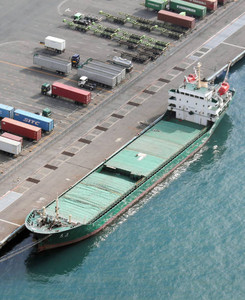
伊豆大島沖で第18栄福丸と衝突事故を起こし、
係留されている貨物船「ジィア・フイ」=1月7日、
静岡市の清水港で、本社ヘリ「あさづる」から
◆中国人当直責任者 14日判決
昨年九月に東京・伊豆大島沖で貨物船同士が衝突し、名古屋市の海運会社が所有する「第18栄福丸」の乗組員六人が死亡した事故で、相手方の「JIA HUI」(ジィア・フイ)の中国の船主側が栄福丸の船体補償交渉に応じない状況が続いている。事故当時のジィア・フイの当直責任者で、業務上過失致死罪などに問われた中国籍の夏紅波被告(36)の十四日の判決に執行猶予が付けば釈放になる。栄福丸関係者から、判決後のさらなる停滞を懸念する声があがる。
焼津市の高井智昭さん=当時(40)=ら乗組員六人への遺族補償では、ジィア・フイ側の保険会社が最大五億三千八百万円を提示したとされる。先月の静岡地裁沼津支部の公判で夏被告側が明らかにした。栄福丸を所有する丸仲海運(名古屋市港区)の杉下吉利社長(64)は「具体的な交渉はまだのようだ」と話す。遺族の一人は、公判で提示額を初めて知ったほどで「船主側に誠意ある対応がみられず、夏被告が中国に帰ると話が停滞するのではないか」と気をもむ。
ジィア・フイの船主側との間では船体などの補償も滞っている。栄福丸は船体だけで損失は四億九千万円。積み荷や逸失利益などを合わせると損失は十億円を超えるという。丸仲海運には損保会社から保険金が支払われたが、沈没した栄福丸が稼働できなくなったことによる逸失利益は対象外で、毎月千三百万円の損失が出ている。
ジィア・フイの船主側からは、今も謝罪の電話さえなく、中国の保険会社は、国外での操船免許を持たない夏被告が当直責任者だったことが免責に当たると主張。交渉に入れない状態が続く。損失をわずかでも回収したい栄福丸側は昨年十二月、静岡地裁にジィア・フイの差し押さえを申し立てたが、地裁の決定はまだ出ていない。
丸仲海運に保険金を払った損保会社は先月二十日、夏被告に一億円の損害賠償を求める裁判を起こした。夏被告の過失で事故は起きたとして、船価の一部を請求している。
この訴訟で、賠償命令が出ても日本の判決は中国国内での効力はない。賠償金を得られる見込みは低いが、夏被告を雇う船主側にも責任があると示し、交渉のテーブルにつかせるのが狙い。代理人は「交渉が進まないなら雇用会社側などを相手に中国で提訴するのも選択肢だ」と話した。
(斉藤明彦)
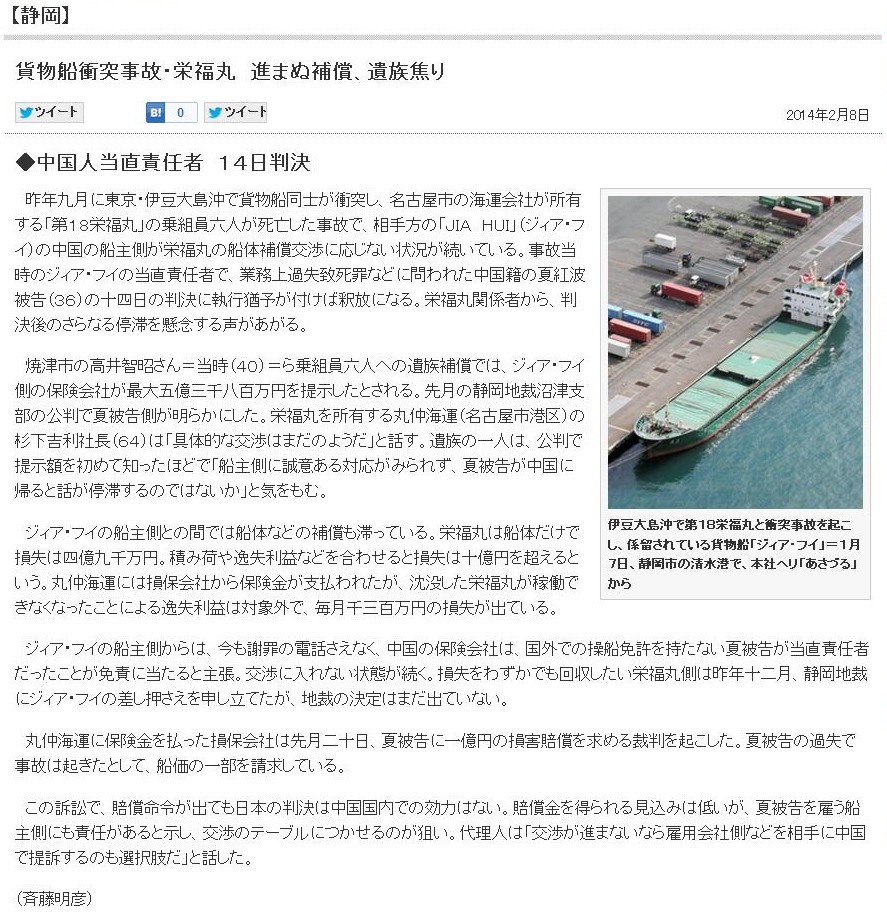
韓国で飢餓に瀕した船員を、ITFが援助 No.24/2010(国際運輸労連 - ITF TOKYO)
韓国のITFコーディネーター、キム・ヘキョン(金 恵璟)
ITFは2009年4月、韓国の平澤(ピョンテク)港の船舶から連絡を受けた。この船の乗組員の1人が、本船には食料も飲料水もない、と連絡してきた。中国・大連の船主、オリエンタル・デベロプメント社からの連絡が途絶えており、乗組員は賃金も受け取っていなかった。
この船は、貨物が損傷していたため、第三者により、3月に差し押さえられていた。
ITFは、船主と連絡を取ろうとしたが、成功しなかった。ソウルの中国大使館は、韓国によって本船が差し押さえられているため、未払い賃金、食料、飲料水の供給など、全ての問題は韓国側が処理すべきである、と支援を拒否した。
インスペクターは乗組員を訪問し、未払い賃金および帰国旅費に関する法的手続きを開始した。同時に、キム・ヘキョンITFコーディネーターは、ITF海事活動部門に連絡するとともに、問題解決のため、中国大使館と話し合った。
ITFと会うことを船主は遂に受け入れたが、問題の解決には同意しなかった。彼らの主要な関心事は乗組員ではなく、船舶にあった。彼らは、食料と飲料水の供給を拒否し、乗組員と会うことさえ拒否した。
乗組員は飢えに瀕している、とITFに伝えられたため、韓国の組合が250米ドル相当の食糧と飲料水を提供した。船主は、数回にわたり韓国を訪問していたにもかかわらず、何の措置も支援も提供しなかった。そのため、韓国のインスペクターは、法的手続きの決着を待たずに、船員たちを帰国させることとした。
韓国海員労組連盟(FKSU)のバン・ドンシク委員長と乗組員の話合いの中で、ITFは9人の乗組員の帰国旅費を負担することに同意した。9人のうちの7人は帰国することを決めたが、船長と機関員は船内に残った。未払い賃金を手にするのは容易ではないと思われるが、ITFは現在、法的措置の結果を待っている。
‘Wrongful death’ lawsuit over Dongwon-linked vessel sinking at heart of US licence fraud allegations 02/14/14 (Undercurrent News)
Tom Seaman
An ongoing legal process brought against Dongwon Industries by a woman widowed by the June 2010 sinking of purse seiner Majestic Blue is the origin of latest fraud allegations against the South Korean company, owner of US brand Starkist.
Dongwon is accused, in an amended claim filed on Jan. 10 in the US district court for Delaware, of using straw companies to control Majestic Blue and another seiner, Pacific Breeze, to gain access to fishing licenses for which only US citizens are eligible.
Pacific Breeze and Majestic Blue were registered in South Korea prior to 2008 and named Eastern Kim and Costa de Marfil, respectively, which would have excluded them from licensing eligibility, the claim document states.
The allegations contained in the claim, from law firm Moore & Company, are linked to two separate ongoing legal processes around the sinking of Pacific Breeze and the death of its skipper, David Hill.
This was referenced in a statement sent to Undercurrent News from Dongwon on Tuesday.
Moore & Company “is currently representing a client in ongoing, related litigation against Dongwon”, reads the statement from the tuna giant. “The allegations made by the Moore law firm are meritless, and intends to vigorously defend itself in this matter, including seeking a full dismissal of the action”.
The legal action referred to by Dongwon is the lawsuit filed in October 2010 by Amy Hill, the widow of David, alleging wrongful death. Moore are seeking at least $5 million in damages.
On Nov. 5, 2010, Majestic Blue was served with a copy of the summons and complaint, then, on Dec. 9, 2010, filed the instant action seeking limitation of its liability for the claim.
Both legal processes are ongoing.
Moore has “contested Majestic Blue Fisheries’ right to limit its liability for the sinking”, Blair Brogan, of the law firm, told Undercurrent. “The court is currently making its decision on whether Majestic Blue is entitled to limit its liability, all papers and arguments having been submitted.”
In the wrongful death lawsuit, the defendants are Majestic Blue Fisheries LLC and Dongwon, which it is alleged controlled Majestic Blue.
“The wrongful death action, against both Majestic Blue and Dongwon, is currently stayed pending the court’s decision in the limitation action,” Brogan said.
If the ship owner were entitled to limit its liability in this particular case, liability would be limited to the remaining value of the vessel, nothing, the vessel’s equipment and appurtenances ($33,500), and any pending freight, also nothing, said Brogan.
“Thus, the owner would be able to limit its liability to $35,000 in the wrongful death action,” she said.
‘State of the art’ seiner
On Oct. 13, 2009, Hill entered into an employment contract to act as the skipper of Majestic Blue, which was represented “state of the art purse seiner that was 100% owned by United States citizens and “proudly” flew the US flag”, states the claim document from Moore, on behalf of Hill.
Hill’s contract was for three months onboard, followed by a three-month vacation period, after which time his contract contemplated that he would return for another three-month period on board.
Hill was began his second term as captain of the vessel in May 2010, immediately following a maintenance period in a Chinese shipyard. He relieved the former captain, another US national named Thomas Ridenour.
Ridenour directly observed the work done to the vessel in the Chinese shipyard, states the claim document.
According to Ridenour, the vessel had not been well repaired and the work done by the Chinese yard was below industry standard.
Ridenour observed, the document states, that the combination of Dongwon and Majestic Blue not allowing the Chinese shipyard sufficient time, a lack of planning, lack of communication, lack of coordination, and poor quality of work by the Chinese shipyard had caused serious problems for Majestic Blue.
Ridenour observed the vessel would not be able to pass any sort of detailed inspection and doubted any United States Coast Guard inspector would pass it, it is alleged.
Ridenour also commented that he would not work for the company again and that he was “personally ashamed” to have his name linked with the dry-docking of the vessel in China, the document states.
Around May 9, 2010, at the very end of the dry dock period, Hill arrived in Guam to meet the Majestic Blue and relieve Ridenour.
Hill was the only US national and was one of very few people on the vessel who spoke English. Dongwon or Majestic Blue did not provide a translator, “even though it was standard practice on other similar vessels” and despite previous captains having requesting translators, the claim alleges.
All of the officers on the vessel, aside from Hill, were Korean nationals and all of the remaining crew were either Korean nationals or nationals from other Southeast Asian countries, it claims.
The fishing master on the vessel “acted as the de facto captain” and yet was allegedly unqualified for the position. “For instance, when leaving the port of Guam the fishing master went the wrong direction and the vessel was forced to turn back to rejoin the rest of the purse seiner fleet”, the document states.
It goes on to state that the US national captains hired by Dongwon and Majestic Blue “were “window dressing”, brought onboard to meet the crewing requirements of the US vessel registry and not to command the Korean-operated, managed and de facto owned purse seiner.
The Korean “fishing master” was the actual master and captain of the vessel and was, along with the Korean officers, tacitly or in fact authorized by Dongwon and Majestic Blue to ignore the orders of the US captain, Hill’s claim states.
A former skipper of the vessel, Douglas Pine, sued Dongwon and Majestic Blue in April 2010, alleging mutiny, abuse by the crew and pollution violations.
Dongwon and Majestic Blue “also made no effort to correct the shoddy, rushed and low quality ‘repairs’” to the vessel, despite having knowledge of the problems through Ridenour, who admitted it would be unable to pass any sort of detailed inspection, it is alleged.
Around May 20, 2010, Hill and the vessel departed the US territory of Guam to commence a fishing expedition.
The vessel began taking on water around June 13, 2010, in what the claims states were “calm seas and good weather”.
Of the 24 crewmembers on board at the time, 22 abandoned ship and were later rescued by another purse seiner, Pacific Breeze, the other vessel that is the subject of the license fraud allegations against Dongwon and Majestic Blue.
Hill and the chief engineer remained “or were either negligently or intentionally left onboard the sinking vessel, which at some point rolled on its side and sank to the bottom of the Western Pacific Ocean”.
After two days of search and rescue by the United States Coast Guard and certain vessels of the purse seiner fleet, neither the chief engineer nor Hill were found, having drowned with the vessel.
The family of the Chief Engineer, Chang Cheol Yang, filed a lawsuit against Dongwon and Majestic Blue for compensation for his wrongful death on June 11, 2013. This process is also ongoing.
Subsequent to the sinking, it is alleged the defendants retained certain of Hill’s personal effects -- including the personal laptop he carried with him through his tour.
This was kept for nearly two months until they were finally returned to his wife, after repeated calls for their return by her attorneys.
In this time, it is alleged the defendant’s accessed the personal computer of Hill and viewed “intimate correspondences” and emails between the married couple. “The invasion was a gross invasion of privacy into an area any reasonable person would deem private from public gaze and was totally unwarranted,” the claim alleges.
When a memorial service was held for Hill, “without prompting or invitation”, Dongwon and Majestic Blue sent two employees. In addition, agents of the company have Amy Hill with any information regarding her husband’s death, the document states.
Hill ‘responsible for own death’
In its response, filed on May 15, 2013, Dongwon states it was not Hill’s employer and, therefore it cannot be held responsible for the claims presented under the doctrine of un-seaworthiness.
“Dongwon did not own, operate, manage or charter the subject vessel and, therefore cannot be charged with liability attributable and/or flowing from ownership,” it states.
According to the document, “Hill failed to follow lawful orders to evacuate the Majestic Blue and his failure to do so caused his death”.
The sinking and Hill’s “death occurred due to the natural action of wind and wave for which Dongwon has no responsibility”.
He also failed to properly utilize the vessel’s bilge pumps, alarms, communications equipment, life rafts and other safety measures at the time of the sinking, it alleges.
In addition, Hill failed and refused to accept the assistance and instruction of the other crewmembers and his failure solely caused “and/or contributed” to his death.
He was not instructed or directed to remain onboard the vessel, “nor was it necessary for him to remain onboard once all crewmembers had abandoned ship and were disembarked”, states Dongwon’s defense.
Hill “recklessly and/or negligently and/or intentionally remained onboard in open and obviously unsafe conditions without notice of any kind to Dongwon and without the use of safety equipment”, and was “responsible for his own death in that his normal faculties were impaired”.
He also “failed to maintain a seaworthy vessel”, Dongwon claims.
|
From(Maritime Connector.com)
|
|---|
|
Ship Name:
|
PACIFIC BREEZE
|
|---|
|
Type of Ship:
|
FISHING VESSEL
|
|---|
|
Flag:
|
U.S.A.
|
|---|
|
IMO:
|
7395624
|
|---|
|
Gross Tonnage (ITC):
|
1039 tons
|
|---|
|
Year of Built:
|
1975
|
|---|
|
Builder:
|
TACOMA BOATBUILDING - TACOMA WA, U.S.A.
|
|---|
|
Class Society:
|
KOREAN SHIPPING REGISTER
|
|---|
|
Manager & owner:
|
PACIFIC BREEZE FISHERIES - PITI, GUAM
|
|---|
|
Former name:
|
- EASTERN KIM until 2009 Dec
- SHIN CHEON NO.2 until 1988 Jan
- JALMI until 1984 Jan
- NIOMRE until 1975 Dec
|
|---|
MAJESTIC BLUE IMO 7207358 (ShipSpotting.com)
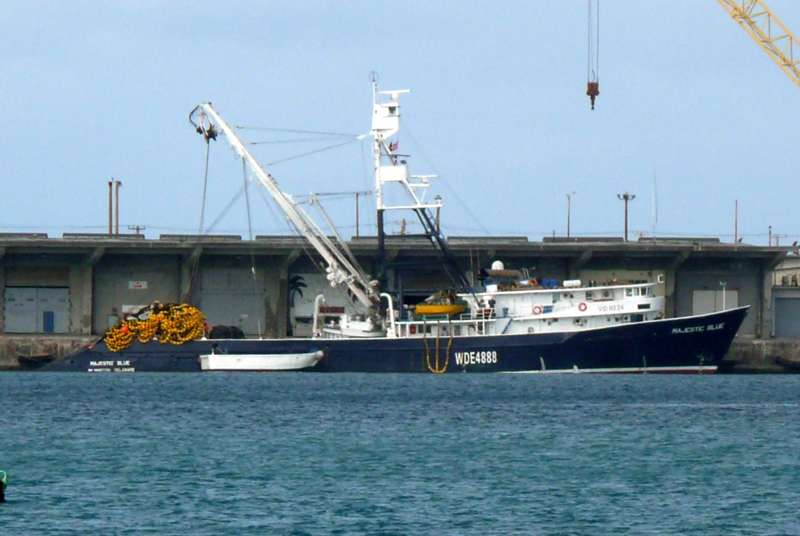
|
From(Maritime Connector.com)
|
|---|
|
Ship Name:
|
MAJESTIC BLUE
|
|---|
|
Type of Ship:
|
FISHING VESSEL
|
|---|
|
Last known flag:
|
U.S.A.
|
|---|
|
IMO:
|
7207358
|
|---|
|
Gross Tonnage (ITC):
|
1172 tons
|
|---|
|
Year of Built:
|
1972
|
|---|
|
Builder:
|
MARITIMA DEL MUSEL - GIJON, SPAIN
|
|---|
|
Former name:
|
COSTA DE MARFIL until 1972
|
|---|
船舶代理店代表取締役等を虚偽通報により検挙(名古屋海上保安部) 2008(海上保安庁)
名古屋海上保安部は、船舶代理店取締役が通報する国際航海・港湾保安法に基づく船舶保安情
報(事前通報)について、通報時点における船舶の位置が不正確であることが多かったことから
、同取締役に対し適正な通報を実施するよう、その都度指導していたにもかかわらず、平成20年1
0月に韓国から名古屋港に入港したツバル籍貨物船(1,845トン)の入港に際し通報時点における
船舶の位置、本邦の港に入港する直前の寄港に関する事項等、事実と異なる船舶保安情報を名古
屋海上保安部に通報したことから、同取締役及び当該船舶代理店を同法違反で検挙しました。
日本人船長の中には、サブ・スタンダード船や能力や訓練に関して問題のある船員が操船する船舶が
海難や重大な事故を引き起こす可能性をブログやホームページで指摘している。いくら指摘しても、
PSC(外国船舶監督官)
に問題を問題として指摘できる能力や知識が欠如していれば検査しないよりは良い程度の結果した期待できない。
公開されている情報やデーターが現実の状態を反映しているとは限らない。データの集計を操作しなくとも、(評価)データが正確でなければ
データが集計されたものの信頼性は低いと考えられる。データの集計が正しいと仮定して方針や活動しても、データの集計に信頼性がなければ
仮定の下の方針や活動も効果的に結果として現れないだろう。
外国で操船することはできない船員資格しか所持していない船員が乗っている外国籍船はこの船だけではない。他の船でも同じような問題を抱えた船を知っている。
中国政府も日本の特定の領海で操船出来ない事を認識している書類を見た事がある。しかし日本のPSC (外国船舶監督官)がそのような問題を指摘した事実は聞いたことがない。直接、日本のPSC (外国船舶監督官)達にこれは問題ではないのかと指摘した事がある。回答は、「外国籍船が日本の近海や沿海区域に既に入っていれば問題ない」だった。「中国から外国船籍船がどのようにして日本の沿海区域に来れるのか?違反ではないのか。」との質問には、「どのような航路で来たのかは確認出来ないので違反だと断定できない。」だった。
アフリカ・シエラレオネ船籍「JIA HUI(ジィア・フイ)」の船主責任保険(PI保険)会社は喜んでいるだろう。外国で操船することはできない船員資格の船員が躁船していたとなると保険金を支払わなくて良いはずだ。
上記の件について興味がある新聞記者は国土交通省に問い合わせをして確認すれば良い。
参考までにこれが問題として指摘した中国船員のライセンスのコピー
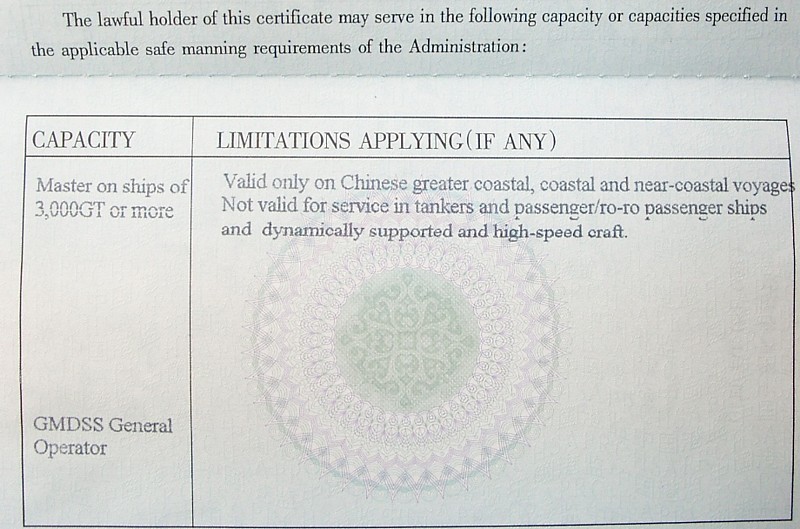
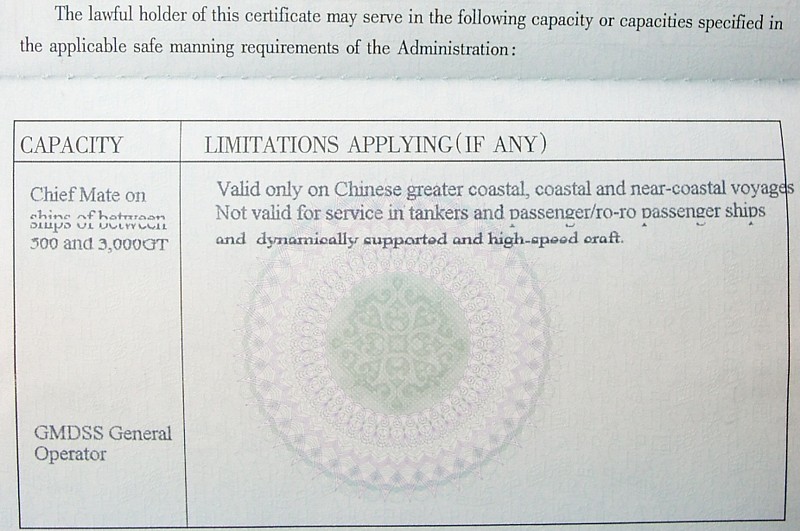
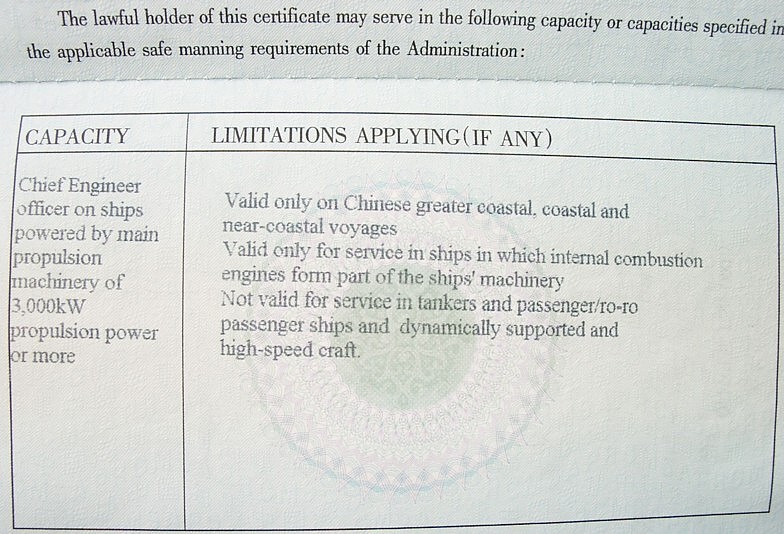
これが下記の記事と同じ問題であれば、現在も同じようなライセンスを持った中国船員が躁船している外国船籍船が日本の港に入港しているはずだ。
追加情報としては韓国のPSC(外国船舶監督官)は上記の点を不備として指摘し出港停止命令を出したことがある。
中国操船者は無免許 9月の貨物船衝突 外国での乗務も初 12/01//13 (東京新聞 朝刊)
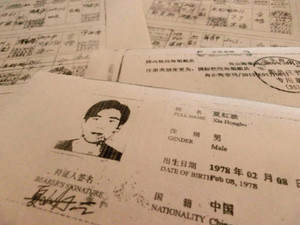
夏紅波被告の船員証書や乗船記録などのコピー。外国で操船する資格は持っていなかった=今村太郎撮影
東京・伊豆大島沖で九月、名古屋市港区の丸仲海運が所有する貨物船「第18栄福丸」が中国企業所有の貨物船と衝突し、栄福丸の乗組員六人が死亡した事故で、中国側の貨物船を操船していた中国人乗組員、夏紅波被告(35)=業務上過失往来危険の罪などで起訴=が船の運転資格を持っていない「無免許操船」だったことが分かった。事故回避の国際ルールを熟知していなかった可能性があり、中国企業側のずさんな運航管理が事故を招いたとみられる。 (上海支局・今村太郎、名古屋社会部・谷悠己)
中国企業の貨物船は、アフリカ・シエラレオネ船籍「JIA HUI(ジィア・フイ)」(二、九六二トン)。衝突は九月二十七日午前一時二十五分ごろ、伊豆大島の西方約十一キロの海上で発生し、栄福丸は転覆した。
ジィア・フイを運航、管理していた中国企業関係者や中国海事当局によると、衝突当時に当直で操船を担当していた夏被告は「丙類二副」という船員資格を持っているが、外国で操船することはできない。さらに、外国での乗船業務は今回が初めてだった。
事故当時の状況では、国際規則に基づき、ジィア・フイが右にかじを切って回避する義務があった。だが、起訴状などによると、夏被告は事故直前、かじを握る船員に左へ切るよう指示したとされており、国際規則を順守しなかったことが事故原因とみられる。
ジィア・フイは浙江省寧海県の「中和海運有限公司」が所有するが、事故当時は同省寧波市に拠点がある「嘉恵海運有限公司」に貸し出され、同社が契約した乗組員十三人が乗船していた。うち三人は操船免許を持っていたが、事故当時はいずれも就寝中だった。
嘉恵海運の楼舟豪・総経理は「夏被告は事務職としてジィア・フイに乗り込んだ。なぜ夏被告が操船していたのか分からない」と話している。
事件をめぐっては、十二月十三日に静岡地裁沼津支部で夏被告の初公判がある。夏被告が操船していた理由や状況とともに、中国企業側の管理責任も焦点となりそうだ。
【稚内発】民間会社が自己資金で放置ロシア船を回収処分 05/21/08(月刊誌「北方ジャーナル」)
北海道の沿岸で、ロシア船籍の貨物船が海難座礁を起こし、そのまま放置されるという事例が数件発生し問題となっている。
稚内市に本社のある志田船舶工業株式会社(志田茂晴社長)は、関係官庁などと協議の上、5月19日から自社のクレーン船を使って、自費で放置ロシア船の回収処分作業を開始した。
放置座礁船は、船主が船舶の燃料油による沿岸・海上の油濁損害や座礁船体の撤去にかかる費用を支払う保険に加入していなかったために起きる。近隣の自治体が撤去費用を拠出する事例が増加しているが、財政難にあえぐ自治体の大きな負担になっている。
このような事例を解決するために、平成17年3月1日から外国航路に就航する総トン数100トン以上の船舶に対しこれらの費用を保障する船主責任相互保険(PI保険)などに加入しなければ、日本の港湾に入港することができなくなった。
しかし、極東地方や日本海を往来するロシア船が増加する一方で、同国の船舶は老朽化がすすんでいる。ある商社員は、「日本海やオホーツク海の荒海を、こんな船でよく運んでくるよ。ロシアの船はいつ沈没してもおかしくないなと思うような古い、赤さびた船ばかりだ」と語る。
この問題にからんでは、数年前に、駐日ロシア大使が法的責任は船主にあるが「ロシア政府にもモラル(道義)上の責任はある」と認めたように、老朽船の運航を事実上放置しているロシア政府の責任も問われるところだ。同時に、ロシア船舶の老齢化、ロシア極東地方に出入りする老齢タンカーなどの増加で日本海地域の危険性が高まっていることを承知していながら、対策をとってこなかった日本政府の責任も重大と言わねばならない。
志田社長は、「放置船を放置しておくことは、危険でもあり、美観も損ねることになる。自治体財政が厳しい折に税金を使って処分することも考えもの。自分でできることは率先して協力したい」と話している。(稚内「週刊市民の声」代表・石井栄三)
四国新聞の記者の調査不足であるが、「四国内での航行停止命令は過去10年で2例目。」は間違い。もっと多くの
が四国で出港停止命令を受けている。しかしながら、他のエリアと比べると
出港停止命令を受けるサブスタンダード船は少ない。
「中国籍の船長らが他国籍船に乗船するための許可証明書を所持しておらず、汚水処理装置やコンパス、窓の故障・破損も判明した。
是正と中国での修理を命じられ、8月13日に中国へ出港した。しかし、今月14日に再入港した際の立ち入り検査で、
改善されていないことが分かった。」
船主、船舶管理会社及び検査会社が日本の
PSCをなめているのがよくわかる。TOKYO MOU
のデータ(下記にコピー)から判断しても「グアン・シアン3」(GUAN XIANG 3:IMO8974996)はサブスタンダード船
であり、サブ・シッピングであることがわkる。
船主、船舶管理会社及び検査会社にサブスタンダード船の
ままでは日本に入港することができないし、サブスタンダード船の状態で出港停止命令を受ければ、
不備の是正や修理が中国で行う以上に費用が掛かることを理解させるために、全ての不備が是正され、完全な修理が行われるまで宇和島港から出港させる
べきでない。
ある問題のある検査会社の検査官が言っていた。検査会社
が検査した船舶が不備で出港停止命令を受けたら、日本での修理費用はすごく高いことをアピールして、反省したフリをすれば簡単に出港させてくれる。
日本のPSCは検査も甘いが、対応も甘いので馬鹿にされているのがよくわかる。
日本人として恥ずかしいがこれが公務員達の現実なのである。彼らの上司であるキャリア官僚達も馬鹿にされても自分達の出世や給料に影響がなければ
穏便にする方が良いと考えているのかもしれない。外務省の税金泥棒職員は外務省にはFAXが無いと平気で言うのだからタチが悪い。そんな言い訳など
通用すると思っているのか、よほど国民を馬鹿にしているとしか思えない対応を取る。名前を聞くと名前を名乗らない。一度、総務省に電話して
公務員は自分の名前を名乗る義務はないのかと抗議したことがあるくらいだ。その時は、少なくとも苗字は名乗る必要があると言っていた。
こんなことだから領土問題ないど解決できるわけもないし、まともに仕事をするわけがないと思っている。話は元に戻るが、
PSCは3日に一度は「グアン・シアン3」(GUAN XIANG 3:IMO8974996)を訪船して更なる
不備があれば指摘して出港前に是正させるべきである。
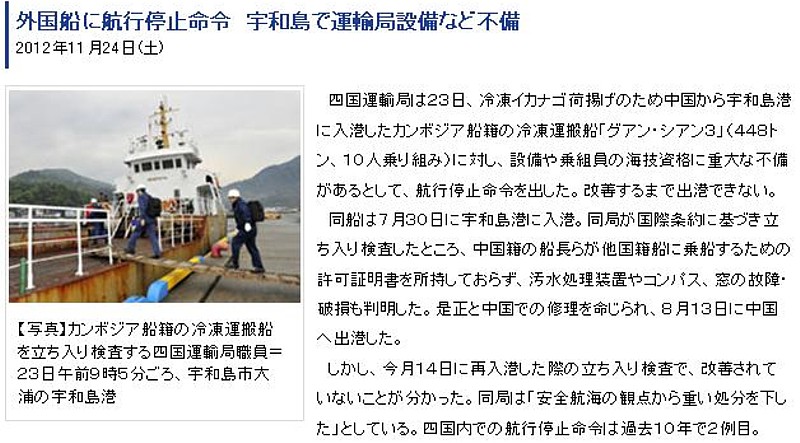
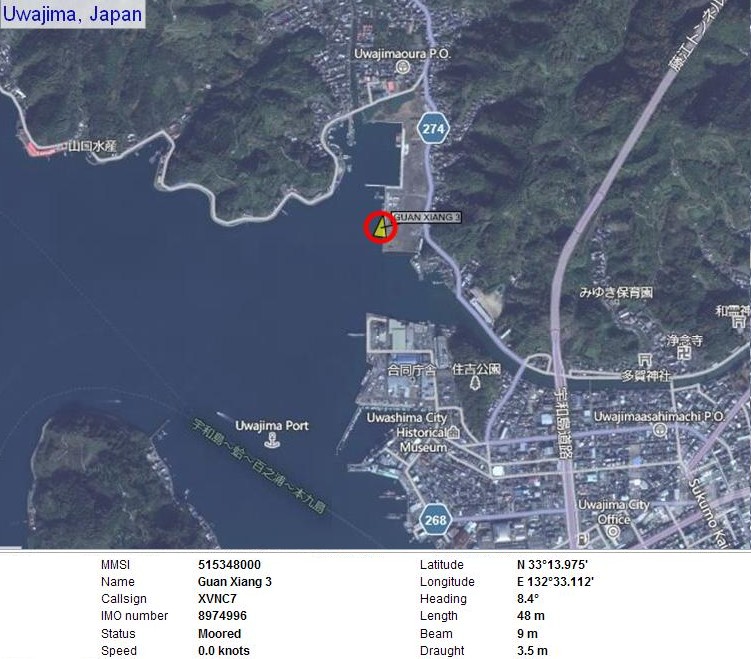

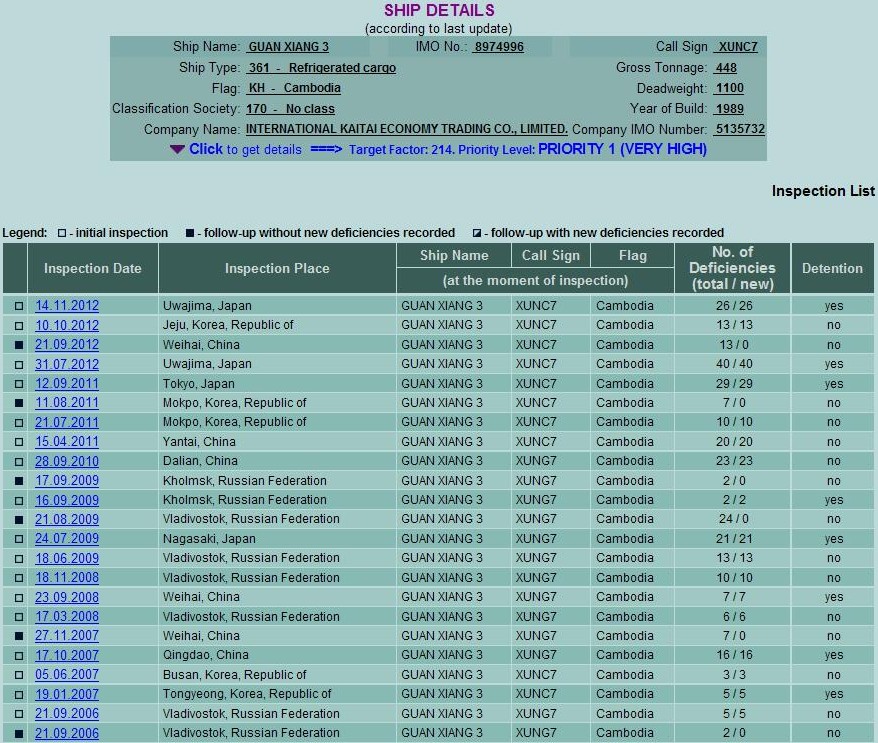
TOKYO MOUのサイトより
外国船に航行停止命令 宇和島で運輸局設備など不備 11/24/12(愛媛新聞)
四国運輸局は23日、冷凍イカナゴ荷揚げのため中国から宇和島港に入港したカンボジア船籍の冷凍運搬船「グアン・シアン3」(448トン、10人乗り組み)に対し、設備や乗組員の海技資格に重大な不備があるとして、航行停止命令を出した。改善するまで出港できない。
同船は7月30日に宇和島港に入港。同局が国際条約に基づき立ち入り検査したところ、中国籍の船長らが他国籍船に乗船するための許可証明書を所持しておらず、汚水処理装置やコンパス、窓の故障・破損も判明した。是正と中国での修理を命じられ、8月13日に中国へ出港した。
しかし、今月14日に再入港した際の立ち入り検査で、改善されていないことが分かった。同局は「安全航海の観点から重い処分を下した」としている。四国内での航行停止命令は過去10年で2例目。
客船座礁 客が自力で救命具探す 乗員は救命ボートの降ろし方も知らず(01/16/12) (スポニチ)
イタリア中部沖で豪華客船コスタ・コンコルディアが座礁した事故では、乗客への避難誘導がほとんどなされないなど船会社側の危機管理上の問題点が乗客の証言から浮き彫りになっている。
事故に遭遇した東京の自営業の男性(52)は「乗客に避難を促すアナウンスは一度もなかった」と振り返る。座礁の衝撃があったのはレストランにいた13日午後9時半すぎ。船が傾き始めたにもかかわらず「機械のトラブル。心配ない」との放送が2回繰り返された。
約1時間後に突然、緊急を知らせるサイレンが鳴った。レストランの客は一斉に出口に向かって走り、デッキにあった救命具を自力で探し当てて身に着けた。
男性は「指揮命令系統が全く機能していなかった」と指摘。乗客乗員の脱出が完了する前に船長が船から避難していたことについては「われわれを見捨てて逃げるとは腹立たしい」と話した。
地元メディアによると、乗員の多くはフィリピン人などの外国人でイタリア語を話せず、乗客同様パニックに陥る者もいた。避難対応をしていた乗員は救命ボートを海に降ろす方法を知らず、たまたま乗客の中にいた元船乗りの男性に教わる場面もあったという。(共同)
豪華客船コスタ・コンコルディアが座礁事故
で「乗員は救命ボートの降ろし方も知らず」と書かれている。一般の人は船員であれば救命ボートの
降ろし方を知っていると思うだろう。しかし、救命ボートの降ろし方を知らない船員はたくさんいる。救命ボートの降ろす担当でなければ
商船学校や船員養成所の実習で経験するぐらいだろう。国際条約やISMコードで
毎月、退船訓練及び火災訓練の実地が要求されています。訓練で船員の役割が書かれた「Muster List」で救命ボートを降ろす担当でなければ知らないと思う。
担当でなくてもしっかりした管理会社であれば教育や訓練のそれなりのレベルを要求するので問題なく救命ボートを降ろすことが出来るかもしれない。
担当者達であっても救命ボートが降ろせるかデモンストレーションを見せてほしいと言ったら、なかなかボートを降ろせない船もあった。記録上、
訓練を行ったことにしてある船もあった。一般に客船だから一般商船よりは厳しくやっていると思う。。
参考情報1、
コスタクルーズ船での避難訓練 (2011年11月にコスタファボローザで旅行したクルミ飴さんのブログ「飛行機大好きクルミ飴 」より)
参考情報2、
船の避難訓練 (AOKAEDE)
日本にも日本-韓国及び日本-中国で客船が運航されているが実際に退船訓練及び火災訓練の実地されているのか疑問だ??
日本のPSCが検査する権限を持っているので検査したことがあれば、事実を把握している
はずであろう。ただ、退船訓練及び火災訓練(船員の訓練)に問題を抱えている船は日本のPSC
及びアジアのPSCが出港停止命令を出した船の3から5倍ほどいると思うので、氷山の一角だと思っていたほうが良い。
先に逃げた?船長…傾く豪華客船、乗客パニック(01/16/12) (読売新聞)
【ウィーン=末続哲也】イタリア中部ジリオ島の沖合で13日、大型クルーズ船「コスタ・コンコルディア号」(乗客乗員約4200人)が座礁した事故で、在イタリア日本大使館は14日、乗っていた日本人43人のうち連絡が取れなかった1人についても無事であることを確認し、全員の無事を把握した。
一方、沿岸警備隊によると、浸水した船内で15日、新たに2人の遺体が見つかり、事故の死者は5人になった。安否が確認できない人は17人に上る。
地元検察当局は14日、船長の身柄を拘束し、過失致死などの疑いで取り調べを始めた。AP通信によると、船長は乗客の避難が終わる前に船から脱出したとの指摘がある。
避難誘導の不手際も浮上している。事故後、乗員は乗客に「船は安全だ」「技術的な問題にすぎない」などとアナウンスする一方、救命ボートを降ろす作業などが後回しになったとの見方が出ている。船体の傾きが増すに連れて乗客はパニック状態となり、一部はボートに乗れず、海へ飛び込んだ。
ANSA通信などによると、船内では15日、新婚旅行中の韓国人男女2人が救出された。続いて乗員1人も救出された。
訓練で船員の役割が書かれた「Muster List」は一般に船長が指示を出すようになっている。船長が先に逃げたのであれば責任放棄である。
まあ、それでも一等航海士又は安全担当士官(一等航海士が兼任の場合もある)がしっかりしていれば、それなりの指示は出せたと思う。
DP(船を運航する会社の最高権限者)に連絡を速やかに取り、対応に当たることも出来る。ただ、一等航海士又は安全担当士官も
しっかりしていなければ運が悪かったと天に祈るしかないと思う。大事故は様々な要因が重なった結果。それぞれの要因のいくつかが
同時に起らなければ大事故にならない。大事故にならないから大事故を防げたと思われる要因が存在しても問題の解決しようとしない。
大事故が起こると防止策のために必要以上に過度の要求が義務付けられる。このような負のサイクルもある。防止策のとして過度の要求を
義務付ける前に、問題がある船舶を徹底的に取りしまることを検討する必要もあると思う。しかし、サブ・スタンダード船
の排除の目的で行われているはずの日本のPSCによる検査
を見ると、そんな検査では排除できないと判断できる検査を続けているPSC(外国船舶監督官達)が存在する。システムだけでは
防止策は期待される効果はでない。人材や人事も重要なことを理解しなければならない。ISMコード
と呼ばれるシステムについて少し書く。大型クルーズ船「コスタ・コンコルディア号」が沿岸に近過ぎる航路が慣例のようになっていたと言う記事をよんだ。
事実であれば、会社の内部監査で内部監査を行った人間は船長や士官達とのインタビューでそのような事実を把握できなかったのか。出来なかったので
あれば、ISMコードで定義されている重大な不備があったことになる。船長に問題があると思われる
場合、士官達による会社への報告手順はマニュアルに記載されていなかったのか。オリンパスのように一部の人間達で隠蔽されていたのか。
ISMコードが国際条約の一部なので一部の人間達で隠蔽されていた事がなければ
会社は船長だけの責任とは言えない。もっとひどい会社はたくさんあると思うので日本のPSC
は問題(不備)として指摘してほしい。
中国新聞(2007年2月17日)より
船籍偽装し砂利運搬 北朝鮮から韓国へ 海保が2社を捜索
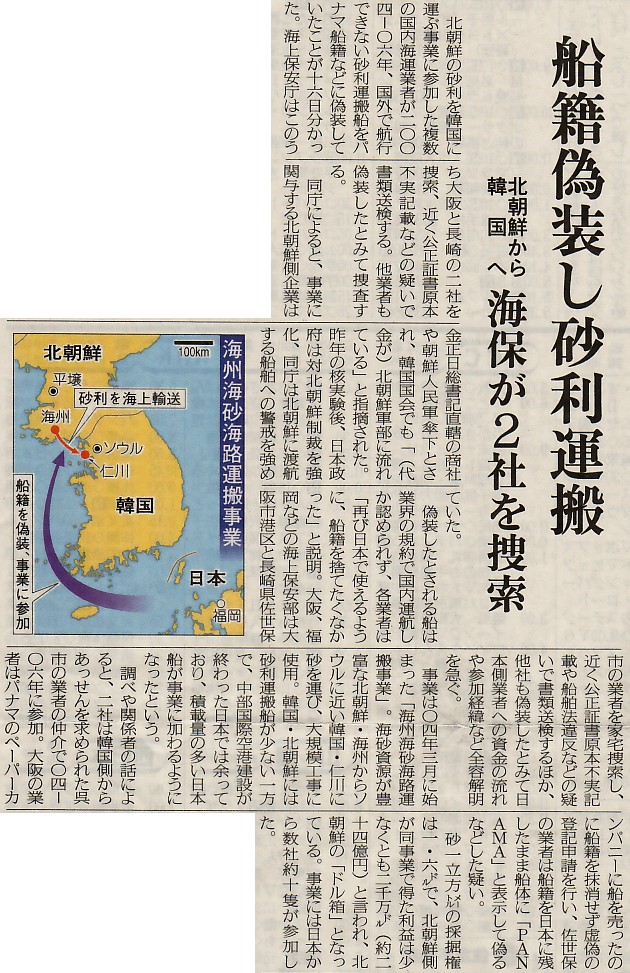
サブ・スタンダード船を利用するもの
が日本側にいなければ、ビジネスは成立しない。つまり、
サブ・スタンダード船
は入港する理由がないのである。
ポートステートコントロール(PSC)
の検査や処分が厳しければ、
サブ・スタンダード船
は利用者から敬遠されるであろう。安いけれど、問題が多いと言うこと
になるからだ。見つからなかったら、安いので
サブ・スタンダード船
を使うと考える利用者が多いと言うことは、ポートステートコントロール(PSC)の検査や処分が甘く、
サブ・スタンダード船
の出港停止命令の頻度が低いことを裏付けることになるだろう。
三菱自動車を見ればわかる。
大手でも結局は、金やコストなのである。虚偽報告でやり過ごせるのである。
誰かが公にするか、誰かが犠牲者になるまで何も変わらない。牛肉偽装も同レベル
である。人が死んでいないだけである。
国際会議だけで、サブ・スタンダード船撲滅を唱えるだけでなく、実際に、日本に
おいても行動するべきであろう。ヨーロッパが活発に活動するから、後に続くのではなく、
日本の問題にも注目すべきであろう。
日本から
サブ・スタンダード船
が輸出されている事実は、
サブ・スタンダード船の出港を許している行政が存在し、
それらに関わっている日本人が存在すること意味しています。
また、
サブ・スタンダード船
に関係している人達のモラルの問題、
それを許している行政の問題の存在
が現在の問題と深い関係があることも理解できると思います。
ポート ステート コントロール(PSC)
の検査も行政問題の一部として改善されることが必要でしょう。まだ、
その他の問題
もあるので本気で問題に取り組まなければ、
サブ・スタンダード船
問題は解決されないでしょう。
下記の記事を参考にしてください。
今まで放置船や座礁船問題が起こっていも
不思議でない状況であったことがわかります。
国土交通省もこれらの解決策を北朝鮮貨物船「チルソン」問題で
注目を受けるまで先延ばしにして来たことがわかります。下記の記事で300トンとか299トン
の数値が使われていますが、日本トン数で300トンと国際トン数で300トンの場合、大きな
違いがあります。国際航海に従事する船は、国際トン数証書を持っているはずです。日本から売却
された時のトン数を使用している場合、認めるのは間違いです。もちろん、国土交通省のポート・
ステート・コントロールは、知っていると思います。漁船の場合、トン数のごまかしが横行していたので、
この事実を含めて国際トン数をチェックすると、上部構造を変更しても299トンにならない
漁船改造貨物船も存在するはずです。
下記の記事で注目するもう1つのポイントは、国土交通省の調査で「経済に悪影響」と答えたのが8割と
なっている点です。繰返すようですが、
これらの日本側の体質がこれまでの放置船や座礁船問題の原因の
ひとつであると言うことだと思います。「大半の管理者は保険義務化に賛成だが、
「規制は千トン以上に」「中小船は除外すべきだ」「放置歴のある国から規制を」-など、
中小船への配慮を求める声が目立った。」の部分に注目していただきたい。
国土交通省海事局総務課
外国船舶監督業務調整官に講演会
によると
多くのサブ・スタンダード船の特徴の1つが総トン数1500トン未満の小型船舶なのです。
他の情報からですが、一般的に、これらの多くの小型船舶は運輸省時代に日本国籍として建造
されたものなのです。皮肉な現状です。
以前は簡単に日本から外国籍に変えるだけで出港できたのでこのような状況に
なったようです。
国土交通省のポート・ステート・コントロールの活動も以前はこれらの問題にはたいした影響を
与えなかったと言うことでしょう。
保険が掛からないような船は問題があると考えても不思議でないでしょう。
そのような船が簡単に
日本を入出港できる。保険に加入できる状態の船しか入港させない条件とすると困る人達がいる事実は、
ポート・ステート・コントロールの検査の未だに効果的でないことを示していると推測できる。
2003年7月1日から適用されるISPSコード
(海上テロ対策法)が国際トンで総トン数500トン未満の船には適用されないとしても、
ポート・ステート・コントロールが船舶の構造や機器の作動テストを厳しく行えば、
問題のある船は簡単に出港できないことになる。全て国土交通省のやる気次第であろう。
皮肉なことに、多くの問題のは元日本国籍の船舶である。これらの船を利用してきた業界とこれらを許してきた
国土交通省の体質を改善し、サブ・スタンダード船問題を解決するべきであろう。
船主の責任
渡井海事のHPより
船主の責任(その3)
投稿者:渡井 [2004/12/25 15:49:23]
前回のコラムでは、改正油濁法の施行により原則として一定の保険に加入していない船舶は、日本国内の港に入港することが出来なくなる、ということをご紹介しました。
2002年に国土交通省は、日本の港に入港する船舶の保険の加入状況を調査しました。その結果延べ73%の船舶は何らかの保険に加入していました。入港する船舶の4隻に1隻は未加入のまま航行しているわけです。
改正油濁法で加入を義務付けている保険の内容は、主に港湾施設や漁具などに生じた損害・油濁に関する損害・座礁の際の船骸撤去費用ですが、この加入73%の中にはこれを包括しきれていないものもあり、改正油濁法が施行される2005年3月までに未加入の船舶の加入も含め、適切な保険の加入率が上がるのかどうかは疑問視されます。
なぜ疑問視されるのか?今世界中の海では保険に加入することの出来ない状態で航行を続ける船舶が横行している実態があります。
一つは便宜置籍船(FOC)の存在です。もちろんFOCすべてがそうだとは限らないのですが、船体・機関・通信・救命などの設備が国際条約で定められた基準以下(サブスタンダード)であるため、航行や人命安全の確保の上で問題のある船舶が多いと指摘されています。このような船舶では到底改正油濁法の見合うような保険の加入は出来ません。
発展途上国のように経済的な事情から保険に加入できない、あるいは改正油濁法にある要件を満たしきれない保険にしか入れないというケースもあります。北朝鮮籍の船舶に至っては、前述の調査での加入率はわずか延べ2.8%でした。
元日本国籍船舶もまたサブスタンダード船となっているケースがあります。日本の領海のみを航行区域とする内航船舶は、国際条約に定める基準を満たさなくとも良い部分があるため、これを海外に売却して買い受けた外国の船主がそのまま国際航海させてしまえば、これがサブスタンダード船になってしまうのです。
なぜこのようなサブスタンダード船が世界中を航行するようになってしまったのでしょうか。国際条約に定める基準を満たすための(保険加入を含めた)コストを削ってまでも経済活動を行なう海運業者、それを取り巻く検査会社や造船所もまたサブスタンダードと知りつつその欠陥船に関わり利益を得ている実態。『船舶がサブスタンダードではなく、船舶所有者やそれを運航する者、その船舶のサービスを(欠陥船と知りつつ)利用する顧客、それら全てがサブスタンダードだ』と評する記事もあります。船舶に関わる者のモラル低下、責任感の欠如がサブスタンダード船を根付かせたといっても過言ではないでしょう。
現在日本沿岸には、10隻からの外国籍の座礁放置船があります。これらは保険未加入のため撤去費用を支払えず放置されたか、あるいはもともと保険に入れないサブスタンダード船であった、というものばかりです。船主の社会的責任のなさが表れた具体例です。
重大事故の責任を取ることの出来ない悪質な船舶に対し、世界各国ではPSC(ポートステートコントロール)を厳しく行なうようになりました。PSCとは、外国船が入港する際その寄港国によって行なう外国船舶の監督です。入港してきた外国船の船体構造や諸設備、船員の資格などを厳密にチェックすることで、航行の安全性や人命の安全確保、環境保全を図ることを目的に行なわれます。日本でも北朝鮮の万景峰号の件で注目されるようなりました。現在各地方運輸局等に外国船舶監督官が配置され、この業務を行なっています。
とはいえ、改正油濁法の施行や日本人拉致問題をはじめとする北朝鮮との諸問題に対する経済制裁の一環として法案化された特定船舶入港禁止措置法案が成立しても、日本の経済にとってプラスになるのかという見方もあります。特に日本沿岸ではこのような船舶の輸送する物資で産業を成り立たせている業界があります。北朝鮮からズワイガニを輸入しこれを加工する日本海沿岸地域、ロシアやカンボジアから原木・石炭を輸入する秋田、廃タイヤを輸出する茨城、中国から鮮魚を輸入する福岡などからはこれらの法施行により経済的に大きな影響を受けてしまうとの声が上がっています。これらの業者に関わる港湾関係者も入港料の減少を危惧しています。法規制やPSCの強化で安全な船舶航行のための世界的な動きがあるその一方で、対象船舶の範囲を総トン数1000トン以上にしてもらいたい、中小船舶(上記の業界の原材料輸入には殆ど中小船舶が利用されています)の規制は緩やかにしてほしい等の関係業界の意見も出ています。杓子定規に法を適用することで、逆に国内からの反発も考えられるのです。
法規制を強めたところで、様々な思惑や利害が取り巻くサブスタンダード船はなかなか根絶できない状況にあるようです。何しろ、サブスタンダード船の殆どはPSC(役所)の動かない週末や夜間を狙って入港するんだそうです。確信犯としか思えない。
ヨーロッパ(Paris MOUエリア)では、今後、船舶の状態に対して融資する銀行、
保険会社、及び荷主が情報提供に協力するようになるだろうと「Fairplay」
に書かれている。現在は、ISMコードで定義されているDOCと呼ばれる
管理会社が船舶の責任を負うことになっている。将来、融資する銀行、保険会社、
及び荷主にも責任を負わすことも出来ると提案している。日本はこのような
発想がないのが残念である。国土交通省は、船主責任保険(P&I)の義務化に
ついてアンケートを取った。かなりの温度差である。日本は海運国であるの
思うのであれば、不良船を利用する業者に対して毅然とした対応をしなければ
ならない。また、不良船(サブスタンダード船)の出港(輸出)に対しても
厳しい対応をするべきであろう。下記は「Fairplay」からの記事である。
Banks, insurers have responsibility
BANKS, insurance companies and cargo owners will have a greater role to play in providing information on ships’ physical condition in future, according to Carien Droppers, assistant secretary of the Paris MoU on Port State Control. “The company nominated on the Document of Compliance is the company responsible for the ship,” she told delegates today at the Tanker Operator conference in London. “Then come flag and class, with Port State Control fourth on the list. But cargo owners, insurance companies and bankers could move up the order of responsibility in future,” said Ms Droppers, herself as master mariner. The Paris MoU, which has 20 member states and a further five waiting to join, is the oldest PSC MoU region, set up in 1982. A new MoU region, covering the Arabian Gulf waters, is expected to enter force in the middle of this year, at which stage almost all of the world’s coastlines will be covered by MoU regulations. Paris MoU states have clear guidelines on inspection procedures. Tankers and gas carriers of more than 3,000gt and over 15 years of age are most likely to be inspected, as are ships on the Paris MoU flag state blacklist.
15:51 3 Feb
Fairplay International Shipping Weeklyより
日本の内航船は外売された時点でサブスタンダード船。
一般に
日本籍内航船
は国際条約を満足しない規則で建造されており、日本領海内(平水、沿海、非国際近海)
でしか運航できない。国際近海(外国港への入港が可能)は国際条約を満たすように
建造されている。このため、日本籍内航船(国際近海として建造された船舶は除く)が外国籍になった時点で
サブスタンダード船となる。
PSC(外国船舶監督官)
がこの事実を理解し、予習をして元
日本籍内航船
の外国船を検査すれば、出港停止に値する不備を簡単に見つけることが出来る。
しかし、現実は一部の
PSC(外国船舶監督官)
以外は見つけていない。
これは
日本のPSC(外国船舶監督官)
を含むアジアのPSCが問題点を指摘していない(出来るだけの知識と能力がない)現状が存在するから成り立つ。
国際船級協会連合(IACS)の
船級規則で遠洋区域(Ocean Going)の要求を満足する内航船などほとんどありません。
内航船として使われている「フェリーよなくに」に関して国境の離島における短国際航海(与那国−花蓮間60 海里)の貨客船あるいは貨物船の航行許可に関する要件緩和もしくは地域の実情をふまえた規制適用等
(財団法人都市経済研究所より)
からも推測できるが、内航船を改造することなしに国際航海に従事することは不可能だ。
しかし、船の国籍を選べば、
PSC(外国船舶監督官)
が問題を指摘しない現状では逃げ道があるのです。
検査会社が検査を見逃してやり、お金と引き換えに証書を発給するから多くの船が日本に入港出来るのです。
事実を知らないから、上記のような発想が出来るのでしょうね。
産地偽装問題
も同じですが、正直者がばかを見るのが現在の日本です。
外国人に対して強い対応が出来ない日本の公務員が生み出した矛盾です。
これを読んだ人達の中には割り切れない矛盾を感じる人がいるかもしれません。しかし、これが現実です。
「わが国はIMOとともにASEAN諸国の国内フェリー復原性ガイドラインを策定する等の協力を進めており、本年4月にもマニラで開催されたIMO内航フェリー安全セミナーに参加している。フェリー全体の安全性向上には、アジアという視点が必須である。」
コスト優先の意識や公務員の腐敗や賄賂問題が存在する限り、問題の解決は難しいであろう。コストを優先するからこそ、沿岸エリアを考慮してIMOの規則が
日本の内航フェリーに適用されないのである。安全を考えればIMOを適用しても問題ないが、コストや採算の問題がある。日本でもコストや採算を無視できないのだから、
発展途上国や国民の所得が低いアジアの国々では無理と思える。
セウォル号事故は韓国で起こった。韓国はアジアの中では経済的に上位の国である。海運会社の姿勢、行政との癒着、癒着によるチェック体制の機能不全など
信じれない事が公になった。実際の問題を理解しなければ、「安全基準や検査制度自体」の整備と言っても絵に描いたもちになる可能性が高い。
フェリーの安全性を高めるには~セウォル号事故を契機に考える~ (笹川平和財団海洋政策研究所)
[KEYWORDS] フェリー事故/SOLAS条約/水密扉
国立研究開発法人海上技術安全研究所海難事故解析センター長◆田村兼吉
フェリーでは、車輌デッキの存在から、一旦事故が起きると大事故に繋がることが多い。
IMOはフェリーに関するSOLAS条約の改正を行ってきたが、各船の運航状況により水密扉の開放による復原性の問題が残る等、まだ課題は多い。日本はIMO等での安全性向上の先進的議論に参加しながら、その成果を積極的にアジアに還元していく取り組みを継続していくべきであろう。
フェリーの安全性
韓国の大型旅客船セウォル号が転覆・沈没した事故から一年以上が経過した。事故原因については韓国政府の正式な発表を待たねばならないが、過積載とバラスト水の意図的な操作、運航会社と船員の安全管理体制、不適切な船体改造と船体検査制度の不備、といった複数の要因が指摘されている。
セウォル号は日本国内では旅客船兼自動車渡船、いわゆるフェリーに分類される船舶であり、英語圏では、自走で乗用車やトラック・貨物が乗り降りするという意味のRoll on/Roll offからROPAX VesselやRo-Pax Ferryと呼ばれている。こうした「RoRo貨物スペースを持つ客船」と定義されるRoRoフェリー(以下フェリー)は、比較的短い航路で利用され、戦後、自動車交通の発達と共に大成功を収めてきた船種である。しかし、表に示すようにその過程で海外では大事故も起きている。
フェリーの事故率は特に大きい訳ではないが、事故の重要度に着目すると様相は変わってくる。図は1995年から2011年の17年間の海難事故データを分析し、F-N線図にしたもので※1、横軸に死者数、縦軸に超過頻度(1隻の船舶が1年間にそれ以上の規模の事故を起こす確率)をとっている。一般客船に比べてフェリーの超過頻度は高い。死者数の大きな事故ほど両者の差が開き、百名規模の事故では一桁近く高くなっている。つまり、フェリーでは一旦事故が起きると、多くの死者を出す大事故に繋がってしまうことを示している。
この最大の要因は、フェリーの特徴である複数層の巨大な車輌デッキの存在にある。デッキ内部は車輌の走行の利便性から、横隔壁が極端に少ない大空間となっている。そのため、一旦デッキ内に浸水すると、自由水は大きく動いて復原力を低下させるし、浸水の広がりも速いので、短時間で浮力を失う危険性も高い。内部の車輌や重い貨物は、大傾斜時に片舷に移動して傾斜を助長させる。火災も広がり易い。大きな外扉は、波にたたかれると損傷し易い。
水密扉の問題
問題点の一つは、損傷時復原性に関係する水密扉にある。車輌デッキの下層部は、水密隔壁で細かく仕切られている。隔壁には水密性を低下させる水密扉は設置しない方が理想的だが、乗組員の往来や非常時の避難経路確保を目的として、船主側はその設置を求めることになる。しかし、European Gateway号、Estonia号、Express Samina号の事故では、事故時に水密扉が閉まらなかったことから車輌デッキに浸水、船の転覆や沈没を招いたものと指摘されている。また、海外の調査では、航行中、日常的に水密扉が開放されたままだったり、整備不良だったりする違反は数多く報告されている。
国内でも同様の事故例もある。セウォル号事故の直後に徳島でおきたフェリー座礁事故では、岩礁との接触により右舷船底部にできた亀裂とフィン・スタビライザーの根元に開いた穴から浸水し、車輌デッキに通じる水密扉が開放されていたため、吹き上げてきた海水が最下層車輌デッキの腰の高さまで流れ込んだ。幸い、乗員乗客は無事で、船は自力航行により港まで戻ったが、車輌デッキへの浸水は重大な結果につながりかねなかった。
フェリーの安全性向上に、IMO(国際海事機関)が手をこまねいていたわけではない。水密扉や外扉が開放されたままでの上記の事故を受けて、1988年のSOLAS条約改正では、ブリッジに扉の開閉表示装置や漏水感知装置の設置を義務付けた。その後も、1992年に現存フェリーの損傷時復原性要件の導入、防火措置の改善・強化、1995年に損傷時復原性の水密性要件の強化、脱出経路要件の追加、1996年に貨物区域の防火措置、と矢継ぎ早に改正を行ってきた。
SOLAS条約には航行中にすべての水密扉を常時閉めておくことが規定されているが、多数の例外規定がある。2010年12月に導入された「航行中の船の扉の開放を許可する場合のガイダンス」でも、常に水密扉が開放された状況が各船の運航状況により生じるため、安全性向上が疑問視されている。こうした曖昧さを排除するために、2013年にIMOではSOLAS条約とガイダンスの全面的見直しが提案されており、日本としても、フェリーの安全性向上のための重要な取り組みとして注目している。
アジア視点の安全対策と日本の役割
セウォル号の事故時に「日本の内航フェリーではこのような事故は起きない」という声をよく聞いた。SOLAS条約の改正は直接適用されるものではなく、各国の国内法に反映された後に適用されるものである。国土交通省は、2009年のフェリー「ありあけ」の大傾斜事故時に、操船による大傾斜回避や貨物の固縛方法の改善等、いち早く再発防止策を講じるなど対応してきた。事業者側も、任意ISM※2コードの導入など、安全管理体制の充実を図っている。こうした日本独自のきめ細やかなソフト面での対策に加え、SOLAS条約の国内船適用や一般旅客船に比べ復原性要件を強化する等のハード面の対策も積極的に実施しており、こうした対応が自信の声につながっているのだろう。
一方、ASEAN諸国に目を向けると、経済発展とともにフェリーによる輸送需要が急速に高まっているが、安全基準や検査制度自体が整備されていないため、船舶事故が多発している国も多い。こうした国々では、日本から売却された中古フェリーも多数航行している。そのため、わが国はIMOとともにASEAN諸国の国内フェリー復原性ガイドラインを策定する等の協力を進めており、本年4月にもマニラで開催されたIMO内航フェリー安全セミナーに参加している。フェリー全体の安全性向上には、アジアという視点が必須である。IMO等での安全性向上の先進的議論に参加しながら、その成果を積極的にアジアに還元していく取り組みを、わが国は継続していくべきであろう。(了)
Report links Panama flag with illegal North Korean shipments 05/24/19 (Splash247)
by The Editorial Team
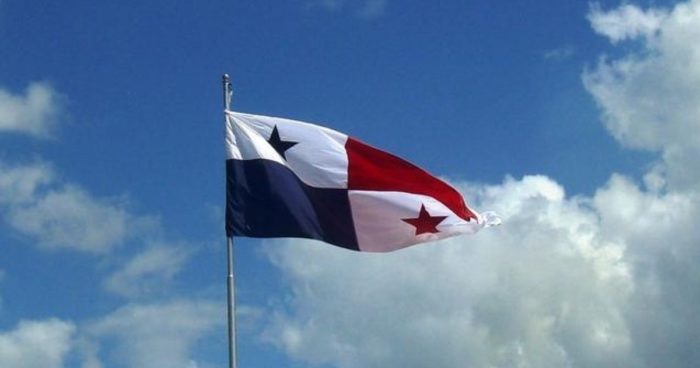
The Royal United Services Institute (RUSI), a UK security think tank, published a report according to which the Panama flag is involved in illegal sanctions-busting in North Korea. This investigation focuses on Fan Mintian, Dong Changqing and Zhanq Qiao – three Chinese nationals who have appeared in the UN Panel of Experts investigations into North Korea’s sanctions evasion activities and several other reports linking them to flag registries, and oil, coal and iron ore smuggling networks.
Specifically, the report found that Fan and Dong worked as surveyors for the ‘Panama Maritime Documentation Services’ (PMDS) organisation, authorised by Panama, and provided various certificates t North Korean-linked vessels.
In addition, the report resulted to the fact that Chinese nationals with close links to North Korea’s illicit shipping networks have acted as surveyors for vessels registered under the Panamanian flag, and possibly the Mongolian flag, thereby potentially providing an avenue for North Korean-linked vessels to obtain flags of convenience and other maritime services prohibited under UN Security Council resolutions.

Also, PMDS was found to share an address and other contact details in Dalian, a city located near the North Korean border, with Fan and Dong’s companies, as well as another surveyor authorised by Mongolia called International Maritime Survey Association (IMSA), established by Zhang Qiao.
Moreover, a number of Chinese nationals with extensive links to North Korea’s illicit shipping fleet have acted as vessel surveyors for Recognized Organizations such as Panama Maritime Documentation Services and even operated their own classification agency named the International Marine Survey Association.
The report highlights that
Several links between these entities and individuals such as shared emails, phone numbers and addresses also suggest that Fan, Dong, Zhang and the companies and organisations they operate are much more closely connected than may at first appear on the surface.
In conclusion, James Byrne, the report’s researcher, resulted to the fact that Fan’s, Dong’s and Zhang’s employment with, and operation of, Recognized Organizations and Classification Societies may therefore help explain how some North Korean-linked vessels have been able to avoid scrutiny and continue operation as foreign-flagged vessels.
UK report links Panama flag with illicit North Korean shipments 05/12/19 (Splash247)
Sam Chambers
The world’s largest shipping registry has been embroiled in a scandal involving sanctions-busting North Korea.
A 27-page report from the Royal United Services Institute (RUSI), a UK security think tank, highlights how three individuals from the Chinese port city of Dalian have been working for entities entrusted by both the Panamanian and Mongolian flags to survey ships and authorise certificates, including for a number of North Korean-linked vessels.
The three men – Fan Mintian, Dong Changqing, and Zhang Qiao – stand accused of helping the Kim Jong Un regime flout sanctions.
RUSI found that Fan and Dong have worked as surveyors for an organisation authorised by Panama called Panama Maritime Documentation Services (PMDS), and have provided various certificates to North Korean-linked ships.
Fan and Dong were embroiled in an earlier North Korean illegal shipping incident when the vessel Light, managed by their company Dalian Sea Star Ship Technology, was “suspected of transporting North Korean missile technology to Myanmar”.
PMDS was also found to share an address and other contact details in Dalian, a city located near the North Korean border, with Fan and Dong’s companies, as well as another surveyor authorised by Mongolia called International Maritime Survey Association (IMSA), established by Zhang Qiao.
The report concluded that the business connections provided by the three men from Dalian could provide “an avenue for North Korean-linked vessels to obtain flags of convenience and other maritime services prohibited under UN Security Council resolutions.”
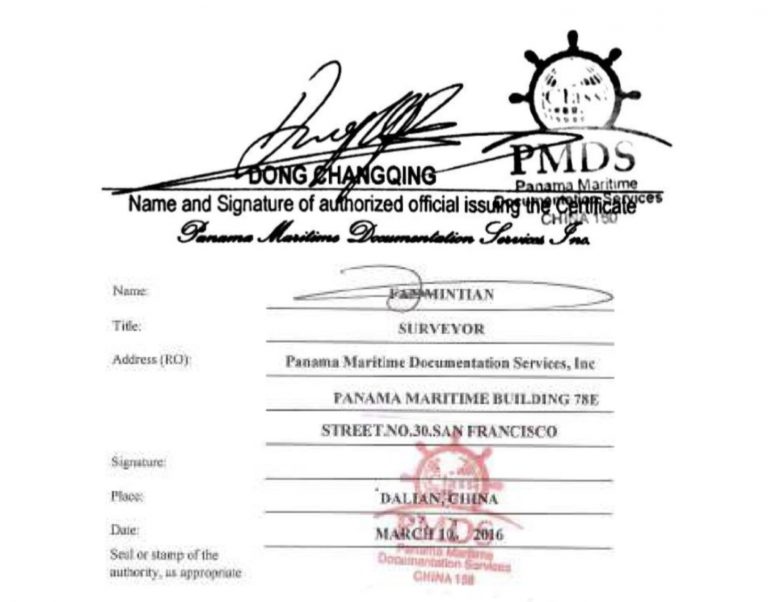
PROJECT SANDSTONE The Sailors of Panama James Byrne (safety4sea)
★開けない人はここをクリック
The Volgo-Balt 199 disaster and the safety of coastal shipping in Black sea region 02/24/13(Maritime Bulletin)
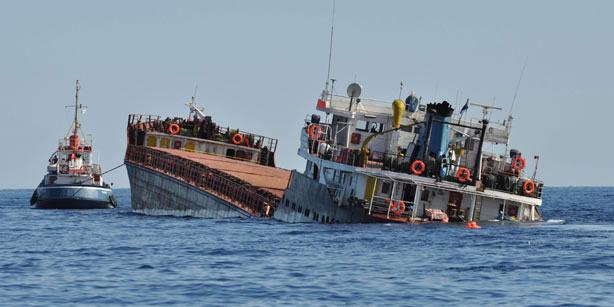
The Volgo-Balt 199 disaster once again focused industry’s attention on a problem of substandard shipping safety in general, and in Black sea in particular. River-sea type, general cargo vessel Volgo-Balt 199 sank in Black sea on Dec 4 last year, 9 crew died, and 4 survived the disaster. Vessel loaded with 3,300 tons of coal was en route from Mairupol, Ukraine, to Turkey, got caught in storm and broke in two, sinking in just minutes, some 20 miles off Turkish coast. On Jan 31 of the same year, another river-sea type vessel Vera sank during the storm on Eregli road, roughly in the same area where Volgo-Balt 199 sank. Vessel was en route from Rostov-on-Don to Izmir, Turkey, loaded with scrap, and anchored on Eregli road to outwait the storm. 4 crew were rescued, 7 died.
In June last year, ITF and affiliated unions published a brochure “Black sea of shame”, slating regional ship owners as irresponsible greedy flock, and the whole coastal shipping in Azov-Black sea area as extremely dangerous for the seafarers working on board of regional coasters.
On the wake of Volgo-Balt 199 disaster, ITF and affiliated unions, mainly SUR (Seafarer’s Union of Russia), are launching a news campaign aimed at what they call, “substandard shipping” in Azov-Black sea region. To comprehend the problem and the safety risks, one must scrupulously consider all known facts and statistics, avoiding emotions which prevail in media coverage of the Black sea disasters, and in Trade Union’s proclamations and allegations.
m/t Volgo-Balt 199 was vessel of river-sea type, widely spread in European waters. The owner of the vessel operates 5 other vessels, also coasters. The only criteria available for the assessment of the safety of those vessels, is the detention history. All 6 vessels, including the ill-fated Volgo-Balt 199, have a good history in this regard, after they were obtained by the owner in question. Before the present owner, their history wasn’t so good. Together with other information gathered after the disaster, including the Ukrainian Shipping Inspection statements, it may be presumed, that Volgo-Balt 199 was up to the required standards, or to put it short, as seaworthy, as the river-sea type vessel may be. The question is, what is seaworthiness of the river-sea type vessel, and why technically nonfaulty vessel sank in though strong, but still, regular for this region and this time of year storm?
The river-sea type was developed in former Soviet Union sometime back in the late 50-th, with the main idea of creating a vessel capable of navigating both inner waterways and the coastal seas. There are many projects of those vessels, they are widely built since the 60-th up to the present days, but whatever is project or year of built, the vessels still, are not seaworthy in a generally accepted meaning of seaworthiness. By Class requirements they’re restricted in navigation and can’t sail further than 50 nautical miles from a refuge, but in fact, such a restriction is a dissimulation. The vessels are too long, flat-bottomed and not strong enough in terms of structural strength.
The meaning of it is very simple – vessels are prone to capsizing even in fresh weather, if they become disabled and open the side to the waves, and prone to hull breaking in more or less strong storm, even if they’re under power and can keep against wind and sea. Vessel may be more than 50 miles off the coast, or less than 5 miles, it doesn’t actually matter. What matters is the sailing itself – river-sea type can’t sail into any storm, it’s mortally dangerous.
River-sea type in this respect, is similar to a soldier in battlefield, who’s moving around by short spurts from one shelter to another, during the short periods of fire cease. River-sea type has to sail from one port to another, from one area to another with enough places of refuge, during the periods of safe weather conditions, depending on favourable weather forecasts and captain’s knowledge and feeling of local weather. To be caught in storm is, if applied to river-sea type, an accident in itself, requiring an investigation, even if the vessel managed to survive. The long-term statistics show, that 2 out of each 100 river-sea type vessels sink due to unfavourable weather conditions.
“Substandard ship” term is widely spread and believed to be understandable without need for any further clarifications, but is it so? Some define substandard ships as “seaworthy but with conditions on board the ship which are clearly hazardous to safety or health”. Some define substandard ships in quite a different way:
“A substandard ship under our standing point is the one that falls under at least one of these criteria:
a. Poor Shipbuilding Quality
b. Poor Maintenance
c. Under qualified crew”
Generally, it is understood or accepted, that substandard vessels are the vessels mainly of coastal trade, aged and registered under FOC. As such, they’re believed to be risky for crews, cargoes and environment. Let’s look into the ITF brochure “Black sea of shame”. ITF and affiliated unions describe the Black sea coastal shipping as mainly substandard one, trying to prove their allegation by the following statistics:
“There are some 2,400 dry cargo vessels trading in the area, of between 2,000 – 12,000 dwt. Close to 1,000 vessels are of 2,000 – 4,000 dwt. Trade is dominated by the vessels over 20 years old, with some 800 vessels being over 30 years old, and only some 500 vessels are of 10 years old, or newer”.
ITF obviously considers the above figures to be so frightening, that there is no need for any other argumentation. For a superficial reader, for general public, yes, there is no need for anything else, such ages seem to be very frightening indeed. For an industry insider, the figures ITF is operating are hardly frightening or alarming. Just for one reason – if we check the world merchant fleet statistics, we’ll easily figure out, that some 62% of global fleet of dry cargo vessels of 2,000 – 12,000 dwt are 20 years old or older, the remaining 38% being 0-20 years old, and this proportion exactly correlates with Black sea figures. But there is another reason, too. There is no need in scrapping general cargo vessels of 2,000 – 12,000 dwt achieving10-15, or even 20 years, ages. They’re not state-of-the-art floating wonders of high-tech, and they don’t have to be such. They’re basically rather simple devices, which may be safely exploited for 20-30 years period, providing they’re properly maintained and operated. Coastal shipping doesn’t need modern vessels, it needs safe, sound and reasonably cheap vessels, easy to operate and maintain. In this respect, river-sea type has an advantage of sailing at least one third time of their lives in fresh water, which is much more merciful to the hull than sea water.
Most owners of the river-sea type vessels are small and middle-sized companies, struggling for survival in hostile business environment of Russia and Ukraine. They have to fight for the survival on the market outside their countries, and simultaneously, they have to fight the almighty bureaucracy and all-embracing corruption inside their countries. What’s worse, they are not sure of the future, especially middle and long termed. The rules of the game which is called “private business”, both in Russia and Ukraine, may change overnight, leaving the ship owners with little choice except either fleeting the country, or selling out everything and leaving shipping for good. One can hardly expect them to invest all capitals they have into modern vessels, let alone ordering newbuilds. Still, many of them manage to modernize their fleets, like for example, the company which owned ill-fated Volgo-Balt 199. Of course the pace of modernization is very low, but keeping in mind, that the States in question do everything they can to make the owners life short of unbearable, it’s a wonder how the owners manage to do what they do.
The river-sea type is risky in comparison with any other type of purely sea-going vessels. They are risky not because of age, but because of their basic conception. The vessels are a compromise between seaworthiness and an ability to navigate inner waterways, and technically speaking, the vessels are not satisfactory both to river and sea standards. But there is one advantage, which makes up for all other lacks and flaws. Economically the vessels are very effective, bringing profits to the whole number of other industries except shipping. A river-sea type vessel may reach towns which lay far inland, and carry goods at unrivalled cost and time. Volgo-Balt may sail to Ural, load cargo of steel from Perm steel mills, and deliver it directly to Italy or Algeria, to Rostock or to Birmingham, saving fortunes on transportation costs. On a return voyage vessel may deliver goods to Kazakhstan or Iran, again with great savings for shippers.
There is only one guaranteed way to make river-sea vessels as safe as any other sea-going vessels, it is banning them from sailing in high seas. But such a ban will have negative effect for many industries and economy in general, which will bear the burden of raised transportation costs. There is another, social aspect, too. Nearly all the companies which own and operate river-sea type vessels are considered by seamen community as “start-up” or “final stop” grounds. Young and ambitious start their ocean-going careers, turning from green rookies into professionals on board of coasters, which is especially true for the Ukrainian and Russian ratings. Aged ones find their final employment with not too educationally demanding coaster positions, which is especially true for officers, as the officers of river-sea type vessels, mostly, don’t have such profound education and knowledge of English, as officers of ocean-going vessels.
Statistically, river-sea type is barely more risky than any other type of the cargo vessels. Technically, it’s much more risky. The river-sea type risk is derivative of seamanship of the captain and the responsibility of the operator. In other words, ocean-going vessel may survive the mistakes made by operator or captain by sailing through storm, while river-sea vessel may not. There are ways of course, to make river-sea type vessels safer than they are now, by applying mostly, more strict regulations. For example, to prohibit the vessels to leave the port in bad weather or if forecast is promising storm, making it the responsibility of port administration, or PSC, and making the new regulation compulsory throughout all Europe. That alone will make river-sea type about as safe as any next type in coastal waters.
What is definitely not bound to make the river-sea type safer, is the new campaign the ITF and affiliated unions are trying to launch, using the Volgo-Balt 199 tragedy as a pretext. Their true concerns lay elsewhere, but not in the spheres of safe and socially responsible shipping. The SUR for example, bluntly declared, that the only way to make Black sea shipping safe, is to force the ship owners operating in the region to sign the ITF collective agreement with those trade unions in their States, which are affiliated with the ITF. The SUR as bluntly said, that there are no parties around capable of making Black sea shipping safer, except seamen and dock workers unions. It’s an alarming, worrisome claim, because the safety of the shipping is strictly professional matter to be attended to exclusively by authorized organizations, not by any self-proclaimed well-doers. And because, alas, the trade unions enjoy too much power nowadays.
Voytenko Mikhail
フィリピン編
セブで起きた大型フェリー沈没事故について (フィリピンニュース Philippines Inside News)
8月16日、セブ港近くで1万1千トン余の大型フェリーと1万トン弱の貨物船が衝突し、フェリーは40m下の海底に沈没(貨物船は前部大破のみ)。既に一か月経過したが、今日現在で死者116名、行方不明21人となった。
フィリピンは7000余の島で構成される国で、その内、4000島に人間が居住しているというから、船は重要な交通、移動手段になっている中の大惨事である。
フェリーには800人以上の乗客が乗っていて、金曜日の夜にしてはずいぶん多いと思って聞いたら、フェリーはマニラ行で、ミンダナオ島北部のブトゥアン市から出港、途中セブに寄港するスケジュールで、セブで週末に買い物などをして遊んで過ごし、また夜行便で帰る乗客が結構多かったらしい。
写真はセブ市の反対、西海岸にあるトレドという町から出ているフェリーでネグロス島行東海岸行き。写真には遠くの雲の下にネグロス島の島影が薄黒く写っている。
このフェリーには車ごと乗船したことがあり、2時間弱で対岸に着く。使っている船は日本の瀬戸内海で運航していた中古船で、船内に掲示してある日本語のプレートなどそのまま残っていた。
船齢はどのくらいか分からないが、恐らく40年以上にはなるのではないか。日本でスクラップにされるような船でもフィリピンでは商品価値があって、日本の中古船が相当数運航されている。
そういえば以前、青函連絡船がセブ・マクタン島に回航されて『浮かぶホテル』として営業していたが、いつの間にか居なくなった。この船は北海道の人には思い出深いらしく、セブに遊びに来た北海道出身の人が見たいといってわざわざ連れて行ったこともあった。
今回の沈没したフェリーは1973年、尾道で建造、日本国内で運航後1992年にフィリピンへ転売、既に船齢40年である。船の場合は手入れ次第で寿命は結構延びるが、それもよりけりで、人命を大量に運ぶ船には老朽船は相応しくない。
今回の事故を起こした船会社は、5年前の2008年に2万4000トン弱の国内最大級のフェリーを沈没させる事故を起こし、800人以上の死者・行方不明者を出している。この時のフェリーは日本のテレビCMで有名になった『サンフラワー』だったが、あんな巨船がいとも簡単にひっくり返るとは信じられない事故で、今もって原因は藪の中。
ただ、今回の事故のフェリーと前回のフェリー事故の共通点は、日本で走っていた頃と船の外観がかなり変わっていて、これはフィリピンに来てから乗船人員と積載量を増やすために上部、船内を改造したためで、これがどうも当初の設計安全係数を駄目にしてしまい、簡単に横転、沈没する船となったのではないかと推察する。
セブのフェリーの場合、いくらなんでもあれだけの巨船が魚雷攻撃を受けたならともかく、単なる衝突によって20分程度で水没してしまったというのはどう見てもおかしい。相次ぐフィリピンの事故は、運航会社の利益追求による安全性無視の改造によると、多少船のことを知る者としては指摘したいが、フィリピンの船会社の改められない利益優先態度からは、何度でもこういった事故は繰り返されるのではないか。
事故調査の審問が始まって、衝突の原因を巡って双方の船長は、『船を認めて無線で連絡を取ったが応答がなかった』と互いに主張、『相手が悪い』と責任を擦り合っているらしいが、無線に頼る海域でもないし、双方が視認しているなら早めに互いに回避措置を取れば良いだけの話で、荒天でもない夜の9時台、あれだけの巨船同士、『双方の見張りの怠慢』と断定しても良いだろう。
フェリー沈没余波として、フェリーには燃料など油を10数万リットル積載していて、これがタンクから漏れて海面に広がり漂着し、沿岸ではこの油除去で大騒ぎ。セブ州当局は『被災地宣言』を出す始末で、沈没海域はマクタン島のリゾート地域にも近く、潮の流れによってはビーチの汚染も考えられ、リゾートは戦々恐々。
また、この海域で獲れる魚にも影響が出ていて、そういえば我が家でも家人が事故以来魚を買っていないが、これも油汚染を避けているためと思うが、いつもの市場で買っている魚はセブ島北部の、今回事故が起きた海域とは全く影響のない海域で獲っているから大丈夫な魚だが、それでも魚を食べないセブ人が多く、これはいわゆる『風評被害』の典型になる。
それでも福島原発の放射能汚染水を海に垂れ流している日本と比べれば、どこか余裕がある。
汚れたイメージをふり払おうとしているパナマ (日本船主責任相互保険組合)
− O号のISM証書問題に関する論争を経てパナマ政府は
検査代行機関をどのように監督するかという難しい問題に直面している −
(2001年7月31日付ロイズリストより)
< O号事件の概要 >
O号という老齢パナマ籍クルーザーが、Panama海事局が認可した会社の発行するISM証書をもっていたにもかかわらず、35個所の欠陥リストをかかえて、運航していたことが判明した。2001年7月2日、O号は、イギリスの港湾局により、出港停止処分を受け、突然、司法当局により検挙されたという事件。
--------------------------------------------------------------------------------
パナマ海事局は、O号事件の再発を防ごうと、世界各地の公認検査代行機関を監査しようとしている。
英国のドーバー港でクルーズ船O号が拘束検挙されたことにより、パナマの検査代行機関が野放しでろくに監督されていないという事実を白日の下にさらす結果となった。
O号はパナマ海事局が公認したPanama Register Corporationという会社が発行したISM証書を所持していた。ISM証書を発行する権限を有する公認代行機関として、ウェブサイトに掲載されているにもかかわらず、パナマ海事局は去年の4月にその権限を剥奪したと主張している。
ISM証書の発行権限があろうがなかろうが、証書は発行されるべきではなかった。品質管理プログラムでそのような過ちは防止すべきであった。
「ほとんどの船籍国は世界中に展開する全船舶を検査する能力を有してはいない。」「それゆえに、それらの船籍国は検査権限を民間会社に委託するのである。」「これらの会社が実行する検査、監督の密度は委託元の船籍国によって異なるのである。しかし、ひとつ確かなことがある。検査代行機関に対する監督は品質管理保証の一環なのである」と元パナマ海事局の職員で今は競合する船籍国の職員として働いている人が証言している。
現行の手続き体系の下では、海事局は船級協会や検査代行機関が発行した証書についての報告書及びサーベイヤーの検査報告を受け取ることとなる。その手続きはIMOの書類の中で定められている。しかし、それは常にガイドラインであって強制力のあるものではない。
今年始め、数海運国の認証印のある大量の偽造船員免状が発見されたが、これによって検査代行機関は十分な監視を受けていないのではないかとの非難がますます 高まることとなった。
フィリピンからの新聞報道によれば、マニラの2つの非公認会社が1日に200件ないし300件免状申請を処理していたという。その一つ、Maritime Services Inc.は、10%の市場シェアを持っていたといわれている。パナマ海事局長、Jerry Salazar氏は、調査団をマニラに派遣したが、既に、会社のオフィスは蛻の殻であった。
評判の良い法律事務所では、公然たる汚職というのは決して一般的なものではない。「この種の報告書は誇張されている。」とパナマのDe Castro & Robles法律事務所の海上弁護士、Cesar Escobar氏は言っている。「もし、誰かが賄賂を持って役所にやってきたら、はたして法に反する不正を犯す誘惑にかられる役人が一人もいない国があろうか?」
Escobar氏の主張によると、検査規準もまた問題である。「監督を強化すべきだ。」とEscobar氏は言った。「私たちはその圧力を強化しなければならない。パナマは海運産業にサービスを供給する立場にある。パナマは、海運業サービスが国家財政に貢献しているので、検査規準を維持することに大きな関心を持っている。」
スキャンダルがあらわになったとき、海上弁護士は依頼人に諸説明をする責任があるとEscobar氏は指摘している。
便宜置籍船の評判が落ちた場合、それは置籍船の減少という商売上の損失になって しまうのだ。このスキャンダルがパナマ海事局のイメージを著しく傷つけて以来、パナマ置籍申請の照会が50%も減少したと一人で法律事務所を経営しているRuben J. Levy弁護士は報告している。
「私は、言うべき前向きなことがないときには、船主には話しかけるのをなるべく避けることにしている。」とEscobar氏は言った。
「パナマ政府は本当に海事行政のことがわかっていないし、担当官吏は公衆がこの問題にどのくらい敏感であるかを理解していないように感じられる。海事局は混乱の極に達している。担当官吏達は、自分達がどのように大きな損害を引き起こしているかを知らない;彼等はパナマの収益源をめちゃめちゃにしているのだ。」
Escobar氏はまた、スキャンダルが白日の下にさらされたことによって、便宜置籍引受商売が顕著に減少している事実を報告している。「現在の顧客よりも将来パナマ置籍を利用している潜在的顧客に対する影響の方が大きいと考えている」と同氏は述べている。
海事法律協会の会長である、Juan Felipe Pittyは、海事局が決然とした行動をとるよう促した。
「私たちは、30日以内に徹底的な調査が行われることを期待している。」「たとえ、結果としてパナマの船舶検査行政を代行する会社やサーベイヤーの認可を取り消すということになろうとも、違反を犯した個人と法人の全員に見せしめとしての処分を期待する。」とPitty会長は言明した。
「海事当局はこれら一連のスキャンダルを便宜置籍制度を攻撃する機会を待っていた反政府勢力にそのチャンスを与える絶好の機会としてはならない。反政府勢力が舌なめずりしている様子が手にとるようにわかる。」と。
「パナマ当局とパナマ当局が監督している便宜置籍制度は多数の船籍登録を誘致するのに大成功を収めてきた。昨年この世界最大の便宜置籍制度は、実際に第二の便宜置籍国リベリアに大きく水をあけた。
「過去5年間に亘って、パナマ海事当局は繰り返しもはや便宜置籍国の悪い評判は過去のものとなった。」と強調していたが、一部の代行業者にはこのメッセージは届いていなかったようだ。
以上
<日本船主責任相互保険組合>
韓国が欧州委員会(E.C.)から違法操業国に指定される理由や背景
ロシア沖のベーリング海で操業していた韓国の遠洋トロール漁船「第501オリョン号」(501オリョン号 IMO: 7388504)の沈没事故に関してインターネットで検索しているうちに、韓国が欧州委員会(E.C.)から違法操業国に指定される理由や背景に辿り着いた。とても興味深く思えたので調べてみた。
EU warns four more states in fight to end illegal fishing 12/12/14 (WWF)
Brussels, Belgium: Illegally caught fish comprise a significant portion of both the global catch and of seafood imports, including to the world’s leading fish-consuming markets. To counter this, the EU enacted strong fisheries laws and in 2012 began issuing warnings to – and imposing sanctions on – states which are accused of failing to comply with those regulations. The European Commission issued warnings to four states – St. Kitts and Nevis, St. Vincent and Grenadines, Solomon Islands and Tuvalu – for alleged shortcomings in fighting illegal, unreported and unregulated (IUU) fishing.
The warnings, or yellow cards, give the states six months to address EU criticisms of governance of their fishing fleets and their waters. Failure to do so could result in sanctions, including a full ban on importing seafood to the EU.
“We applaud the Commissioner’s commitment to preventing illegally caught fish from entering the EU,” said Tony Long, director of Pew’s ending illegal fishing project. “However, small island developing states often have limited resources and so expertise and capacity-building is vital to ensuring their full compliance with the law.” He added.
IUU fishing depletes fish stocks, damages marine ecosystems, puts legitimate fishers at an unfair disadvantage and jeopardises the livelihoods of some of the world’s most vulnerable communities. IUU fishing is estimated to cost between €8 and €19 billion annually, representing 11 to 26 million tonnes of catch.[1]
The EU’s IUU regulation, which came into force in 2010[2], aims to keep illegally caught fish out of the EU market by requiring “catch certificates” for seafood imports and exports. The law also bars the import of fish from states and vessels known to be involved in IUU fishing. The regulation and the EU’s enforcement of it are unique among market-leading states.
“Ending illegal fishing is about safeguarding fishermen who play by the rules in both the EU and internationally,” said Andreas Baumüller, Head of the Natural Resources Unit at WWF’s European Policy Office. ““The Commission must continue to make public the context and reasons for issuing yellow-cards and the remedial action required of the affected states.”
Since it began issuing yellow cards in 2012, the EC has warned 17 countries, including those cited December 12th 2014. The Commission eventually banned imports from three of the yellow carded States - Belize, Cambodia, and Guinea - although the EC in November proposed removing the sanctions on Belize due to that country’s advancements in combatting IUU fishing.
In October 2014 the European Commission lifted the threat of sanctions from four other yellow carded states following improvements in how they fight IUU fishing. The remaining warned states are working with the EU to transform their fisheries management and enforcement schemes in hopes of avoiding a full import ban.
S. Korea moves to intensify penalty against illegal fishing 11/25/14 (Yonhap News Agency)
SEJONG, Nov. 25 (Yonhap) -- South Korea is moving to significantly strengthen its penalties against illegal fishing by its vessels in high seas that include more than doubling its minimum fine for pirate fishing, a government official said Tuesday.
Under a revision to the law on deep-sea fishing, already submitted to the National Assembly, the country seeks to increase the minimum fine for illegal fishing to 500 million won (US$448,350), according to the official from the Ministry of Oceans and Fisheries.
"Maintaining a constant watch against illegal fishing in high seas is not easy as such activities are done in distant waters," the official said, asking not to be identified. "The most effective way to prevent repeat offenses is to increase punishment."
The move also comes as South Korea seeks to erase its name from the European Union's preliminary list of illegal fishing nations.
Its efforts have so far included boosting the maximum fine for illegal, unreported and unregulated (IUU) fishing from 30 million won to 200 million won, along with a fine of up to three times the value of the catch, which had not existed until the latest revision to the law on deep-sea fishing was legislated in July 2013.
Under the newly proposed revision, the country again seeks to increase the minimum fine to five times the value of the catch resulting from IUU fishing, according to the ministry official.
The United States has also included South Korea on its preliminary list of IUU countries, but its latest report, published last month, noted the efforts taken by the South Korean government may effectively curb illegal fishing.
Both the U.S. and the EU are expected to announce their final lists of IUU countries early next year.
Once a country is officially named an IUU state, the country's fishery products may be barred from the U.S. and European markets while their vessels believed to be engaged in IUU fishing may also be prohibited from making port calls in those regions.
bdk@yna.co.kr
(END)
操業ルール全く守らず、異常な漁獲割当を要求 ひどすぎる韓国のやり口、日韓漁業協定交渉暗礁に 10/24/14 (J-CASTニュース)
日韓の間で漁業交渉が暗礁に乗り上げている。2014年7月から、お互いに相手の排他的経済水域(EEZ)で漁船が出入りできない状態が続く、異例の事態が起きている。
こうした事態は現行の日韓漁業協定が結ばれた1999年以降では初めてのことだ。交渉がまとまらない背景には韓国側に原因があるようだ。
タチウオの割当量を1120トンから8000トンにするよう要求
日韓漁業協定は毎年7月からの漁期に合わせて、日韓の担当者が4~6月にかけてお互いに相手のEEZ内での漁獲割当量や何隻の漁船を入れるかなど、操業条件を決めるために交渉が行われる。
これまでも割当量のトン数などをめぐって、お互いの意見が衝突して6月末までに交渉がまとまらないことはあった。しかし、今年はいつもよりも「溝は深い」(水産庁担当者)という。
原因の1つに韓国側の違法漁業がある。水産庁によると、一部の漁船が定められた以上の量を獲ったり、漁獲量を正確に報告しなかったりすることが近年続いている。日本側はルールの順守や正確な報告を行うよう求めているのだが、韓国側からは具体的な対策を取るどころか、今後改善策を取るという明確な回答すら得られない状況だ。
ルールを守らない一方で、韓国側はタチウオの漁獲割当量について昨年の1120トンから8000トンにするよう要求。日本側も少ない漁獲高の中で頑張っているだけに、担当者は「まずはルールを守ってもらわないと」と困っている。
交渉がまとまらないため、現場でも影響が出ている。例年10、11月になると、日本の巻き網漁船はサバ漁のため長崎から韓国・済州島沖あたりまで向かうのだが、2014年は協定が妥結していないため、相手国のEEZ内で操業することができない。日本のEEZ内でもサバ漁は行えるが、例年より漁獲量が落ち込む可能性はある。
次回協議の日程も決まっていない
水産庁が違法漁業のため拿捕する外国漁船は毎年、韓国船籍のものが最多だ。今年は、許可を受けずに操業したり、実際の漁獲量を少なく記録していたりするなどの原因で、すでに7隻を拿捕。全体の拿捕件数の半数が韓国漁船だ。20隻中18隻(08年)、12隻中11隻(11年)など、ほとんどを韓国が占めることもある。
韓国漁船は日本だけではなく、世界からも警戒されている。欧州連合(EU)では韓国を「違法漁業国(IUU)」に指定しようという動きが出ている。遠くアフリカ沖に渡り、西アフリカ沿岸国近海での違法操業、漁船位置追跡システムの未装着や操業監視センター設置の遅れなどが問題視されているのだ。
2013年11月にガーナやキュラソー島などと一緒に予備指定を受けたが、改善の兆しが見えたとして、最終決定は15年1月に延長された。もし指定を受けた場合は韓国で生産、加工した水産物のEUへの輸出が全面禁止される。
また、環境保護団体グリーンピースからもマグロの違法乱獲をしていると批判を浴びている。
日本と韓国の漁業協定をめぐる交渉は10月7日、約3か月ぶりに再会された。しかし事前協議の場である小委員会ですら協定内容は固まらなかった。協議は引き続き行われることになったが、次回の小委員会開催の日程も決まっていない。
下記の情報は思潮産業 (Sajo Industries)についてグリンピースが公開している資料である。グリーンピースの資料であるから誇張して書いている部分もあるかもしれないが他の情報を見ると事実無根の情報ではないように思える。
Sajo Group by Jie-Hyun Park(ASOC Korea advisor, Green Peace Korea)開けない人はここをクリック
South Koreans push back on Accusation that the Korean IUU Fishing Korean Fleet is essentially Government Subsidised 12/09/13 (Green Fish Blue Fish)
Atuna reported that the South Korean government, Dongwon Industries, and other tuna fisheries companies are under fire for failing to take pre-emptive steps to prevent the European Union (EU) preliminary listing of Korea as a country engaged in illegal, unreported, and unregulated fishing (IUUF) (see Gov’t Subsidized IUU Fishing By Korean Fleet?). On 26 November 2013, the European Commission handed South Korea a formal warning for failure to keep up with its international obligation to fight IUUF (see GFBF post: J’accuse!! eNGOs point finger pointed squarely at South Korea as the main IUU tuna fishing nation in African waters on the back of EU accusations).
Though the preliminary listing by the EU will not, at this stage, entail any measures affecting seafood trade, if Korea is designated as a full IUU fishing nation, all fish and fish products caught or manufactured by Korean fleets and their owner companies will be precluded from entering the EU market.
According to Atuna this warning came as a “shock to Korea, which prides itself as being a fishing powerhouse with 344 registered vessels in 2012.” Yet the article implies that this shock cannot be all that ‘unexpected’, noting that since 2010:
“[T]he E.U. urged the Korean government to actively engage in stopping illegal fishing, after a number of international environmental organizations disclosed fishing illegalities by Korean ships. Rumors that the E.U. could issue a warning to the country were common place.”
The South Korean Ministry of Oceans and Fisheries claimed that it was talking with the E.U. and Korea would not likely face any penalties. I wrote earlier in this blog that in furtherance of this; South Korea amended their Water Fisheries Act:
“For South Korea the possibility of being blacklisted by the EU is not only embarrassing; it could have real economic impact. Atuna points out, that in July (2013), the Korean National Assembly amended its Water Fisheries Act to help curb illegal fishing. One of the amendments includes an increase in penalties for illegal fishing from a fine of USD 5,000, to a significant maximum fine of three times the value of the fish caught.”
But According to Atuna the EU reportedly did not accept the legislative amendment, maintaining that “the revision lacks control over IUUF.”
In the face of the ‘shock’ as a consequence of being stigmatized as an IUUF nation, the South Korean Ministry of Oceans and Fisheries, in addition to the legislative amendment, instead of fortifying compliance measures, recently suspended the introduction of a compulsory Vessel Monitoring System (VMS), which tracks a fishing vessel’s whereabouts, until July next year. Interestingly China has already made VMS compulsory. It is said that this suspension of compulsory VMS is one of the justifications for the preliminary IUU blacklisting.
The Korean Ministry claimed that enforcing the system which will cost millions of won for each vessel could be a financial burden to companies. However Atuna notes that according to a fishing industry insider, who asked for anonymity, it may be burdensome for some small companies, but it was not a big deal for large companies such as Dongwon, Korea’s largest canned tuna provider.
South Korea’s fishing industry receives yearly a high amount of government subsidies, of which also tuna fishing companies are profiting, some of them directly or indirectly being associated with IUU fishing. Park Ji Hyun of Greenpeace added that “large companies (like Dongwon and Sajo Industries) take about 80 percent of the ministry’s subsidies to the fishing industry amounting to 300 billion won a year.”
Korea criticizes EU IUU ‘double standard’
According to Seafood Source the EU is facing a backlash from Korean fishermen’s organizations over its 26 November decision to preliminarily add the country to its illegal, unreported, and unregulated fishing (IUUF) list. The Korea Overseas Fisheries Association (KOFA), a group of operators of fishing vessels in international waters, claimed the EU applied a double standard when blacklisting countries.
Yi Whan-woo wrote in the Korea Times that KOFA is criticising the EU for its silence with respect to China, and acknowledged the potential for the EU decision to be at least partly bases on a premise that Korean fishing boats compete with Spanish ones in seas off West Africa.
The association criticized the E.U. for keeping mum about China, saying its decision came partly because Korean fishing boats compete with Spanish ones in seas off West Africa.
According to a spokesperson from KOFA (on condition of anonymity in a telephone interview with The Korea Times):
According to Seafood Source the EU is facing a backlash from Korean fishermen’s organizations over its 26 November decision to preliminarily add the country to its illegal, unreported, and unregulated fishing (IUUF) list. The Korea Overseas Fisheries Association (KOFA), a group of operators of fishing vessels in international waters, claimed the EU applied a double standard when blacklisting countries.
Yi Whan-woo wrote in the Korea Times that KOFA is criticising the EU for its silence with respect to China, and acknowledged the potential for the EU decision to be at least partly bases on a premise that Korean fishing boats compete with Spanish ones in seas off West Africa.
The association criticized the E.U. for keeping mum about China, saying its decision came partly because Korean fishing boats compete with Spanish ones in seas off West Africa.
According to a spokesperson from KOFA (on condition of anonymity in a telephone interview with The Korea Times):
“The EU’s measure is rational at all, although its true we have performed IUUF activities […]
Chinese fishing boats have also been engaged in a number of IUUF activities but the EU is taking a lenient attitude […]
The Ministry (Ministry of Ocean and Fisheries) has been making efforts to cope with the unions requirements, and it is inappropriate to blacklist a country without giving it sufficient time to meet the demands.
According to the South Korean Ministry of Ocean and Fisheries, the EU has been demanding Korea equip its distant water fishing fleet with VMS, since 2010. It has also asked Seoul to set up a fisheries monitoring center (FMC) that oversees activities of vessels equipped with VMS through a satellite network.
A revised EU regulation requires all distant water fishing vessels operating on the high seas who are selling product entering the EU, must be equipped with a VMS commencing July 2014 The Korean National Assembly approved a bill in July 2013 to require the Ministry and Korean fishing boats to respectively set up an FMC and install VMS by mid-2014.
It would seem that South Korea may end up complying with EU regulations, and will overcome their preliminary black listing. They must. As I said above “for South Korea the possibility of being blacklisted by the EU is not only embarrassing; it could have real economic impact..“
Related articles
SMike Butler: The Oyang 75 and fisheries pillage 06/26/12 (BREAKING VIEWS.CO.NZ)
Five of the crew of the South Korean charter fishing vessel Oyang 75 were found guilty of fishing offences last week and the Ministry for Primary Industry has seized another Oyang ship, the Oyang 77 berthed at Lyttelton, and charged its captain and factory manager with illegal dumping and misreporting the vessel's catch. (1) How are these South Korean ships connected to the New Zealand fishing industry?
Southern Storm Fishing Ltd chartered the Oyang 75 and the Oyang 70 that sank in 2010 off Otago with the deaths of six crew members. The five Oyang 75 crew members were convicted for and face fines of up to $250,000 after throwing 405 tonnes of low-value fish, still worth as much as $1.4-million, overboard and not reporting it.
Southern Storm Fishing Ltd was formed as a joint venture between a South Korean born New Zealand citizen, who owned 75.1 percent, and the South Korean Oyang Corporation, which owned the remainder, according to Southern Storm’s submission to the 2011 Ministerial Inquiry into Foreign Charter Vessels. In late 2006, South Korean seafood corporation Sajo Industries bought the Oyang Corporation. The Southern Storm submission said that for about 10 years to 2011, the company had caught over 40,000 tonnes of fish and generated exports of $250-million. (2)
The South Korean born majority shareholder restructured his way out of Southern Storm last year, around the time of the Ministerial Inquiry into Foreign Charter Vessels, and said he was no longer involved.
The South Korean entrepreneur was also listed as a director of Tu’Ere Fishing Ltd along with a person associated with Te Runanga o Ngati Tama, the tribe that lost all of a $14.5-million Treaty of Waitangi payout it received in 2003 in failed investments. Tu’Ere, which was dissolved on June 20 last year, (3) chartered the ShinJi, which became the subject of a Department of Labour investigation of claims of abuse and underpayment of crew. Crew members said they left the vessel in Auckland due to underpayment and mistreatment. (4)
In May 2011, Southern Storm Fishing held a “media event” in Dunedin where television journalists from both main networks were invited on board to inspect their new replacement vessel, the Oyang 75. That event was conducted by a publicist who had attracted attention by working a dual role as a ministerial press adviser while doing publicity for the Treaty of Waitangi Fisheries Commission and speaking at a pro-whaling conference. (5)
Maritime Union of New Zealand General Secretary Joe Fleetwood said the union is pressing for an overhaul of fisheries regulations and the removal of foreign charter vessels from New Zealand fishing. “We see crews taking the rap and getting charged, but everything they do will be a result of getting immense pressure on from the charterers and the ship owners who demand profit at all cost.” (6)
As a result of the 1992 commercial fisheries settlement, tribes control 37 percent of the fishing quota. Maori formed Aotearoa Fisheries Limited, made up of a 50 percent shareholding in Sealord Fisheries, plus ownership of four other companies. The other 50 percent shareholding of Sealord is held by Nissui, a major shareholder in Japan's Antarctic whaling fleet.
Most tribes rent out their right to catch a certain tonnage of fish in a particular year to operators of foreign charter vessels. The catch may be processed in New Zealand or shipped to China for processing. Maori Affairs Minister Pita Sharples has defended their use, saying it "would not be appropriate for the Government to interfere in their decision-making" over the use of foreign charter vessels.
Reporter Michael Field has covered this story over several years. He found that Ngati Porou Seafoods in Gisborne uses foreign vessels, including, at one stage, the ill-fated Korean Oyang 70. Tainui's Raukura Moana Fisheries uses ageing Ukrainian boats, while Ngai Tahu no longer engages directly in deepwater fishing. Ngapuhi has a 50/50 joint-venture company, Northland Deepwater JV Ltd, with DSM Ltd, an Auckland firm. Hawke’s Bay's Ngati Kahungunu opted out of fishing its own quota, in favour of a deal with Northland Deepwater (7)
The Southern Storm Ltd submission to the ministerial inquiry blamed Daren Coulston and his Keep It K-iwi campaign for adverse publicity.
Coulston says “around 45 percent of all New Zealand’s deep sea quota is caught by foreign-crewed vessels, nearly all of iwi deep sea quota is caught by foreign crewed vessels and about 65 percent of all New Zealand fish caught is processed in China and Thailand. This is the great New Zealand scandal, as New Zealand has the capability to catch all of its own fish – we don’t need foreign crews here at all.”
“The scary thing is that if we let foreigners catch our fish for another 10 years we will loose the capability to do it ourselves. We will be trapped into foreign fishermen catching New Zealand fish for decades to come. Is that the way it is meant to be?” he said. (8)
Sources:
1. Govt seeking return of Korean trawler, Three News, http://www.3news.co.nz/Govt-seeking-return-of-Korean-trawler/tabid/423/articleID/259047/Default.aspx
2. Submission by Southern Storm Fishing (2007) Ltd to the mistrial inquiry into foreign charter vessels. October 7, 2011.
3. Tu’Ere Fishing Ltd, http://opencorporates.com/companies/nz/1744321
4. Fishing charges for Oyang 75 officers point to industry wide failings, http://www.munz.org.nz/2011/10/16/fishing-charges-for-oyang-75-officers-point-to-industry-wide-failings/
5. Banned PR man quits for job with Maori, http://www.nzherald.co.nz/nz/news/article.cfm?c_id=1&objectid=153425
6. Fishing charges for Oyang 75 officers point to industry wide failings, http://www.munz.org.nz/2011/10/16/fishing-charges-for-oyang-75-officers-point-to-industry-wide-failings/
7. Iwi blamed for state of fishery, http://www.stuff.co.nz/national/4976300/Iwi-blamed-for-state-of-fishery
8. Move to stop foreign fishing, http://www.wainuibeach.co.nz/stories1-beachli.html#daren
韓国漁船がNZで沈没、乗組員7人行方不明 08/18/10 (WoW!Korea )
【オークランド18日聯合ニュース】ニュージーランド周辺の海域で操業中だった韓国漁船「オヤン70」が18日未明、バウンティ諸島付近で沈没した。乗組員51人のうち7人が行方不明となっている。現地メディアが報じたところによると、乗組員は韓国人のほかインドネシア、フィリピンなどアジア人で構成されているが、現在のところ、行方不明者の国籍は分かっていない。
ニュージーランド海事安全局の救難センターは、沈没した漁船の乗組員のうち44人は近くにいた漁船に救助されたと伝えた。事故原因は不明だとしている。センターは午前4時40分ごろ、漁船の位置を知らせる無線信号を受けすぐに捜索命令を出した。続いて、この無線信号とほぼ同じ位置、ニュージーランド南島ダニーデンの東約400海里から船舶遭難の通報を受けたが、これは乗組員らを救助した漁船が「オヤン70」の沈没を知らせたものだった。
現在、事故海域では漁船7隻が行方不明者の捜索に当たっている。ニュージーランド空軍の偵察機も事故の通報を受けただちにオークランド基地から出動しており、午前10時ごろ事故海域に到着する予定だ。ニュージーランドは現在冬のため大変水温が低く、霧がかかっており気温も低いが、気象状態は良いほうだと伝えられた。
The Controversy of Foreign-Chartered Vessels Working in New Zealand Seas | Human Trafficking & Modern-Day Slavery 05/22/12 (The Schuster Institute for Investigative Journalism, Brandeis University)
The New Zealand Ministry of Fisheries launched an inquiry into the use of FCVs in New Zealand’s waters. Its findings will be released on February 24.
Foreign-Chartered Vessels: The Controversy
NEW Banning of Foreign Chartered Vessels
EEZ map
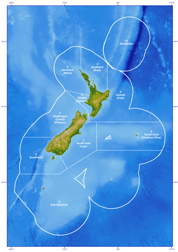
New Zealand Seafood Industry Council
New Zealanders are not the only people catching fish in the country’s Exclusive Economic Zone (EEZ), which extends between 12 and 200 nautical miles from the coast. Although most of the boats fishing in the EEZ are New Zealand-owned, 26 boats catching deepwater species bear other countries’ flags.
These boats are called foreign-chartered vessels (FCV), and are foreign-owned but leased by New Zealand companies in order to fish in the EEZ. The vessels catch deepwater species at least 12 miles from New Zealand coast, beyond the country’s territorial sea. Key FCV catch species include: hoki, ling, hake, barracuda, squid, jack mackerel, southern blue whiting, white warehouse, and silver warehou. FCVs bring in more than 90 percent of New Zealand’s squid and jack mackerel. That catch is later labeled as a "Product of New Zealand," according to Bloomberg Businessweek.
Recent Controversies Over the Use of Foreign-Chartered Vessels in New Zealand Waters
Of the 26 vessels, half are flagged to South Korea, seven to Japan, four to the Ukraine, and two to Dominica. The investigation by Schuster Institute for Investigative Journalism's Senior Fellow E. Benjamin Skinner and Bloomberg Businessweek focused on several Korean vessels, where crew members reported unpaid wages, violence, and threats, among other abuses.
In the past two years, the use of FCVs has been called into question by some commercial fishing companies, human rights activists, and academics. Concerns range from removing fishing industry jobs from the New Zealand economy to worker exploitation of the foreign crews. In contrast, supporters of FCVs have declared them not only useful but also necessary for the New Zealand fishing industry to remain profitable.
Much of the controversy began in August 2010, when the Oyang 70, an FCV owned and staffed by the Korean Sajo Oyang Corporation and operated by Southern Storm Fishing Limited, sank in New Zealand’s waters. In June 2011, 32 Indonesian crew members fled the Oyang 75 (owned and operated by the same companies), citing physical, mental, and psychological abuse, as well as non-payment of wages, according to a report from the University of Auckland Business School.
New Zealand Ministerial Inquiry
Banning of Foreign Chartered Vessels
On May 21, the New Zealand Industries and Labour ministers announced that foreign-flagged vessels will no longer be able to fish in New Zealand’s waters. Following the strongest recommendations of the ministerial report, the new rule places all vessels under the jurisdiction of New Zealand employment, health, and safety law. The rule effectively prohibits the arrangements between New Zealand fishing companies and foreign-chartered vessels discussed in “The Cruelest Catch” and other reports.
Sources
"Foreign Charter Vessels to be reflagged as NZ boats,” Checkpoint, May 22, 2012, Radio New Zealand
“Ban on foreign fishing vessels not enough–Labor,” May 22, 2012, TVNZ
“Crackdown on foreign fishing boats,” Paul Harper, May 22, 2012, NZ Herald
“Foreign fishing vessels to obey New Zealand law,” Tova O’Brien, May 22, 2012, 3 News
“Government action on foreign charter vessels welcomed,” Council of Trade Unions, May 22, 2012, Scoop.co.nz
“Foreign flagged fishing boats to be banned,” Tracy Watkins, Danya Levy and Michael Field, May 22, 2012, Stuff
In August 2011, the Ministry of Labour along with the Ministry of Fisheries (now part of the Ministry of Agriculture and Forestry) launched an inquiry into the use of FCVs. The inquiry asked if using FCVs protects New Zealand’s international reputation and trade access, maximizes economic return to New Zealand, and ensures that acceptable labor standards are applied on all fishing boats in the EEZ, regardless of the vessel’s flag. The inquiry’s report was released on March 1, 2012.
Selected Submissions to the Ministerial Inquiry on the Use of Foreign-Chartered Vessels
As part of the inquiry, the Ministries invited the public to submit written testimony or appear at hearings held across the country in October 2011. The Schuster Institute has selected those submissions that may be of interest to our readers. All of the written testimony may be found on the Ministry of Fisheries website.
Aotearoa Fisheries Limited
Arendale Limited
Dawson & Associates
Department of Labour
Human Rights Commission
Indonesia Human Rights Committee
Maritime New Zealand Union
Ministry of Agriculture and Forestry
New Zealand Fishing Industry Guild
New Zealand Seafood Industry Council
Northland Deepwater Limited
Sanford Limited
Seafood Industry Council
Sealord
Southern Storm Fishing Limited
Sullivan & Spillane
Talley’s
漁業者が減っても、消費者は困らない 05/19/09 (勝川俊雄公式サイト)
漁業関係者の多くは、「水産物の安定供給のために、赤字の漁業者を救済せよ」と主張している。
科学的にはじき出された許容量を上回る漁獲を、国が認める不可思議。当然、「乱獲を公認している」との批判があるが、水産庁は「TACをABCに沿って激減させると、漁業者は操業できず、倒産する。すると、水産物の安定供給が困難になる」という。
http://www.hokkaido-np.co.jp/cont/suisan-oukoku/14119.html
これ、全くの嘘。むしろ赤字の漁業者を維持することは、水産物の安定供給にとって、マイナスでしかない。
まず、日本の漁業者は余っている。足りないのは魚だ。横浜国立大学の馬奈木准教授の試算によると、現状の漁獲量を維持するのに必要な漁業の規模は今の15%。要するに85%も過剰な漁船を保持しているのである。
漁業者多すぎ、魚がいない。というのは世界的に共通している。1989年にFAOは世界の漁獲能力は、現状の漁獲を維持するために必要な130%の水準であると推定した。また、Garcia and Newton (1997)は、世界の漁船規模を現状の53%に削減すべきであると試算をしている。世界中で、漁船も、漁業者も余りまくりなのだ。不足しているのは、魚や漁獲枠である。「日本近海に魚があふれるほどいるけれど、漁業者がいない」という事態は、まずあり得ない。もし、そのあり得ない事態になれば、暇をもてあましている漁船を海外からチャーターして、水揚げをさせれば良いのである。
たとえば、NZでは、ロシアや韓国漁船をチャーターして、自国で操業・水揚げをさせている。海外のチャーターは、日本漁船よりも圧倒的に安価である。韓国船は非常にマナーが悪いらしい。NZの操業違反の8割は韓国漁船だとか。一方、ロシア船は、操業規則も守り、魚の質も良いとのこと。日本の漁業者が絶滅をしても、ロシア船をチャーターすれば、水産物の安定供給は可能だし、その方が、魚の値段は下がって、質は上がる可能性が高い。
漁業者減ると、全漁連や、水産庁は、とても困る。我々、水産学の研究者も、存亡の危機だ。しかし、漁業者が減っても、消費者への悪影響はほとんど無い。それどころか、メリットが多いだろう。自国の漁船を維持するより、外国漁船を単年契約で利用する方が、資源が減少したときに、禁漁等の思い切った措置がとりやすくなる。結果として、資源の持続性が保たれ、水産物の安定供給に寄与する。繰り返すが、水産物安定供給の生命線は、漁獲努力量ではなく、資源なのだ。
安定供給を口実に、現状の過剰な漁業者による、過剰な漁獲を正当化するロジックがいかにデタラメかは自明である。水産庁だけでなく、組合も、漁業者も、御用学者も、みんな言っている。安定供給を口実に、業並みの手厚い保護を勝ち取ろうとしているが、実に浅はかである。漁業者が多すぎるから魚が減るという当たり前の事実に、納税者は遅かれ早かれ、気づくだろう。補助金依存度を高めたら最後、補助金なしには存続できない産業になってしまう。そして、補助金はいつまでも出せる国家財政ではない。補助金おねだり作戦のもたらす結果は、漁業の延命ではなく、確実な破滅なのだ。
日本漁業の生き残る路は、①生産性を高めて経済的に自立すること、②日本の漁業者に任せた方が、資源の持続的利用に寄与すると示すこと、の2点であろう。実際には、全く逆の方向に進んでいる。自給率ナイナイ詐欺で、非生産的な現状を肯定する。そして、「零細な漁民がいるから、資源管理はできません」などと開き直るのである。今のままでは、消費者から見捨てられるのは時間の問題だろう。俺としても、沿岸漁業が少しでも多く残ればよいと思っているが、このままではどこまでも淘汰が進むだろう。組合も、行政も、研究者も、漁業が自立した持続的な産業として発展していくのを助けるために全力を尽くすべきである。そのことが、長い目で見れば、漁業に寄生する我々が存続する唯一の道なのだ。
下記の船舶はたぶん、船籍偽装だけでなく、国際条約違反の状態で運航していたと思う。
船籍偽装、長崎の海運業者を書類送検 02/19/07(TBS)
日本の船が参加できない北朝鮮の砂利運搬事業に参入するために、所有する船の船籍を偽装したとして、長崎の海運業者が海上保安庁に書類送検されました。
船舶法違反などの疑いで書類送検されたのは、長崎県佐世保市にある海運業者です。
この業者は、所有する日本船籍の砂利運搬船の船体に、パナマ船籍だと虚偽の表示をしていたほか、日本沿海しか航行できないこの船を北朝鮮と韓国の間の国際航路で使用していた疑いが持たれています。
この船は、北朝鮮の海で取れた砂利を韓国に運搬する事業に使われていましたが、この事業には日本船籍の船が使用できない取り決めになっていたため、船籍を偽装していたとみられています。
また、大阪市の海運業者も、この事業に参入するため船籍を偽装していた疑いが持たれていて、海上保安庁は、近くこの業者も書類送検する方針です。
罰金50万円以下なら違反したほうがお得!!
違反が見つかる確率も低い。これが現実だ!
船舶法違反:外国船籍を偽装、海保が業者捜索--大阪と佐世保 02/17/07(毎日新聞 東京朝刊)
北朝鮮から韓国に砂利を運ぶ際、日本船籍にもかかわらず海外の船籍であるように虚偽の表示や登記をしていたとして、海上保安庁が大阪市と長崎県佐世保市の業者を船舶法違反容疑などで家宅捜索していたことが分かった。第5、第7の両管区の海上保安本部は近く、両業者を書類送検する方針。
調べでは、佐世保市の業者は04年5月、所有船舶についてパナマの仮国籍を取得しただけで日本船籍のままなのに、船体にパナマ船籍の表示をした船舶法違反(罰金50万円以下)の疑い。大阪の業者も船籍を偽った虚偽の登記申請を行った公正証書原本不実記載(懲役5年、罰金50万円以下)の疑いが持たれている。
競争促進で、空の安全はどうなっているのか 06/11/08(Scope-NIU)
航空労組連議長 山口宏弥さん
山口) みなさん、こんばんは。航空労組連の議長の山口です。飛んでいるときは機長で、地上では議長と(会場笑い)両方やっているわけですが、今日は航空の安全の話を聞いて「もう飛行機には乗りたくない」と思われるかもしれませんが、そうならないために労働組合があるわけですからぜひ安心して聞いていただきたいと思います。
空の安全が脅かされているという点で、私たちは2つの点でとりくんでいます。1つは規制緩和の問題で、もう1つは民間航空の軍事利用の問題です。今日は規制緩和をめぐっての私たち航空連のとりくみの報告をさせていただきます。
1978年、アメリカのカーター政権の時代に、航空の規制緩和が始まったわけです。当時のアメリカの労働組合は、これを歓迎するという状況がありました。日本では1985年に始まりました。当時、運輸政策審議会がそれまで半官半民であった日本航空の民営化を打ち出し、90年代に入ると競争促進策がどんどん進められたわけです。今日は、どのような規制緩和がおこなわれてきたかを、パイロット、客室乗務員、整備部門、グランドハンドリングの職種ごとにみていきます。
■パイロット
◆交代なし12時間のフライトで乗務中断者が激増
これは、パイロットの乗務時間の制限のグラフです( 図表1 )。「12」とあるのは、交代なしでパイロットが12時間のフライトをするということを意味しています。92年までは、航空法で1回の着陸で10時間を越えれば交代要員が乗せるということでしたが、規制緩和で12時間まで、2時間も延ばしてしまいました。それを理由に日本航空では、労使間協定を破棄し、社内の規定を変更して、それまで9時間で乗員交代をしていたものを11時間まで延ばしました。東京からモスクワやロサンゼルスまで乗員交代なしで飛行するという状況が生まれてきたわけです。アメリカの航空法では交代なしの継続乗務時間は8時間と規定されています。
この結果、どういうことが起こったかと言いますと、 図表2-1 は、飛行機の乗務ができない(航空身体検査基準に一時的にも不適合となり乗務不可能)運航乗員の人数を示しているのですが、特に日本航空の場合は、フライト全体の4分の3が国際線ということもあって、これまでは、約2,500名の運航乗員のうち、毎月約80人が身体検査で不適格となり乗務ができないという状況でした。ところが93年に、規制緩和を受けて「勤務基準の改悪」がありました。一方で乗員不足から身体検査の基準が緩和されたのですが、疲労が蓄積していくなかで、2001年以降には100名を越え、現在でも140名~150名のパイロットやフライトエンジニアが乗務できないという状況が続いています。一般の健康診断と違いまして、航空身体検査という事で厳しい面がありますが、それにしても特に日本航空の場合には規制緩和とリンクして乗員の健康状況が悪化しました。 図表2-2 は全日空の乗務中断者の推移ですが、こちらは当時、国内線が中心でしたので、2003年の時点ではあまり影響が出てきていないと言えると思います。
◆実機訓練なしで、お客を乗せて初めてのフライト
乗員の規制緩和で一番大きな問題は、実機訓練をやめて、全部シミュレーターにしようという流れですね。特に訓練時間はどんどん短縮されています。例えば私は、ボーイング747で機長になって、MD11という飛行機に移ったときは、実機の訓練で離着陸を大体20~30回くらいやってから路線訓練に入ったのですが、3年前にB777に移ったときには、実記での訓練はなく、シミュレーターだけの訓練でした。シミュレーター技術の進化を理由に、実機はやらなくていいことを国が認めたからです。訓練費用もシミュレーターの場合は、実機の20分の1くらいの費用で済むからです。初めて旅客を乗せ定期便を操縦したときには、非常に不安な気持ちで操縦をしました。また、パイロットの場合は路線資格取得も緩和されました。これまでは、ロンドンならロンドン、パリならパリということで、空港ごとに資格試験を受けたのですが、規制緩和で、ロンドンの試験に合格すれば、パリや他のヨーロッパ路線は学科教育だけで資格がとれるようになりました。従来なら、路線のオブザーブなど研修をしてから乗務したわけですけれど、今ではビデオとか写真を見て飛ぶというように緩和されています。このような規制緩和は、パイロット個々人への大きな負担となっています。
■整備部門
◆朝の点検だけで飛行機が飛ぶ
図表3 は、1960年から2006年までの航空旅客者の推移を示しています。現在、国内線では1億人近い人が航空機を利用しています。国際線でも日本の離発着で5000万人くらいが利用しています。整備問題で、まず私たちが問題にしているのは、かつては整備部門は点検整備とは別だったものを、規制緩和で「実際に整備をした人間が、自分の整備した結果の点検もする」というように一人で二役の基準に変えてしまったことです。
また、朝札幌に行って羽田に帰ってきて、次に福岡に飛ぶという時、つまり飛行間点検についても、かつては2名で作業を行っていたわけですけれども、現在は1名で良いということになりました。今度は、それがもっと進み、ボーイング787という新機種では、朝の初便で整備士が点検をすれば、あとは1日中点検をしなくてもいいという制度です。整備士の目とパイロットの目は全く視点が違うのですが、後はパイロットが見て飛んでくださいということです。事故が多発しているボンバルディアは、いち早く整備士の飛行間点検を省略した飛行機です。これは、メーカーが飛行間点検をしなくていいということをセールスポイントにしていることも大きな問題です。
◆トラブルを生む整備の海外委託化
現在整備で一番大きな問題は、 図表4-1 図表4-2 にある海外委託整備です。日本航空や全日空といった航空会社本体が自社機の整備を全部やらないわけです。特に重整備、オーバーホールを海外でやっているわけです。グラフには細かくは出ていませんが、日本航空のドック整備、重整備の半分は中国やシンガポールで行われています。全日空も半分は海外で整備をしています。
この結果、例えば1996年に日本航空の整備士は4500人いましたが、10年後の2006年には2900人と、35%減らされている。全日空では1996年に3600人いた整備士が今は2700人、25%減らされている。そして、この一覧表( 図表5-1 図表5-2 )のとおり、中国での整備で、大変なトラブルがでているわけです。これは日本航空の例ですが、中国で整備をしてきたジャンボ機が試験飛行をすると、使った燃料と残った燃料の計算が合わないのです。例えば、10万リットル積んだところを5万リットル使ったのに、7万リットル残っているという表示が出るわけです。そんなに燃費が良くなったのかと思いましたら、実はタンクを開けてみたら整備のマニュアル―コピーが12枚、タンクのセンサーに絡まっていたのです。どういうことかといいますと、全くの素人がマニュアルだけを頼って整備をして、最後に、このマニュアルに「マニュアルをこの位置に戻す」と書いてあれば戻したのでしょうけれども、置き忘れてしまったわけです。そういった信じられないトラブルが起きているわけです。こんなことはいままでは考えられませんでした。
もう1つ海外整備の例を挙げますと、貨物室に消火液が出るノズルがあるわけですが、直接、貨物に消化液があたるようなノズルになっているのに、ノズルの上にパネルを張ってしまった。つまり噴射する出口を塞いでしまったわけです。このノズルが何の役割を果たしているかという教育ですらできていないわけです。教育の問題もそうですが、資格がない、大量の低賃金労働者で整備を行っているために、こういったトラブルが出ているというのが最近の特徴です。
◆客室乗務員―蓄積された経験引き継げない「契約社員」化
客室乗務員については、乗務員の数を減らしていくというのが流れになっています。94年に亀井運輸大臣(当時)が一喝したというエピソードがありましたが、アルバイトスチュワーデスの問題が社会問題となりました。その当時、正社員でない客室乗務員をどんどん入れてきたわけですね。労働組合が頑張り、3年たてば正社員にするという制度ができたわけです。 図表6 を見ていただくと、JALでは、3年たったら正社員ということですから、契約社員が10%です。全日空では、客室乗務員の労働組合活動がかなり後退しているために、35%が契約社員です。全日空に乗りますと客室乗務員3人のうち1人は必ず契約社員ということです。その平均勤続年数は5.6年です。日本航空は12.5年ですから、全日空は入れ替わりが激しく、JALの半分の勤続年数で辞めているような状況です。これが、北海道国際航空(AIR DO)とかスカイネットアジアなどになると、7割が3年以内の契約社員です。飛行機に乗りますと、経験の蓄積でしかわからないことを先輩から教わることが非常に多いわけですけれども、ほとんどが3年くらいで辞めてしまう。そういった状況が進んでいるわけです。 図表7 はアメリカの客室乗務員の平均的な経験年数と年齢のグラフですが、アメリカの場合には契約制度がありませんので、非常にきれいな年齢構成ができています。
◆グランドハンドリング―2日に1回は事故が発生
グランドハンドリングというのは、貨物の搭載やトーイングという飛行機の牽引、カウンター業務などを行う職種です。日本航空グループでいいますと約7,000人います。ところが、2005年には633人、2006年には584人、2007年には798人を採用しているのですが、全体の数は増えていません。毎年1割近い人が辞めて、入れ替わっているという状況です。 図表8 の右下にありますのが、グランドハンドリングの事故やトラブルの件数です。みていただくと分かると思いますが、2日に1回くらい、飛行機にぶつけたとか、車両同士がぶつかったとか、手をはさんだとか事故が報告されています。
■それでも進められる規制緩和
今、こういう状況に陥っているにもかかわらず、昨年政権を放り出した安倍首相は、6月22日に「航空会社の競争力向上のための環境整備」として「規制改革推進のための3ヵ年計画」を閣議決定しました( 図表9 )。その内容は次のようなことです。ひとつには、パイロット、機材、整備士については、アメリカのライセンスがあれば、自動的に日本に飛べるようにしたいということで、今その立法化がすすめられています。次に、パイロット、客室乗務員は同一会社でなくても良いということにする。パイロットはアメリカ人、客室乗務員はフィリピン人で良い。整備はすでに進んでいるように中国人でもできる。このようなシステムを採り入れようということです。今まではパイロットと客室乗務員は同じ会社でなければならないといった規定があったのですが、それを取っ払って、3月31日にその規定をなくし、パイロットと客室乗務員が別会社でも飛べるようにするという指針を出しました。3番目には、在留資格の緩和ということですが、要するに日本の航空の労働市場を外国に明け渡すというようなことを進めようとしているわけです。私たちは、これに強く反対をしております。
■規制緩和の問題にとりくみ、連帯する日米の航空労働者
この 集合写真 をご覧ください。アメリカのIAM、国際機械工・航空宇宙産業労働組合―60万人くらいの組織で、18万人の航空の従事者ですが、その航空部門の副会長がアメリカの上院の委員会で証言しました。アメリカでも規制緩和で航空機のトラブルが非常に多いのです。アメリカでもこの5年間のうちに30%~60%、海外での重整備が行われている。その結果、逆噴射装置を逆に取り付けたり、操縦のためのコントロールケーブルを逆につけるようなトラブルが発生しています。IAM会長は私たちに、「規制緩和とは、安全と雇用の破壊だ。アメリカでは、中国製の玩具の飛行機は、塗料の問題で赤ちゃんに非常に有害だ、と連日マスコミで報道しています。ところが人間の乗る飛行の整備が中国やその他の中南米で行われても、まったくそれは報道されない。企業側がそういう報道を抑えている、スポンサーが強いのだ」ということを言っていました。規制緩和の問題は日本だけでなく、アメリカの労働者も同じですね。私たちと同じような課題にとりくんでいるようです。昨年12月に訪問したのですが、情報交換をしながらこの問題をとりくんでいるというのが現在の状況です。
話は変わるが、飛行機のパイロットの資格を不正に取得するケースが存在するらしい。中国では200人の中国人パイロットが不正にパイロットの資格を取得し、ロシアやインドでも
不正にパイロットの資格を取得したケースがあるようだ。発覚はどちらのケースも飛行墜落事故の調査で発覚。LCCでこのような問題を取り上げないが、
運が悪ければ事故に巻き込まれる可能性はある。
中国パイロットの方言、誤解招き当局が排除 08/30/14(日本経済新聞)
中国の航空当局である民用航空局は方言の強いパイロットの排除に乗り出した。管制官が理解できなかったり、誤解したりする例が相次ぎ、危険だと判断した。2016年1月以降は標準語の「普通話」をベースとした中国語能力試験の4級に合格しなければパイロットの資格試験を受験できなくする。既に資格を持つパイロットも、強いなまりを改善できなければ地上職に配置転換する。
政府系英字紙チャイナ・デーリーが伝えた。中国には56の民族と80を超す方言がある。中国政府は自らを多民族国家と位置づけ「民族団結」を呼びかけているが、航空安全においては背に腹は代えられない。
例えば管制官が「問題はありますか」と尋ねると、普通話では「没有(メイヨウ=問題ない)」と答えることが多い。これが四川語になると「没得(メイデイ)」になる。「メーデー」は「助けに来て」という意味の国際的な遭難信号であり、紛らわしい。
さらに北京、上海など国際都市の空港に降り立つ際には管制官とのやりとりは英語になる。英語の発音も厳しく監視していく方針だ。(大連=森安健)
韓国人パイロット、エンジン警告無視で旅客機離陸 06/15/14(ZAPZAP!)
安全性に対する認識の低さが指摘される韓国でまた新たな問題が発覚しました。韓国国土交通部は今年4月、韓国のアシアナ航空B767型機について、エンジントラブルを示す警報が出ていたにも関わらす離陸し目的地まで飛行したとし、運航停止を含む処分を言い渡しています。
韓国の聯合ニュースによると今月11日、韓国国土交通部の発表としてアシアナ航空株式会社に対し2000万ウォン(約200万円)の罰金、及びサイパン路線の7日間の運航停止、韓国人パイロットに対し30日間の資格停止を言い渡したと報じています。
韓国国土交通部によると2014年4月19日、韓国ソウル近郊の仁川国際空港からサイパン行きのアシアナ航空のB767型機について離陸前に2基あるエンジンのうち1基について故障を知らせる警告が出ていたにもかかわらず離陸を強行。そのまま目的地まで飛び続けたとしています。
韓国国土交通部は「エンジンの問題を知りつつ運航を続けたことは、運航安全ルールの重大な違反だ」とし今回の処置を言い渡しました。
アシアナ航空株式会社は2013年にサンフランシスコ国際空港の滑走路手前に着陸し3名が死亡する事故を始め過去3度の死亡事故が発生しています。
無資格で操縦席に座っていたベトナム航空韓国人パイロット
朝鮮日報によると2011年10月、ベトナム・ホーチミンから釜山・金海に向かっていたベトナム航空所属の旅客機「エアバスA320」の副機長として操縦席に座っていたのは無資格の韓国人パイロットだったと報じています。これは同機が同年4月26日に着陸に失敗するという出来事がありベトナム航空が調査した結果分かったものです。
韓国人はベトナム航空に就職する際、東南アジアのほかの航空会社で680時間、「A320」で飛行したと記載した書類を提出していたものの飛行履歴書は職印と署名を偽造して作成したものだったことが後に明らかになりました。
この韓国人は発覚した2011年10月に姿をくらましています。
「パイロット資格」乱発する韓国軍の恐ろしき“訓練偽装”…セウォル号事故後も相次ぐ不祥事・隠蔽発覚 (1/6)
(2/6)
(3/6)
(4/6)
(5/6)
(6/6) 06/05/14 (産経新聞)
客船「セウォル号」沈没事故での救出活動をめぐり、政府や海洋警察とともに大きな批判を浴びた韓国軍だが、客船事故後もトラブルや不祥事が相次ぎ、国民をあきれさせている。戦闘機はミサイルを落とし、20億円の自慢の無人偵察機は墜落。空軍基地の滑走路も手抜き工事で使用停止に。さらに、飛行時間が足りなくても「機長」の資格を与える訓練擬装が過去何年にもわたって常態化していたことも発覚。大事故の反省を生かすどころか、不正は底なしの様相を見せている。
(岡田敏彦)
ミサイルが落下、そして発射され
聯合ニュース(電子版)などによると、セウォル号事故の2週間後の4月29日に忠北清原にある空軍基地の滑走路で、離陸しようとしていたF-4ファントム戦闘機に搭載されていたミサイル1発が機体から外れて滑走路上に落下した。これだけでも大問題だが、「ミサイルは機体から外れた衝撃で一部破損した」とする軍の発表が虚偽だったことが分かり、再び軍批判が沸騰する事態となった。
実はミサイルの推進装置(ロケットモーター)の部分が、滑走路から約2・3キロ先の地点まで飛んでいたことが明らかになった。つまり、ミサイルはただ落ちたのではなく、その後「発射」されていたのだ。
軍では当初「転がった」などと説明していたが、2キロも転がるミサイルがあるわけもなく、韓国マスコミは「誤射じゃないのか」と追及。その結果、軍はようやく「パイロットがミサイルを発射しようとしたわけではなく、発射の電気回線がショートした」と公表した。
またも整備不良が原因の事故だったわけで、空軍の対応については朝鮮日報などが「意図的に事態を縮小・隠蔽(いんぺい)しようとしたのではないか」と報じている。
無人偵察機は墜落
さらにこの事故の翌日の5月1日には200億ウォン(約20億円)かけて開発した陸軍の無人偵察機「ソンゴルメ(隼)」が京畿道楊州市近郊の山に墜落する事故が起きた。中央日報(電子版)などによると、ソンゴルメは全長約4・8メートル、全幅約6・4メートル。時速150キロで5時間近く滞空でき、光学センサーで数キロ離れた場所を偵察できる性能があるが、制御を失い墜落したとされる。
朝鮮日報(電子版)によると、国防部の関係者は「冬場に凍った地面が春になって緩み、工事区間に亀裂が生じた可能性がある」と指摘。凍って固くなっただけの軟弱地を地盤改良せず、表面だけを舗装工事していた疑いがある。国防部は業者の手抜き工事の可能性があるとみて調査している。
マニュアル・規則が守れず
ちなみに韓国世論は怒りやあきれを通り越し、もう諦めたかのような反応で、ネット上には「セウォル号事故では、(海面に)落ちなけれなならない救命ボートが落ちなかったのに、軍では落ちてはいけないものばかり落ちる」と、皮肉るような書き込みも見られた。
韓国内ではセウォル号沈没事故で「韓国のレベルは落第点、三流国家のものだった」(中央日報)、「最初から最後まで間違えた」(現地誌ハンギョレ電子版)など自虐報道が相次ぎ、「すべての部門で各自が『いい加減な』慣行から抜け出すために気をしっかりと持たなければならない」(中央日報)など反省や戒めの声も盛んに聞かれた。が、そうしている間にも軍ではトラブルが相次いでいたことになる。
これまでも欠陥工事でマンホールが陥没して戦闘機が主脚を落としたり、整備ミスで旧式戦闘機が次々墜落したりとトラブルは絶えなかったが、技術的な未熟さを別にすれば、これらは練度(訓練)が足りないことから起きたミスがほとんどだ。しっかりマニュアルを読み、規則を守れば起きなかった事故は多い。
だが、練度不足よりも恐ろしい事実が明らかになった。
空軍の練度を推し量る一つの指標であるパイロットの総飛行時間は、年間約130~140時間。約200時間の米軍や英国、180時間の日本(いずれも諸説あり)と比べると少ないが、北朝鮮(20時間)や中国(30時間)とはケタ違い。この数字を見ればしっかり訓練しているように見えるのだが、実はこの数字が全く信用できないことを韓国KBSテレビが報じた。韓国空軍は過去12年にわたって、虚偽の飛行時間を記した証明書を発行してきたというのだ。
偽装の常態化
韓国空軍では飛行訓練を終えた後、コンピューターに飛行時間などのデータを打ち込んで管理しているが、今回発覚したのは“水増し”などといった生やさしいものではない。機長や副操縦士、航法士、教官、学生などを区分しないまま、すべて「機長」として証明書を発行していたのだ。これは直接操縦せず、横に座っていただけの乗組員にも離着陸回数や操縦回数が実績として与えられることを意味する。操縦していなくても、操縦した経歴が与えられるのだ。
訓練擬装が行われる背景として指摘されたのが、除隊後の就職活動だ。軍を離れて民間で再就職するとき、パイロットの肩書があれば有利。飛行時間が多ければ民間航空会社への就職も可能だ。そうした事情から偽装が常態化しているという。
韓国KBSテレビによると、航法士(ナビゲーター)として輸送機に乗っていた人物が、機長として2600時間を飛行したとの軍の証明書をもらい、機長の資格を持って東南アジアの航空会社に就職したという。民間旅客機のパイロットに再就職した人物が、実は機長の操縦を横で見ていただけだった-という空恐ろしい事態が起きているのだ。
とはいえこの擬装、空軍の軍人にとっては秘密の利権のようなものだという。特権に執着する、そんな軍の慣行をどう考えればいいのだろう。
訓練していなくても訓練したことになる隊員。それと同じく、整備していなくても整備したことになるという悪しき慣行が、連続する事故の原因ともいえる。韓国では海洋警察の解体が決まったが、軍も一度解体して出直した方がいいのかもしれない。
ロシアに漁船不正輸出、容疑の2人逮捕 北海道警 11/07/12(日本経済新聞)
北海道警函館中央署は7日までに、中古漁船をロシアに不正輸出したとして、水産貿易会社「大和船商」の社長、大西善範容疑者(60)=札幌市西区山の手3条9=と従業員、宮下省吾容疑者(55)=同市西区発寒7条7=を船舶法違反などの疑いで逮捕し、同社を家宅捜索した。
逮捕容疑は2010年12月から昨年4月、船舶法で定められた国の許可を得ずに中古マグロはえ縄漁船をロシアの漁業会社に譲渡し、所有者を大和船商と偽った書類を経済産業省に提出してロシアに不正輸出した疑い。
函館中央署によると、漁船は宮城県石巻市の漁業会社から買い付け、約1億円で譲渡した。
函館中央署は、08年から昨年までロシアの同じ漁業会社に逮捕容疑を含め漁船8隻を不正輸出し、少なくとも約1億2千万円の利益を得たとみている。〔共同〕
Russian plane crash investigators probe fake pilot licenses 12/06/13 (RT News)
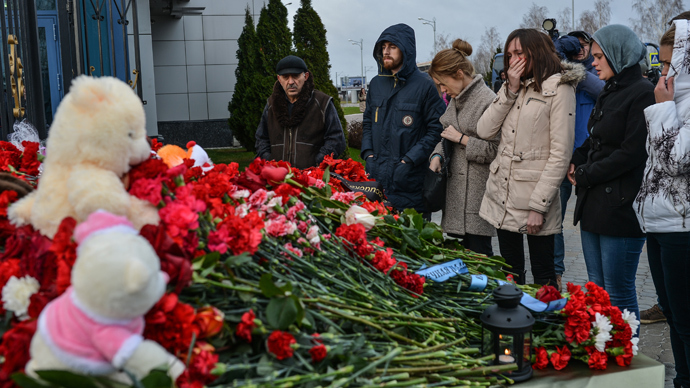
Kazan residents lay flowers at the entrance to Kazan international airport in memory of the victims
of Tatarstan Airlines' Boeing 737 crash. (RIA Novosti / Vladimir Astapkovich)
Russian investigators are searching the Federal Aviation Agency to determine whether some pilots received fake licenses. The investigation was sparked by a plane crash near the Russian city of Kazan last month that killed 50 people.
Investigative Committee spokesman Vladimir Markin said in a statement Friday that investigators believe some pilots working for Russian airlines received “fake commercial licenses” in centers certified by the aviation agency.
There are currently over 100 pilot training centers in Russia, and Markin believes the issue of dubious licenses is “primarily concerned with smaller airlines.”
The probe follows the November 17 crash near the southern city of Kazan which killed all 44 passengers and six crew members aboard, including Tatarstan President Rustam Minnikhanov’s son Irek and regional Federal Security Service department head Lt. Gen. Alexander Antonov.
Crash investigators said the pilot of the Tatarstan Airlines Boeing-737 had aborted a first attempt to land. During his second attempt, he pushed the steering column forward, sending the plane into a nosedive that brought the plane crashing down into the tarmac.
“The plane’s captain, Rustem Salikhov, was a qualified flight navigator, and then he supposedly obtained certification as a commercial pilot from one of the aviation training centers licensed by the Federal Aviation Agency,” said Markin, whose agency is often likened to the FBI.
"Investigators continue to look at the circumstances in which the crew of the crashed jetliner was trained," Markin said. "The investigators have doubts about the legality of the activity of the said aviation training center, which was liquidated."
Markin said investigators would search departments in the Federal Aviation Agency to confiscate documents related to the training centers, and would also question managers at the flight regulator.
The CEO of Tatarstan Airlines, Aksan Giniyatullin, was fired as a result of the crash, the republic’s ministry of transportation said Tuesday.
The Federal Aviation Agency on Wednesday recommended that the regional carrier have its license revoked after a post-crash probe revealed some of its staff were overworked or inadequately trained.
So far, no criminal charges have been filed over the crash.
サンフランシスコ航空機事故、機体や施設の問題も調査しなければ 07/26/13(東亜日報)
国際航空運送協会の統計調査によると、昨年の航空機事故は250万回の飛行のうち1回だった。これは、航空機が人類が作った運送手段の中で最も安全な手段であることを示唆する。しかし、航空機事故は発生すれば大事故につながる可能性があるため、事故原因を徹底的に分析する必要がある。したがって正しい事故分析のためには、すべての項目を並べて、事故と結びつく要素や項目を探さなければならない。
英国の心理学者、ジェームズ・リーズンの「スイスチーズ・モデル」はこのような航空事故の原因を多角的に分析できる理論だ。このモデルによると、事故は1つの段階だけのミスで発生するのではなく、深刻でない事件が連続したことによる結果ということだ。すなわち、航空事故は操縦士の過失、空港施設の不備、航空機の欠陥、管制官の不注意など、様々な段階の失敗が合わさった結果と見ることができる。
米国家運輸安全委員会(NTSB)のデボラ・ハースマン委員長も当初は、「最終調査結果を発表するのに1年以上かかるだろう」と明らかにした。しかし、ハースマン委員長は11日(現地時間)、サンフランシスコで開かれた記者会見で、「現在まで調べた結果、エンジンと自動航法装置、飛行指示計器、オートスロットル(自動速度維持装置)の作動は正常だった」と明らかにした。ハースマン委員長は、事故発生から一貫して機体の欠陥や異常はなく、操縦士の過失に重点を置いた立場を固守した。さらに米国のメディアは、操縦士の名前を嘲弄し、操縦士のミスだと報じた。
そのうえ、国内の一部メディアが事故機を操縦した副機長がボーイング777の運航経験が50時間に満たたないことを強調して、操縦士の経験不足で事故が発生したと報道したが、これは本質から外れている。操縦士に機種の変更は頻繁なことであり、世界的に機種変更の手続きに大きな差はない。特に、韓国の航空安全は2008年の国際民間航空機構(ICAO)の評価で世界最高水準と認められた。
NTSBが事故の原因だと見なさなかった航空機の欠陥、劣悪な空港の現実など、航空機の運航と関連した様々な要素を検討する必要がある。最新の航空機は性能が優れ、異常に備える様々な対策があるが、最近のボーイング社の相次ぐ事故を見ると、機体の欠陥を完全に排除することはできない。そのうえ、各国の操縦士協会が言及したように、サンフランシスコ国際空港は操縦士にはすでに悪名高い空港だ。
一般的な滑走路両側の安全地帯(安全な着陸のためのゆとり部分)が短かったという点や自動着陸誘導装置(Glide Slope)が作動しなかったという点も、事故発生の一つの原因になり得る。
人間が作った手続き、規定、法は完璧ではない。このすべての状況が複合的な原因として作用し、事故が発生したということは、米国の空港当局もNTSBも否定できないだろう。このうちどれか一つでも予防できたなら、事故は起きなかったかもしれない。
それゆえに残念なことだが、正確な原因調査を通じて再発を防止することが事故調査の目的だ。それが事故で犠牲になった乗客に対する礼儀だろう。
<アシアナ機着陸失敗>「事故機の操縦士、B777運航経歴わずか43時間」 07/08/13(中央日報日本語版)
アシアナ航空機のサンフランシスコ空港着陸衝突事故と関連し、国土交通部(国土部)は7日、「該当航空機を43時間しか運航していない操縦士が機長席に座り、操縦桿を握った」と明らかにした。
これを受け、国土部は今回の事故が社内教育訓練過程で発生した可能性もあるとみて現地調査に着手し、波紋が予想される。
7日の国土部とアシアナ航空によると、6日午前11時28分(現地時間)に米サンフランシスコ空港で事故を起こしたアシアナ航空OZ214便では、事故当時、イ・ガングク機長(46)が機長席に座っていたことが分かった。
イ機長はアシアナ航空運航インターン出身で、01年運送用操縦士の資格を取得し、これまで中型航空機A320などを9793時間運航しているが、今回事故が発生した大型航空機B777-200ERの場合、機種免許の取得後43時間しか運航していない。航空機は機種ごとに操縦法が異なるため、他の航空機を操縦するためには新しく機種免許を取得する必要がある。
航空操縦士は2人1組で航空機を運航する場合、原則的に機長席に座る操縦士が離着陸など操縦を担当することになっている。経験が多いイ・ジョンミン機長(46)は事故当時、非常状況で主導的に航空機を運航する役割を担当し、副機長席に座っていた。
これに関し、国土部の関係者は「出発から事故発生までイ・ガングク機長が機長席に座り、操縦桿を握ったことが確認された」とし「今回の飛行は“教官”のイ・ジョンミン機長と“教育訓練生”のイ・ガングク機長の教育訓練飛行として進行された」と述べた。
事故当時、サンフランシスコ空港28L滑走路は航法誘導装置が故障していたため、操縦士が手動で着陸を試み、事故が発生した。グライドスロープ(glide slope)と呼ばれるこのコンピューターシステムは着陸する航空機の下降経路を計算し、随時航空機に送る役割をする装置。当時サンフランシスコ空港の航法誘導装置の故障は世界航空会社にあらかじめ通知されていた。
尹永斗(ナユン・ヨンド)アシアナ航空社長(62)はこの日の記者会見で、「計器に異常が発生すれば本社に設置された指揮装備に自動で異常内容が表示されるが、今回は飛行機が着陸するまで異常信号がなかった」と述べ、機体の欠陥の可能性を排除した。
アシアナ航空旅客機は7日午前3時28分(日本時間)、米サンフランシスコ空港に着陸する際、地上に衝突した。飛行機には韓国人77人を含む乗客と乗務員の計307人が搭乗し、うち2人が死亡した。死亡したのは中国人女子高校生の王琳佳さん(16)と王琳佳さん(17)。負傷者181人(重傷49人)のうち5人は状態が深刻だ。
この日の事故は、飛行機の後部が海に接した空港の防波堤に衝突して発生したという。衝突した旅客機は滑走路を離脱し、翼・エンジンなどが胴体から分離破断した。事故機は乗客が避難した後、火災が発生し、機体の大半が焼けた。
米運輸安全委員会(NTSB)が事故原因の調査に着手し、韓国国土部はこの日午後1時、事故調査班を米国に派遣した。NTSBは事故機の機体からフライトレコーダー(別名ブラックボックス)を回収した後、精密分析のためにワシントンに移した。
India revokes licences of 14 'fake pilots' 03/25/11 (BBC News)

India's air safety record is generally good despite the scandals
The licences of 14 pilots have been revoked by India's aviation authorities as they were allegedly proved to be flying with fake documents.
A police probe found a flying club had issued "fake records" of their training sessions, India's civil aviation chief, Bharat Bhushan, told the BBC .
Earlier this month the licences of seven pilots were cancelled because of fake certificates.
The licences of 4,000 pilots are being checked for irregularities.
Mr Bhushan said that the police had discovered that a flying club in the northern state of Rajasthan had issued "fake records" of training sessions for 14 pilots.
"Based on the police complaints, we have revoked the licences of 14 commercial pilots," he said.
There have been a series of scandals involving Indian airline pilots recently - even though the country has a relatively good safety record.
Earlier this month authorities said that they were taking action against 57 pilots who had reported for duty drunk over the past two years.
Over the same period there have also been reports of pilots falling asleep while flying and pilots fighting with air crew.
The BBC's Soutik Biswas in Delhi says the massive growth in India's aviation sector over recent years has presented serious regulatory challenges to the authorities.
India now has the world's fourth largest number of domestic fliers after the US, China and Japan.
In China, 200 pilots were found with fake papers in 2008, according to the Centre for Asia Pacific Aviation.
Many Chinese Pilots Fake Their Credentials 09/11/10 (Epoch Times)

Chinese firefighters search the cockpit of the Henan Airlines ERJ-190 jet wreckage at the crashsite
in the northeast city of Yichun in remote Heilongjiang province early on August 25, 2010. A large
number of Chinese pilots falsify their flight credentials in order to land better jobs. (STR/AFP/Getty Images)
By Sophia Fang
Epoch Times Staff
China has earned a dubious reputation for being the source of unsafe, fake, and counterfeit products: from falsified athletes’ ages to toxic baby formula and tofu-cement school buildings—the list is long. Now, add to it fake flying credentials.
A recent plane crash in China has brought to light that a large number of Chinese pilots falsify their flight credentials in order to land better jobs, putting the public at risk in the process.
On Aug. 24, 2010 a plane crashed in Yichun in China’s northeastern Heilongjiang Province, killing 42 people. The crash has been called the largest aviation accident in China in recent years. An official explanation for the cause of the accident has not yet emerged, but the pilot was flying on fake credentials, according to Chinese reports.
The crashed airplane belongs to Henan Airlines, a subsidiary of Shenzhen Airlines. The pilot, 40-year-old Qi Quanjun, joined Shenzhen Airlines seven years ago after retiring from the air force. His attempt to obtain a commercial pilot certificate failed with Shenzhen Airlines, but he was successful getting it from Henan Airlines.
According to Hong Kong’s Apple Daily, Qi used to fly military aircraft, such as the already retired J-6 fighter plane and the K-44 training plane. Last March he started training as a commercial airline pilot for the EMB190, the type of plane that crashed in Yichun. His commercial flight history was only one year. The fatal flight to Yichun was Qi’s fifth flight as a commercial pilot, and his first flight to Yichun.
During a recent videoconference held by the Civil Aviation Administration of China (CAAC), referred to widely by Chinese media sources, a Shenzhen Airlines pilot was quoted as saying that Qi had failed to obtain his pilot certificate after an exam at Shenzhen Airlines’ headquarters: “It’s strange that he was granted the certificate after joining Henan Airlines,” he said.
Faking Credentials
The CAAC has identified more than 200 pilots with fake credentials in the past two years. Most of these pilots, as many as 103, are working for Shenzhen Airlines, accounting for one seventh of the company’s total number of pilots, an official of the CAAC said during the meeting.
The CAAC’s videoconference, where these revelations were made, was quoted widely in Chinese media reports on the topic, though the sources did not explain how they had obtained access to the meeting, nor details about when it was held.
Pilots also falsify their resumes during frequent job changes, or when changing careers from military to commercial airlines—though they are also put through a new round of tests before being able to fly again, China’s First Financial Daily quoted a high ranking official from a commercial airline company as saying.
Ticking Time Bomb
Li Jiaxiang, the director of CAAC, also claimed in the same videoconference that Shenzhen Airlines is not the only company that hires pilots with fake credentials. Other airlines, including the three major airlines—Air China, China Eastern Airlines, and China Southern Airlines—all have the same problem. Li described the phenomenon as the “melamine” of China’s aviation industry and a “time bomb” that can go off at any time.
The official response to the Yichun crash and the faked credentials has been that the “identified pilots” have stopped flying. As usual, however, the public is not convinced.
Internet users have expressed outrage that passengers’ lives have been put at risk due to regulatory system failings, and have argued that the issue is still being taken too lightly.
パイロット200人の経歴詐称明るみに 09/11/10(中国通信社)
(中国通信=東京)7日の新華社電子版によると、同日付の「北京晨報」は、パイロット200人の経歴詐称が明るみにでたが、民間航空の専門家は決して珍しくはないと語る、と次のように伝えている。
最近、全民間航空系列のテレビ電話会議で、民用航空局の関係者が明らかにしたところによると、2008年から09年にかけ、民用航空局が民間航空系列のパイロットの資格について全面調査を行ったところ、飛行経歴が事実と異なる、果ては飛行経歴をねつ造している者が200人余りにも上り、この200人余りのうち、深セン航空だけで103人に上り、これらのパイロットは経歴の偽造、あるいは経歴に虚偽の記入を行っていることがわかった。
このデータについて、記者は6日、何度も民用航空局の関係責任者に電話をしたが、いまだに確認は取れていない。深セン航空側は、このデータは政府筋が公表したものではないとしている。とはいえ、民間航空の専門家は、パイロットの経歴詐称は業界内では決して珍しいことではないと語る。中国民航管理幹部学院の法学客員教授張起淮氏はあからさまに語った。「民用航空局は既に一部の航空会社に関連の警告を出した。理由はパイロットの経歴偽造問題だ」。張教授の分析によれば、パイロットの経歴偽造には二通りある。一つは航空学校で不適格とされた学生が航空会社の試験を受けるケース。「これらの人々は往々にして飛行時間が不足しているが、利益を優先する航空会社は、彼らを繰り上げて飛行機に乗せ、パイロットにする」という。もう一つは、パイロット養成学校が学生のためにごまかすケースだ。この場合、訓練期間が短く、実際の飛行経歴がはるかに不足している。
国外では、パイロットの経歴詐称は極めて珍しい。張教授は「国外には多くの自家用機があるが飛行経歴を改ざんする者はごくわずかで、いったん発見されたら、それは犯罪行為である」と語る。このため張教授は、司法制度を完備して、航空会社に利益優先で不適格のパイロットを採用させないようにし、同時に民用航空局は管理を強化すべきだと提案している。
2008年と10年には、中国で相次いでオリンピックと万博という大規模なイベントがあり、これにより中国の民間航空業は12%から14%の速度で成長し、極めて深刻なパイロット不足を招いた。関係方面の予測によれば、2015年までにパイロットの不足は1・8万人にも達するという。これは今後数年、中国の民間航空は毎年2500人から3000人の新人パイロットを就業させないと、保有機材運航のニーズに応えられないことを意味している。
1人の適格パイロットを育てるには長い年月がかかる。中国では高校卒業後航空会社に採用され、そのあとみな航空学校或いは国外の訓練機関で学び、卒業後さらに所属航空会社の機種訓練を受けなければならない。1人のベテラン機長になるには、全過程で8年から10年かかる。
パイロット200人以上が経歴詐称、航空業界の安全調査を強化へ―中国 09/07/10(レコードチャイナ)
2010年9月6日付の第一財政経済日報によると、中国の航空会社統括機関・中国民用航空局(民航局)が国内の民間航空会社パイロットを対象に調査を行ったところ、200人以上が飛行時間などの経歴を詐称していることがわかった。
調査が行われたのは08年から09年にかけて。中国では航空輸送への需要が急速に高まっているが、その一方で、航空機の事故も増加しており、先月24日にも黒龍江省伊春市で河南航空機が着陸に失敗し、43人の死者を出した。
航空需要の急増にパイロットの育成が追いつかず、空軍パイロットが民間航空会社へ転職する際に、経歴を詐称するケースが多かったという。民間航空機のパイロットには多くの資格があり、飛行時間などの経歴や条件が操縦できる機種や航路・待遇などに大きく影響することが経歴詐称の一因となっている。
経歴の詐称がもっとも多かったのは深セン航空のパイロットで、経歴詐称や虚偽報告を行っていた者が103人にのぼった。なお、伊春市で事故を起こした河南航空は深セン航空の子会社である。
民航局では業界全体の安全体制についてさらに調査を進める。その調査対象はパイロットだけではなく、機長や教官・管制官・整備士・運行管理員などに広まる。このほか、ハブ空港以外への深夜のフライトを制限するなど、航空路線制限の措置も囁かれているが、今月1日に着陸時の事故のため営業一時停止となった華夏航空のある幹部は、「便数制限を行えば、客数増加とのバランスがさらに崩れる。それは機体の酷使などにつながるのでは?」と、新たな問題発生の可能性も示唆している。深セン航空はANA全日空のコードシェア提携航空会社。日本にも就航しており、成田~福州を週3便、関西~福州経由~深センを週4便運航している。(翻訳・編集/岡田)
次の更新まで続く。
安定的な国際海上輸送の確保のための海事政策のあり方について
(中間とりまとめ)平成19年6月 交通政策審議会海事分科会 国際海上輸送部会(国土交通省)
開けない人はここをクリック
参考サイト:
 フィリピンでの船舶による油流出事故ではISOの認定を受けていた検査会社の不正やフィリピン沿岸警備隊職員の汚職疑惑が表に出た。船齢が1年の船が実は船齢50年以上で建造された日から6か月間に4回もフィリピン沿岸警備隊職員よる検査を受けたにも関わらず、船が沈没して大規模な油汚染が発生するまで、問題ははっかくしなかった。システムが存在してもシステムが機能しなければ、不正は可能であることが部分的に証明されたケースだと思う。
フィリピンでの船舶による油流出事故ではISOの認定を受けていた検査会社の不正やフィリピン沿岸警備隊職員の汚職疑惑が表に出た。船齢が1年の船が実は船齢50年以上で建造された日から6か月間に4回もフィリピン沿岸警備隊職員よる検査を受けたにも関わらず、船が沈没して大規模な油汚染が発生するまで、問題ははっかくしなかった。システムが存在してもシステムが機能しなければ、不正は可能であることが部分的に証明されたケースだと思う。
![]() パラオ籍船、
パラオ籍船、 シエラレオネ籍船、
シエラレオネ籍船、![]() トーゴ籍船に登録されている船舶をターゲットにして船舶検査が行われるそうだ。これらの国籍の海運局は船主からお金さえ受け取れば、他の国籍の海運局が受け入れない船でも登録すると書かれている。これらの船籍船舶は危険で運航されるべきでないITFコーディネーターは言っている。データによると2年間でこれらの船籍に登録された100隻以上の船が放置されたそうだ。
トーゴ籍船に登録されている船舶をターゲットにして船舶検査が行われるそうだ。これらの国籍の海運局は船主からお金さえ受け取れば、他の国籍の海運局が受け入れない船でも登録すると書かれている。これらの船籍船舶は危険で運航されるべきでないITFコーディネーターは言っている。データによると2年間でこれらの船籍に登録された100隻以上の船が放置されたそうだ。
 シエラレオネ籍船、
シエラレオネ籍船、![]() トーゴ籍船に登録されている船舶が日本に頻繁に入港している。個人的には問題のある船は多いと思うが、
残念ながら日本のPSC(国土交通省職員)の検査は厳しくないので、出港停止命令はあまり受けないのが現状だと思う。
トーゴ籍船に登録されている船舶が日本に頻繁に入港している。個人的には問題のある船は多いと思うが、
残念ながら日本のPSC(国土交通省職員)の検査は厳しくないので、出港停止命令はあまり受けないのが現状だと思う。




























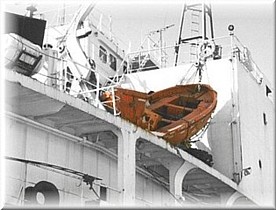
 パナマ船籍の「マリナ アイリス」が沈没!
パナマ船籍の「マリナ アイリス」が沈没! カンボジア籍船
カンボジア籍船 トーゴ籍船
トーゴ籍船 モンゴル籍船
モンゴル籍船 フィジ籍船
フィジ籍船 ベリーズ籍船
ベリーズ籍船 韓国客船 Sewol沈没
韓国客船 Sewol沈没


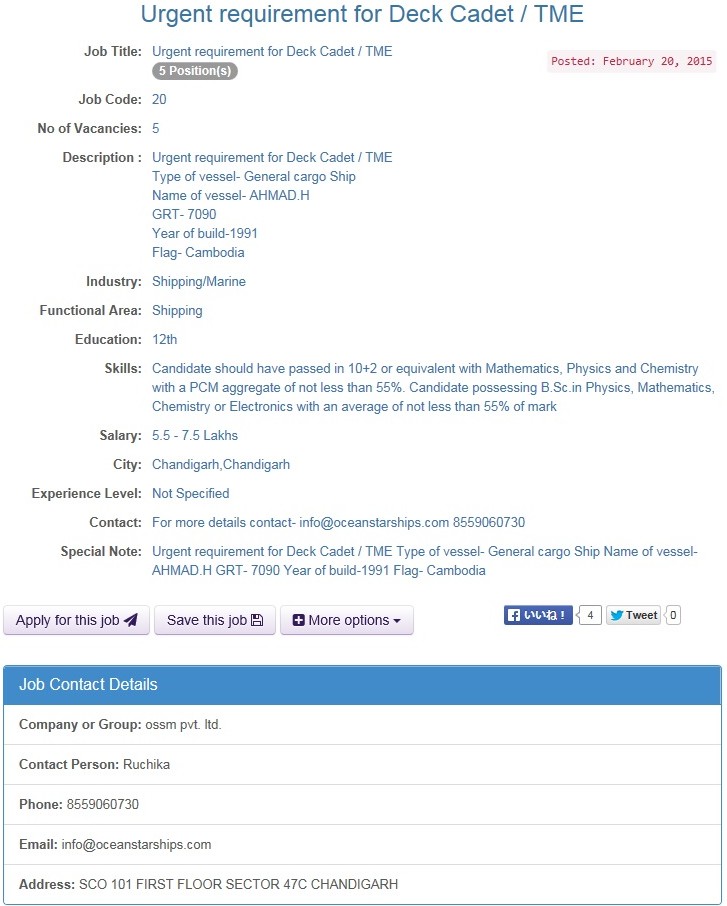 Urgent requirement for Deck Cadet / TME (Sirjobs)
Urgent requirement for Deck Cadet / TME (Sirjobs)